The 75 best TV shows on Max right now, according to our experts

- Share via
Lists, I have found, are not for the faint-hearted. And given HBO’s prime place in the history of TV’s most recent Golden Age, any list of the best shows on Max is liable to be a fraught endeavor: Do you prefer “The Sopranos” or “The Wire”? “Sex and the City” or “Enlightened”? And do you forgive “True Detective” for that second season? (Turns out the answer to the last one was “No.”)
Couple these foundational debates with the surprises that emerge from ranked-choice voting, and I am certain that what’s below will make people mad. Big mad. Even madder than our list of the best TV shows on Netflix. But here’s the thing: The real takeaway here is that Max has a very, very deep bench and that the top 10 in particular is bangers all the way down. What I suspect people will take issue with is the order, and that says a lot more about how we define greatness than the quality of the shows themselves. But I guess that’s an essay for another day. Happy streaming. — Matt Brennan
We surveyed The Times TV team to come up with a list of the 75 best TV shows you can watch on Netflix. As in, tonight.
For the record:
1:57 p.m. March 27, 2022An earlier version of this article said the Stonehenge era caveman in “Ghosts” is played by Nathan Byron. The actor is Laurence Rickard.
75. Lovecraft Country

2020 | TV-MA | 1 Season | Sci-Fi TV
Developed by Misha Green, based on Matt Ruff’s novel
That Misha Green’s series “Lovecraft Country” has something to say about the ordinary horrors of racism as well as the cosmic ones of fantastic fiction is mixed into its foundation. Matt Ruff, on whose 2016 novel the series is based — sometimes closely, sometimes loosely — was inspired in part by Pam Noles’ 2006 essay “Shame,” about the unbearable whiteness of sci-fi and the difficulties it presents to what she calls an “FoP,” as in, “Fan of Pigment,” and in its particulars by “The Negro Motorist Green-Book” and by James W. Loewen’s study “Sundown Towns,” as in “get out by.” The racism of H.P. Lovecraft, an influential writer of pulp fiction and weird tales, is well-known; indeed, it’s a point the characters explicitly discuss. Still, both Ruff’s book and Green’s series function as much a critique as celebration; the mere fact that the series’ heroes are all Black is in itself a riposte to the early 20th century author, spitting in his otherwise admired eye. (Read more) —Robert Lloyd
74. Our Boys

2019 | TV-MA | 1 Season | Crime TV Shows
Created by Tawfik Abu Wael, Hagai Levi and Joseph Cedar
A teen is abducted off a street in East Jerusalem. Time is of the essence if authorities hope to find him alive, and grainy surveillance footage is all they have to go on. The biggest hurdle, however, is the hardened predispositions of those watching the tape. An Arab views the recorded abduction and is sure the culprits are Jews; he can tell by the way they look. A Jew watches the murky images and theorizes that the men in question are Arabs; he can always spot an Arab by the way he walks. They see what they want to see, like the extremist abductors who saw a mortal enemy in the innocent 16-year-old they snatched, drove to the outskirts of the city and burned alive. HBO’s bold, gripping miniseries is based on real events from the summer of 2014 when three Jewish teenagers were kidnapped and murdered by Hamas militants. A nation on edge erupted into protests and riots, its loudest voices calling for vengeance. Within days, the charred remains of a new abductee, Arab teen Mohammed Abu Khdeir, were found in the Jerusalem Forest, enraging the Palestinian community. The 10-part drama follows Israeli authorities’ investigation into Abu Khdeir’s murder, exposing complex human stories on all sides of the tragedy with exceptional candor. The series also builds the case for how a never-ending cycle of revenge thwarted justice and sparked the 50-day Gaza war. (Read more) —Lorraine Ali
73. Dawson’s Creek

1998 | TV-14 | 6 Seasons | TV Dramas
Created by Kevin Williamson
Executive producer Kevin Williamson — and the characters he created for “Dawson’s Creek” — could use a cold shower. Williamson is behind mainstream television’s first series about sex. Utterly, totally, myopically and obsessively. Not doing it but talking about it and winking about it in double-entendres — endlessly. Which you could accept, perhaps, were it not for the protagonists of this hotblooded hour being just 15. One of whom is sleeping with his gorgeous English teacher in a sick, felonious liaison that is treated here merely as a quirky, titillating romance to snicker about, a sort of silly schoolboy crush. In “Dawson’s Creek,” the minors are anatomically fixated, and some of their elders are just as genitalia-minded. Even the zits here are sensual, the rationale being that the youth of this age are usually on hormonal overload and think about sex a lot. Generally true. But only about sex? (Read more) —Howard Rosenberg
72. Allen v. Farrow

2021 | TV-MA | 1 Season | Docuseries
Created by Kirby Dick and Amy Ziering
Is Woody Allen’s career finally toast?
The question has been asked frequently in recent decades, both in response to a midcareer slump and, later, as the #MeToo movement brought new scrutiny to his marriage to Soon-Yi Previn and allegations that he abused Dylan Farrow, his daughter with actress Mia Farrow, when she was a child.
HBO’s powerful four-part series “Allen v. Farrow,” from investigative filmmakers Kirby Dick and Amy Ziering, goes beyond the scandalous headlines and makes a compelling argument that Allen got away with the unthinkable thanks to his fame, money and revered standing in the world of film — and that a little girl never received justice. The documentarians pored over years of custody trial evidence, home movies, recorded phone conversations, photo exhibits and more, piecing together a harrowing picture of Allen as an abuser and master manipulator and Dylan as his silenced, disbelieved victim. They’re allegations Allen has long denied. But this time Dylan, now 35, is here to tell her side of the story. And it proves comprehensive, convincing and ultimately devastating. (Read more) —Lorraine Ali
71. Girls
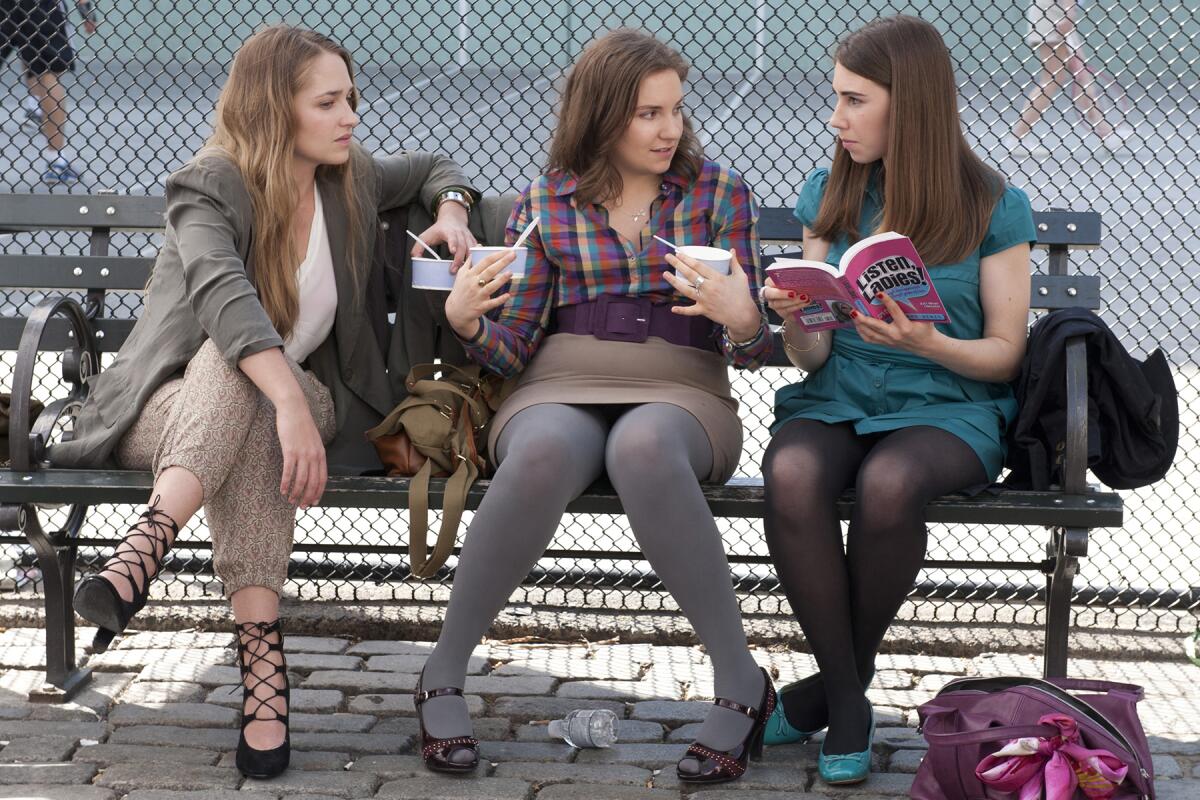
2012 | TV-MA | 6 Seasons | TV Comedies
Lena Dunham and Judd Apatow and Jenni Konner
“Girls” is a half-hour comedy, different, perhaps, in tone from other half-hour comedies of our acquaintance, but not so different in form and theme. It is about a quartet of young women who have formed an alternative family to see them through the transition from college to adulthood. Lovers, bosses, parents, even spouses may come and go and the women may wound each other in battles of competing self-interest, but the bonds of adult friendship remain sturdy, the primal definition of love. “Girls,” at its core, is just as sentimental and idealized a story as “Friends” or “Seinfeld,” two shows to which it actually owes a great deal. (Read more) —Mary McNamara
70. Rick and Morty
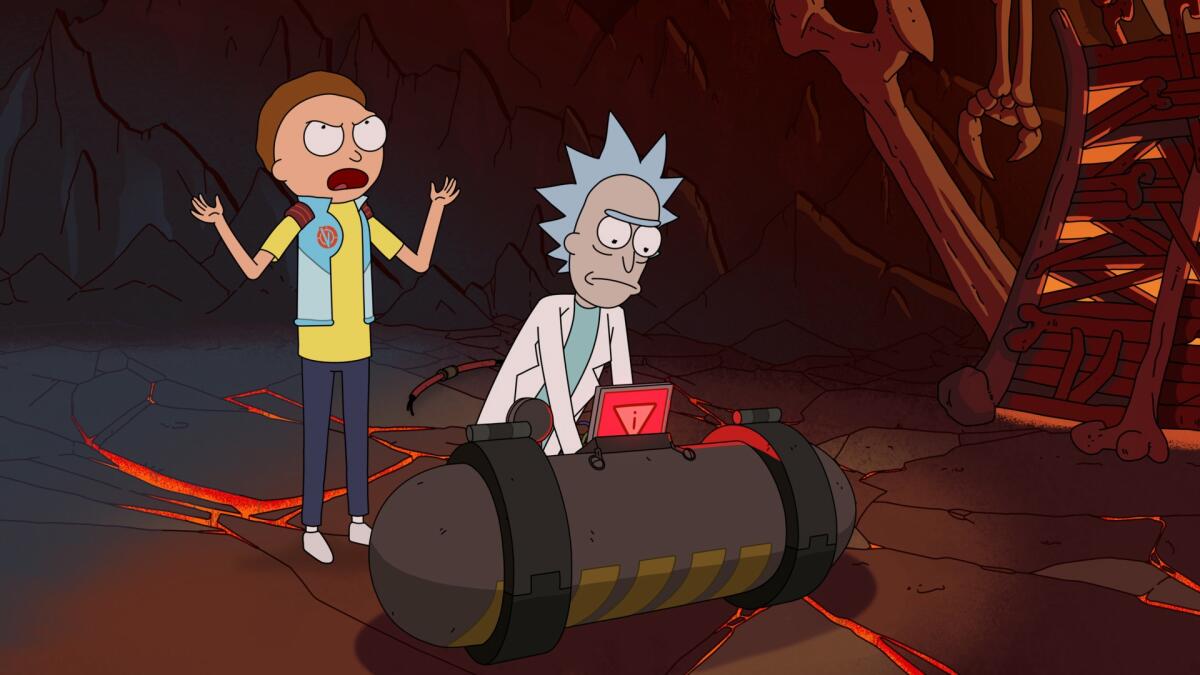
2013 | TV-14 | 6 Seasons | TV Comedies
Created by Dan Harmon and Justin Roiland
Dan Harmon and Justin Roiland’s animated series “Rick and Morty” revolves around mad scientist Rick (Roiland) and the family he has recently reconnected with: daughter Beth Smith (Sarah Chalke), son-in-law Jerry, granddaughter Summer Smith (Spencer Grammer) and grandson Morty (Roiland again). Each episode, Rick takes Morty (or another Smith family member) on a bizarro adventure reminiscent of “Doctor Who” but with twice as much swearing and infinitely more interesting alien high jinks. (Parent alert: As has been evident since the pilot episode, when Rick smuggled alien contraband in his rectum, “Rick and Morty” is definitely for adults.) But just because the main character burps out half of his lines like Foster Brooks, that doesn’t mean it’s simple. “Rick and Morty” is grounded in a “Star Trek”-centric love of scientific explanation. And the writing staff has yet to meet a sci-fi theory it didn’t want to thread into the show. (Read more) —Meredith Woerner
69. Pushing Daisies
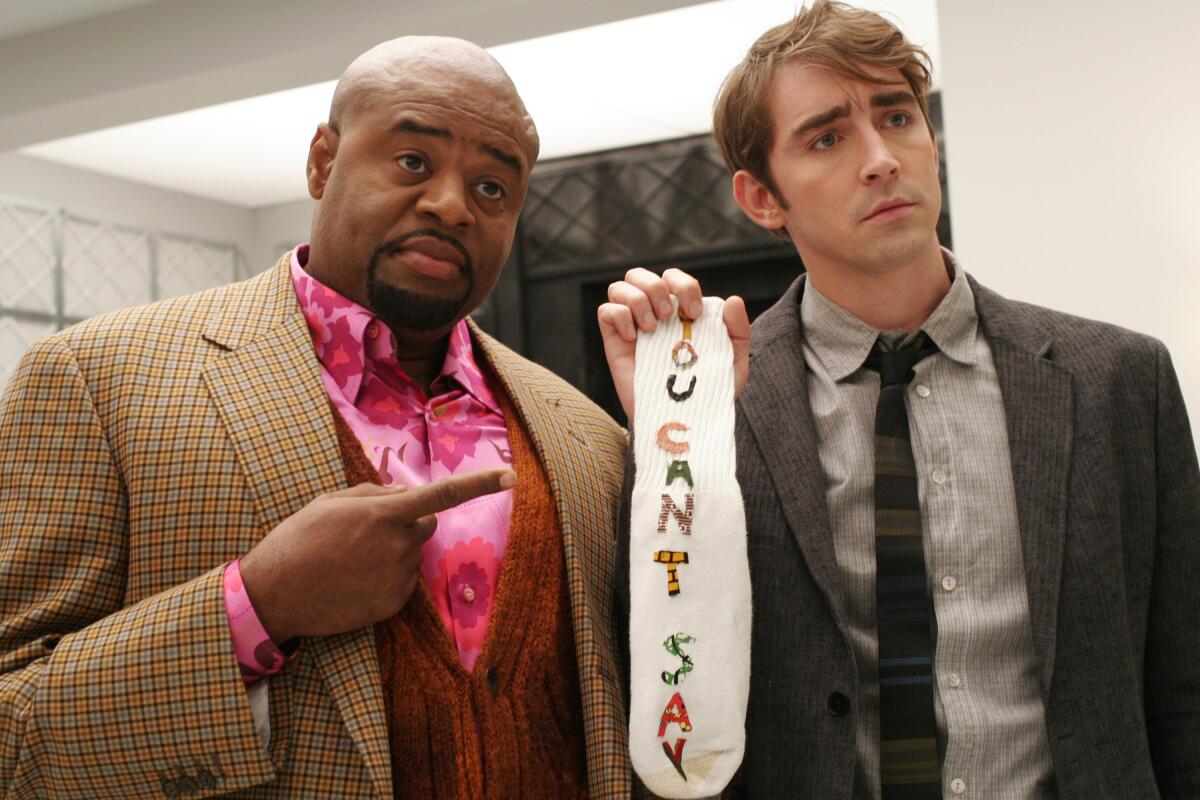
2007 | TV-PG | 2 Seasons | TV Comedies
Created by Bryan Fuller and Barry Sonnenfeld
“Pushing Daisies” is a lovely, toy-colored series about a man who can bring back the dead, with restrictions. There’s an old story at the back of “Pushing Daisies” — the one about Orpheus fetching Eurydice from the underworld. Forbidden to look back at her as they trudge Earthward, he does anyway, and she’s dead again. Whatever that is supposed to tell you about having your cake and eating it too or listening when the teacher talks, the tragedy of losing again what you managed extraordinarily to regain is clear and powerful enough. “Pushing Daisies” is a comedy, however, so the only redying dead will be the ones we don’t love. Created by Bryan Fuller, it is a close cousin to his previous creation “Dead Like Me,” about a girl who becomes a not-so-grim reaper, and his co-creation “Wonderfalls,” about a girl who receives cosmic instructions from animal statues. (Read more) —Robert Lloyd
68. Looney Tunes
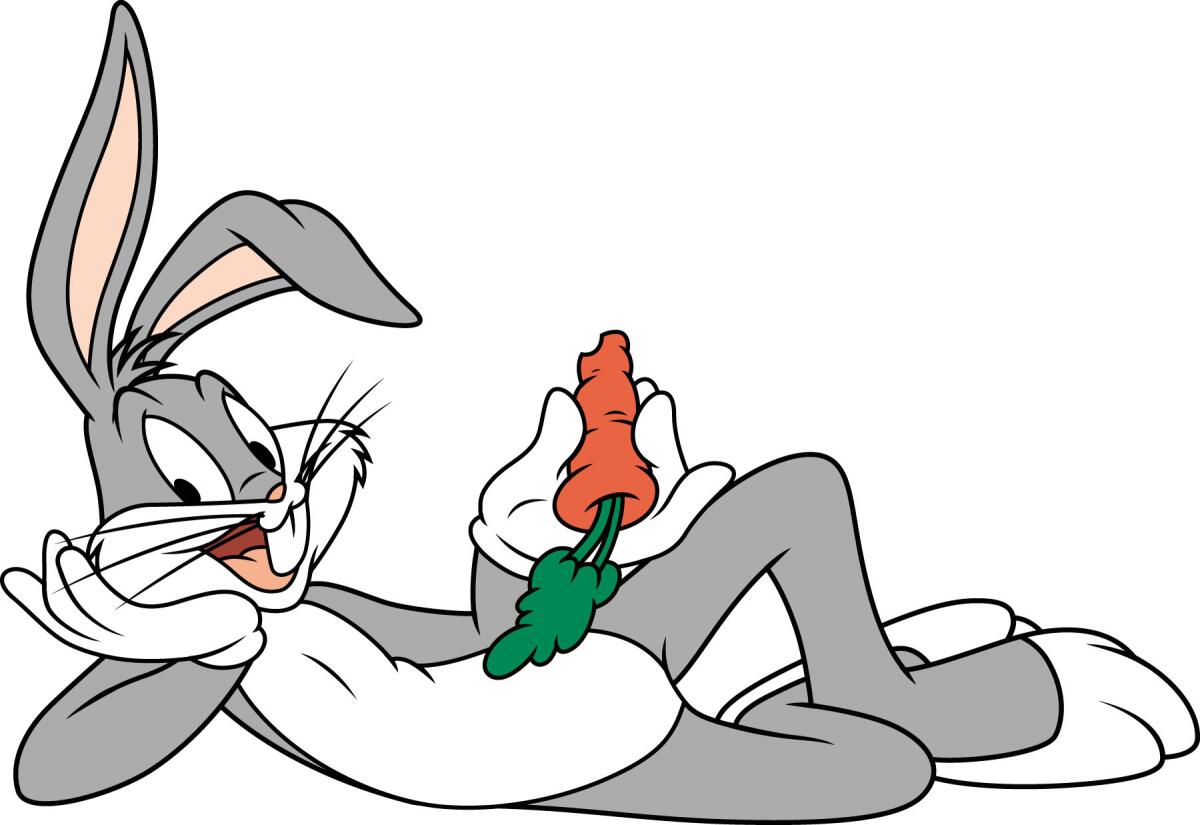
1931 | TV Rating: Various | Numerous series and shorts | Kids’ TV
Creators include Chuck Jones, Friz Freleng, Bob Clampett, Tex Avery and Frank Tashlin
Looney Tunes have always been a different breed of animal, or rather animals, from Walt Disney’s collection of animated favorites. Disney’s Mickey Mouse, Minnie Mouse, Donald Duck, Pluto, Goofy, Bambi, Dumbo and those 101 Dalmatians are adorable, sweet, cute, lovable and beloved. Who didn’t cry when Bambi’s mother died? But no one has ever cried at a Looney Tunes character unless it was tears of laughter. No one has ever said, “Bugs Bunny ... isn’t he sweet?” That’s because those wacky Looney Tunes — Bugs Bunny, Daffy Duck, Elmer Fudd, Porky Pig, the Road Runner, Wile E. Coyote, Yosemite Sam, Tweety and Sylvester, Pepe Le Pew and Speedy Gonzales — are irreverent, cynical, slapsticky, violent, outrageous and crazy. The Looney Tunes gang is embedded in our popular culture. Bugs was voted “best puppet or cartoon character” in a 1985 People magazine Readers’ Poll. Such Looney Tunes phrases as “What’s up, Doc?” and “That’s all, folks” are part of our vocabulary. (Read more) —Susan King
67. Boardwalk Empire
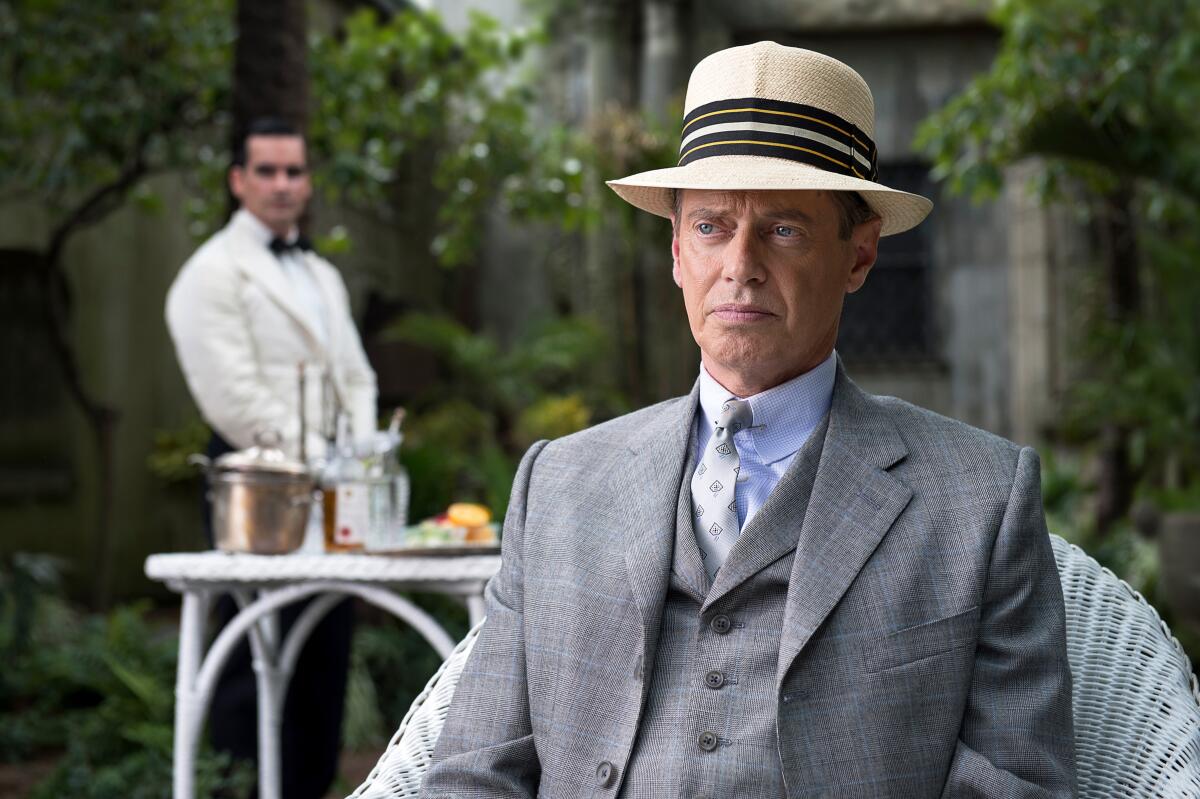
2010 | TV-MA | 5 Seasons | TV Dramas
Terence Winter and executive producer Martin Scorsese
The story opens in 1920, literally on the eve of Prohibition, as Atlantic City treasurer and political kingpin Enoch “Nucky” Thompson (Steve Buscemi, Irish for the occasion), lays out his plan for keeping his city wet while the country goes officially dry. Atlantic City was the Las Vegas of its time, and this is in many respects the origin story of the shadow world to which both executive producer Martin Scorsese and writer Terence Winter have already devoted much energy. Thompson is based on the real-life Enoch Johnson, the name change perhaps indicating that — in spite of the presence of such gangland household names as Lucky Luciano (Vincent Piazza), Al Capone (Stephen Graham) and Arnold Rothstein (Michael Stuhlbarg) — this is not to be taken as docudrama but as historical fantasia, a meditation on big characters in changing times. There’s no question that this was one of the most interesting and accomplished shows of its debut season, though it’s also true that there was not much competition that year. (Read more) —Robert Lloyd
66. Joe Pera Talks With You

2018 | TV-PG | 3 Seasons | Reality TV
Created by Joe Pera
Briefly stated, this is a show about a soft-spoken, round-shouldered middle school choir teacher in Michigan’s Upper Peninsula who offers “presentational” videos — they have titles like “Joe Pera Takes You to Breakfast,” “Joe Pera Answers Your Questions About Cold Weather Sports” and “Joe Pera Gives You Piano Lessons” and involve talking to the camera. But everything veers into something quite different, and often quite profound. Sincerely interested in ordinary human rituals and the wonders of nature — the show encourages an attitude of appreciation — it’s a comedy I am just as liable to watch with tears streaming down my face as laughing. Most episodes are cartoon-length and somehow packed with events while never breaking into so much as a trot. (Read more) —Robert Lloyd
65. The Boondocks
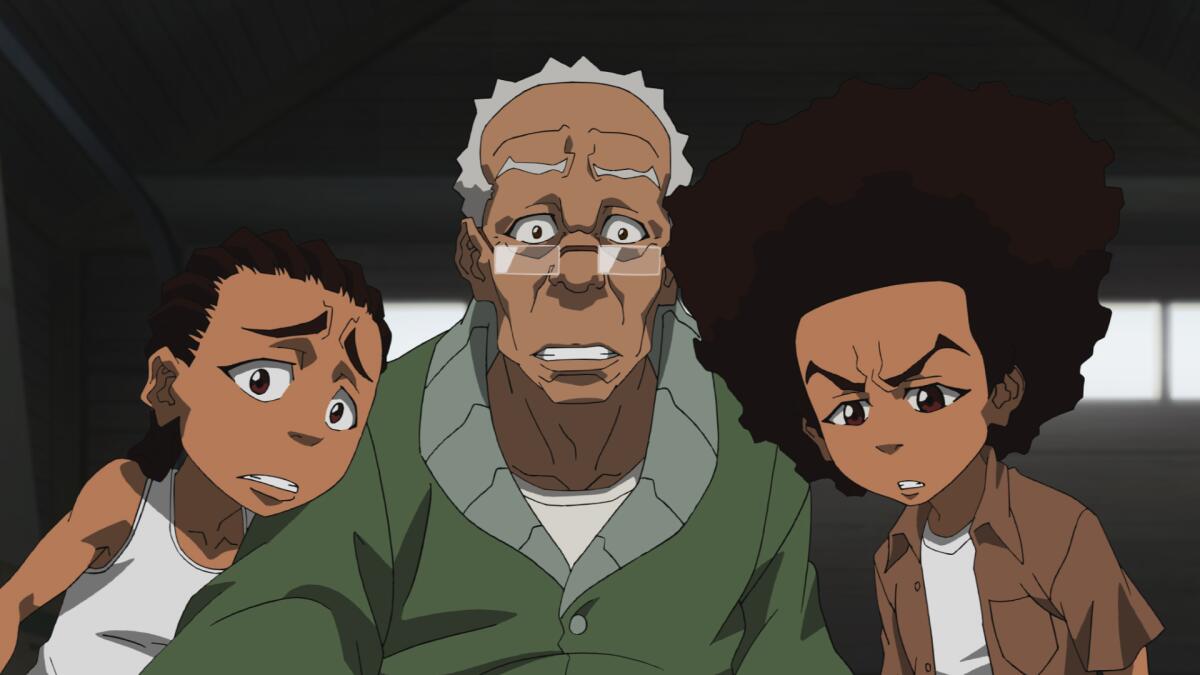
2005 | TV-MA | 4 Seasons | TV Comedies
Created by Aaron McGruder
“The Boondocks” is a vicious animated satire that sends up both the particularities of Black cultural life and also the clueless, sometimes vindictive outsiders who misunderstand and denigrate it. Based on the daily comic strip of the same name that ran 1996-2006, “The Boondocks” became known during its first season for its strident irreverence. Ironically, it earned a 2006 NAACP Image Award nomination, which undoubtedly delighted its creator, Aaron McGruder, who skewers the Black establishment just as much as any of his other targets. That the show does so primarily out of the mouths of young children — brothers Huey and Riley Freeman, the former a radical, the latter a tough-in-training — has made the show only more subversive and less comfortable. The tensions it highlights are omnipresent. (Read more) —Jon Caramanica
64. Olive Kitteridge
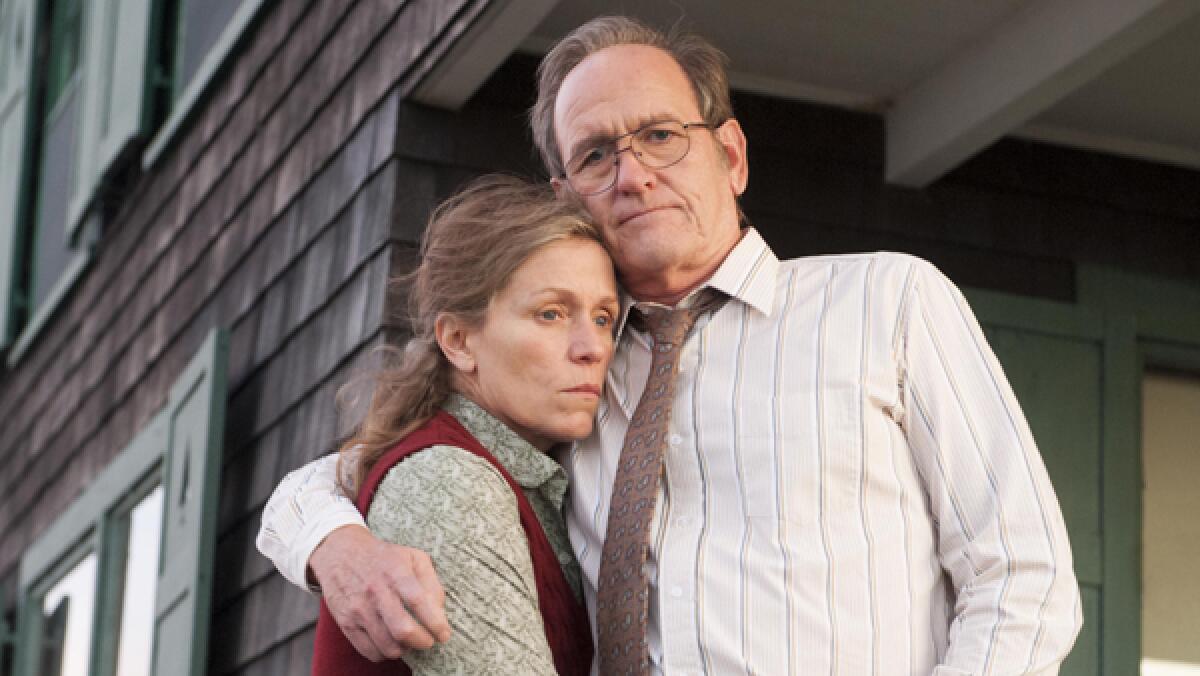
2014 | TV-14 | 1 Season | TV Dramas
Directed by Lisa Cholodenko
Literally; when this lovely, ruthless, masterfully restrained four-hour contemplation of love, marriage, parenthood, mental illness and identity came to an end, I stood up. There was no one physically present to applaud and I felt I had to do something. Here was a reminder of what’s really important: television’s unparalleled ability to tell stories in new, powerful and increasingly lyrical ways. Adapted from Elizabeth Strout’s Pulitzer Prize-winning book, “Olive Kitteridge” is a story of deceptive simplicity told with persistently unexpected beauty. Much of this radiates from stars Richard Jenkins and particularly Frances McDormand, who brought the project to HBO and, along with screenwriter Jane Anderson, insisted that it be neither confined to the time limits of a traditional film nor strung out into the length of a typical miniseries. She also plays the title role and is, quite simply, breathtaking. Her Olive is a straight-backed, grim-mouthed, clear-eyed New England woman of the sort who is, for better and worse, being psychoanalyzed, medicated and self-helped out of existence. (Read more) —Mary McNamara
63. Ghosts (BBC)
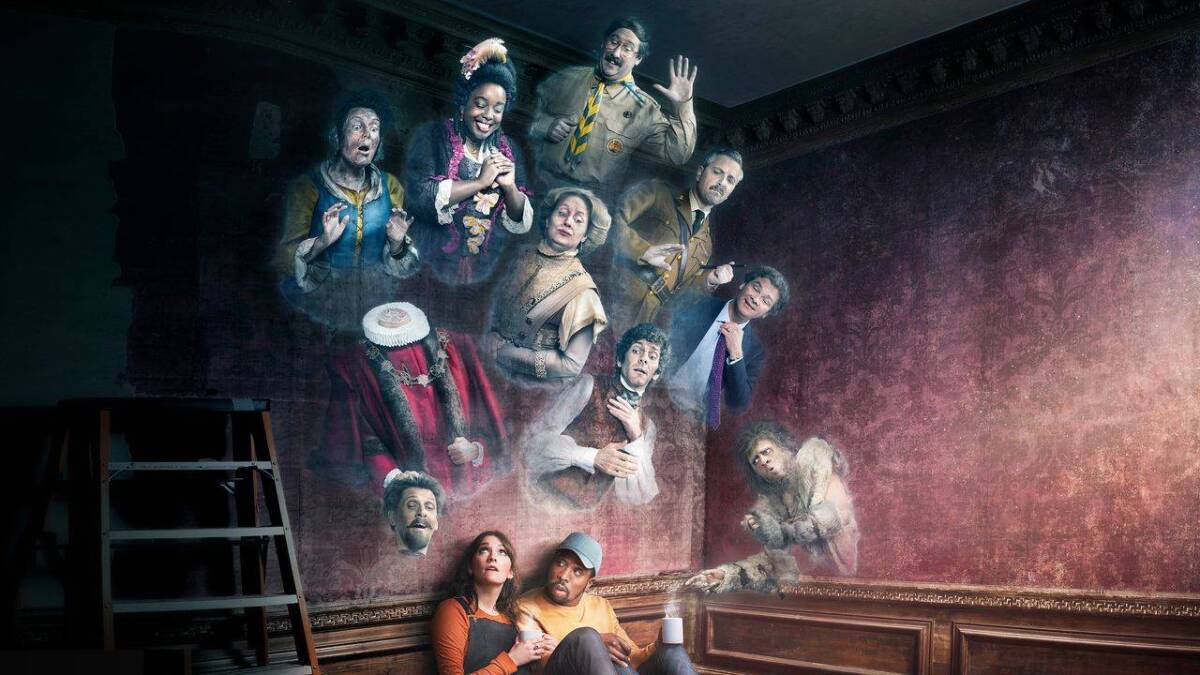
2019| TV-14 | 3 of 4 Seasons | TV Comedies
Created by cast members Mathew Baynton, Simon Farnaby, Martha Howe-Douglas, Jim Howick, Laurence Rickard and Ben Willbond
Fans of the popular CBS comedy “Ghosts” will feel right at home watching this British comedy. Both are set in a dilapidated mansion that’s been inherited by a cash-strapped couple in their 20s (Charlotte Ritchie and Kiell Smith-Bynoe) and is populated by a diverse gaggle of spirits haunting the property. As a result of a head injury, the female lead in both series is the only living person who can see and hear them. Here the fraid (yes, that’s the collective noun for ghosts) represents a broad swath of English history including a Stonehenge era caveman (Laurence Rickard); a village of plague victims in the cellar; and a modern era Member of Parliament (Simon Farnaby) who was literally caught with his pants down when he died. Fans of the U.S. adaptation will recognize thoughtfully made variations of these spirits, including the former lady of the house (Martha Howe-Douglas) and an earnest scout leader (Jim Howick) whose cause of death is obvious to anyone who can see him (an arrow through his neck). A fourth season is in the works. —Ed Stockly
62. Craig of the Creek

2018| TV-Y7 | 4 Seasons | Kids’ TV
Created by Matt Burnett and Ben Levin
In the sharp, strange, smart and satirical “Craig of the Creek,” the title character (voiced by Philip Solomon) has adventures with his best friends JP (Michael Croner, playing slow and Southern, a little like Daws Butler as Huckleberry Hound) and Kelsey (Georgie Kidder), who narrates her thoughts and actions with an English accent and in the third person. The creek of the title runs through a woodsy park where kids range free without adult supervision, where a shopping card “from a grocery store chain that nobody’s ever heard of” can take on legendary proportions and distance is measured by “backyards” — as when, wearing hazmat suits made from garbage bags, the trio determines to penetrate “18 square backyards of North American poison ivy” to the field’s uncharted center. The stories reflect the way that kids (and maybe the rest of us) construct self-image through pop culture and shared games. There are the bike kids, the horse girls (who claim the meadow), the park “elders” — teenagers, playing role-playing games in a cave. A game of tag becomes a story of contagion and isolation and self-sacrifice. There are departures from reality. But by and large, the series exists in a real world of generally plausible physics and relatable human behavior. (Read more) —Robert Lloyd
61. Real Sports With Bryant Gumbel
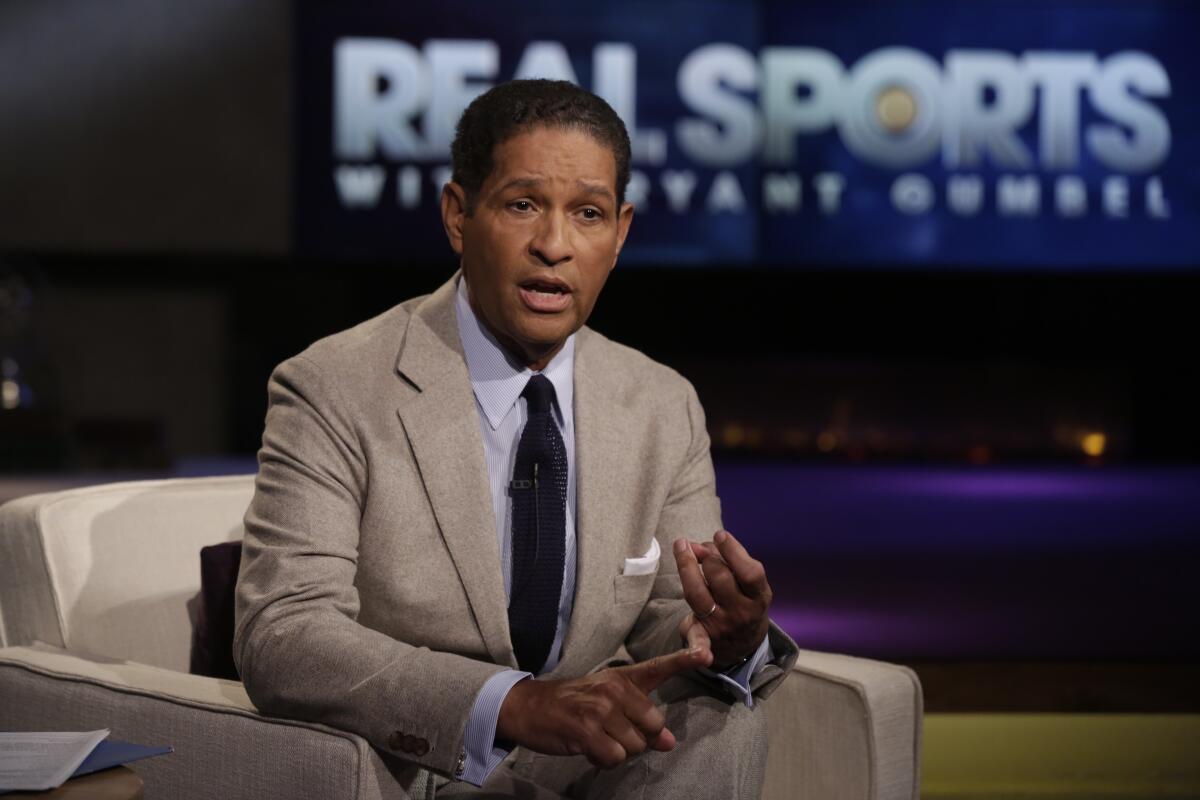
2021 | TV-Rating | 2 of 29 Seasons | Sports Talk Shows
Created by Bryant Gumbel
During his 45-year TV career, Bryant Gumbel has gained a reputation for being a perfectionist. While sports TV coverage has become louder, faster and more prevalent across digital video platforms, Gumbel and his crew have continued to turn out their monthly magazine of investigative pieces and in-depth profiles in artisanal batches. The host and veteran correspondents deliver narrations and conduct interviews with calm authority on an uncluttered screen. The program has always relied on seasoned storytellers instead of sports experts or ex-jocks for correspondents. In recent years he’s added Soledad O’Brien, a veteran of NBC News and CNN. He also put one of his producers, David Scott, in front of the camera, joining correspondents Jon Frankel, Bernard Goldberg, Andrea Kremer, Mary Carillo and Frank Deford. Gumbel is more encouraged about how “Real Sports” — a winner of 29 Emmys, three DuPont broadcast journalism awards and two Peabody Awards — has managed to maintain its independence even as sports have become the financial lifeblood of the television business. The show began in 1995; the most recent two seasons are available on Max. (Read more) —Stephen Battaglio
60. Band of Brothers

2001 | TV-MA | 1 Season | TV Dramas
Produced by Tom Hanks
It’s hard not to be struck by the silence when watching Tom Hanks’ war, as played out in the 10-part miniseries “Band of Brothers.” Although millions were spent in filming the series, which aims to capture the three-year odyssey of the U.S. paratroopers of Easy Company up to and through D-day and on to the ultimate defeat of Germany in World War II, the result is a study in how powerful restraint can be. Shot from the point of view of a fighting man, “Band of Brothers” puts one in the trenches, in the chaos and often in the silence of war. “Band of Brothers” feels real in the watching. It sounds real. There are scenes, long ones, in which all that is heard is the crunch of boots on grass. Even scenes of intense combat —explosions wounding the night sky — have moments that capture the quiet fear, the labored breathing, the sheer terror, the absolute helplessness of the men of Easy Company. Even the cinematic style is muted, colors stripped of the kind of intensity that could have left some of the raw battlefield footage awash in Technicolor red. (Read more) —Susan King
59. The Powerpuff Girls
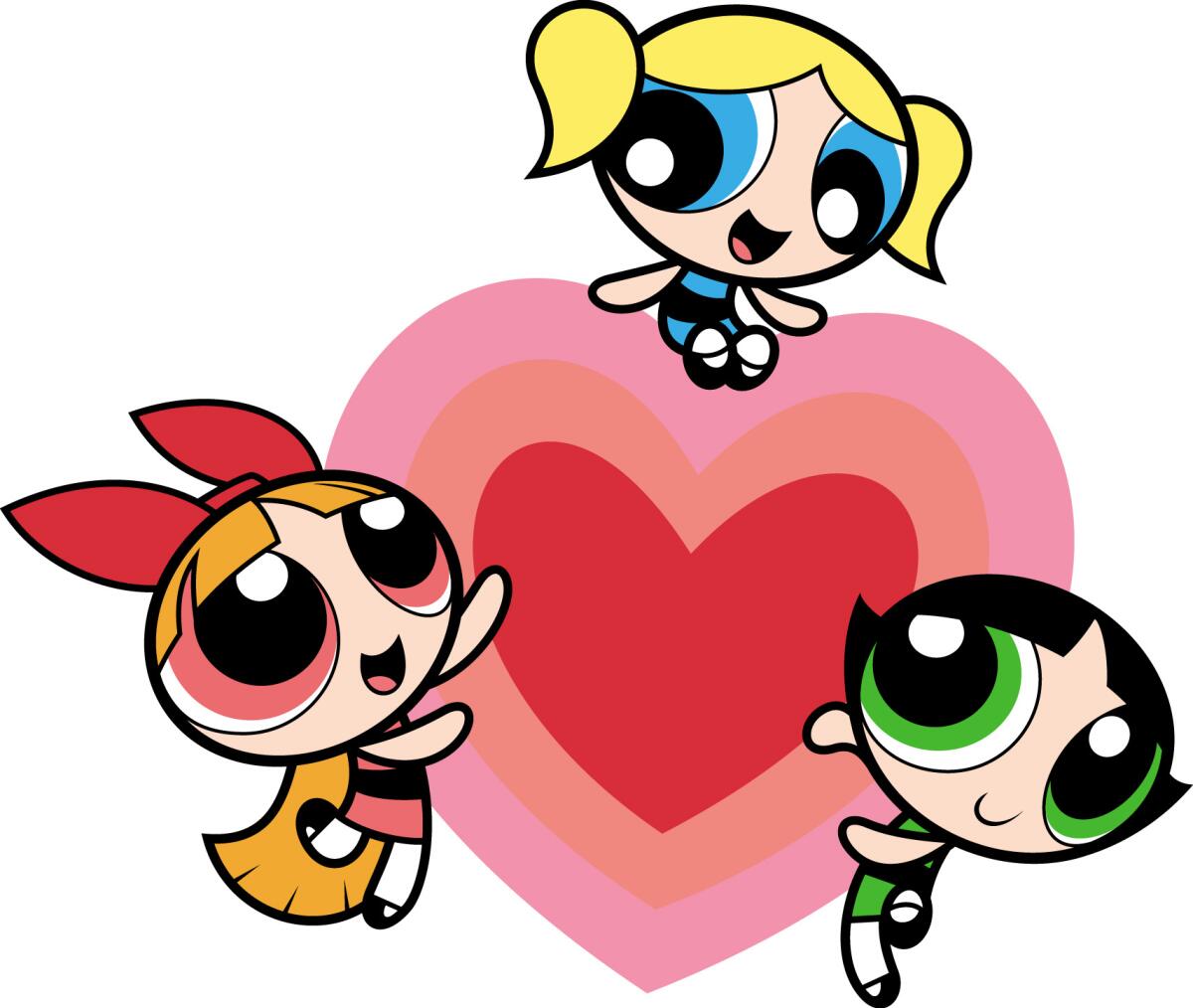
Blossom, left, Bubbles and Buttercup are sisters with superpowers.
1998 | TV-Y7 | 3 and 6 Seasons | Kids’ TV
Original series created by Craig McCracken, reboot by Nick Jennings and Bob Boyle
Sugar, spice, everything nice and an accidental dash of “Chemical X.” These were the ingredients needed to create the beloved 1990s cartoon “The Powerpuff Girls.” More than 15 years after the original debut, the studio turned back to that formula for a brand-new “Powerpuff Girls” series. The original “Powerpuff Girls” aired from 1998 to 2005. Created by Craig McCracken, the series followed the adventures of laboratory-generated superpowered sisters Blossom, Bubbles and Buttercup as they battled crime and protected their hometown from the forces of evil. A refreshing ka-pow of girl power, the original series came at a time when female protagonists, let alone female superheroes, were still a rarity. Although female empowerment was a buzz phrase, the notion that young girls could be cute and tough crime-fighters was still a novel idea. On top of that, the show’s action was often paired with valuable life lessons such as the importance of bathing, of eating broccoli and of not eating paste. (Read more) —Tracy Brown
58. Over the Garden Wall

2014 | TV-PG | 1 Season | Kids’ TV
Created by Patrick McHale
The first thing to say about Patrick McHale’s miniseries “Over the Garden Wall,” after noting that it is beautiful to behold and worth the while of anyone interested in contemporary animation, is that it has been made in a two-dimensional, hand-drawn, hand-painted style virtually extinct in American cartoon features. It comes in 10 parts; each segment lasts 11 minutes, the length of a typical cartoon short. Together, they make a 110-minute self-contained movie. From the start, something feels a little radical about “Over the Garden Wall,” which is consciously old-fashioned. Set in “a mysterious place called the Unknown where long-forgotten stories are revealed to those who travel through the wood,” it has a kind of artisanal quality, reflected not only in its making — you can see the paper texture in art director Nick Cross’ lovely background paintings — but also in its milieu of largely late 19th and early 20th century Americana, with elements of the Brothers Grimm and the Brothers Fleischer (Max and Dave) also worked in. (Read more) —Robert Lloyd
57. Big Love
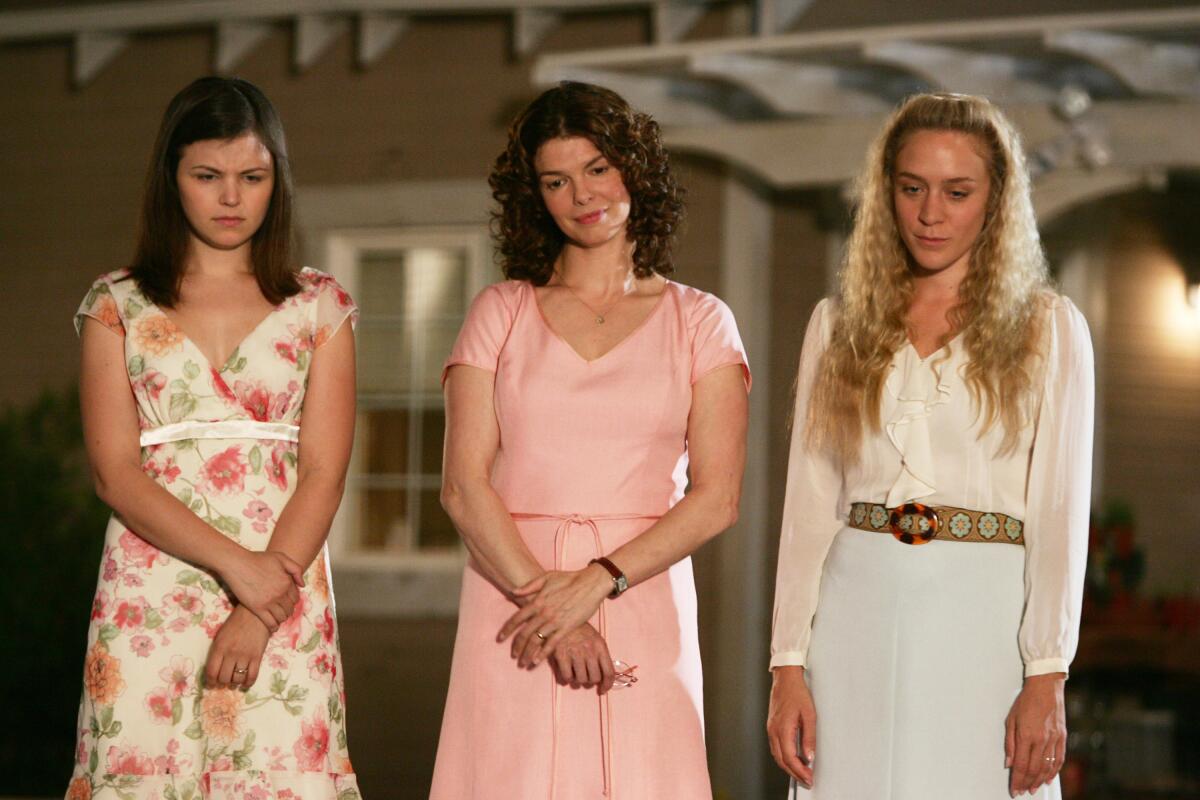
2006 | TV-MA | 5 Seasons | TV Comedies
Created by Mark V. Olsen and Will Scheffer
“Big Love” breaks down into two shows. The first, which is ostensibly the heart of the matter, involves hardware-store mini-mogul Bill Henrickson (Bill Paxton) and his three wives (Jeanne Tripplehorn, Chloë Sevigny and Ginnifer Goodwin) and assorted children, and their attempt to reconcile their customs with a normal suburban life. The other is an outrageous power-struggle melodrama, surrounding the Mormon splinter sect compound Juniper Creek where Bill was raised and with which he remains tangentially involved, usually to his displeasure. This “Big Love” I can rather enjoy. The family story I do not believe at all. That story balances delicately on the portrayal of religious belief, and such things are by nature ephemeral and hard to render convincingly — especially when the people rendering them do not share those beliefs. The Juniper Creek stories, by contrast, are not really about religion at all — they’re about power, control and bad blood, like “The Sopranos,” with even worse clothes. And it’s perhaps because Sevigny’s Nicki, as Bill’s wife and Juniper Creek “prophet” Roman’s (Harry Dean Stanton) daughter, belongs to that story as much as to the domestic drama that, of the three wives, she’s the most consistently compelling, a dynamic mass of conflicting, poorly controlled impulses and desires. But all of the wives are more interesting than their husband. Notwithstanding their schematically complementary personalities — because of them, actually — it can be hard to see what the women see in one another as well. But the show demands that the family be preserved — it is a comedy, at heart —and though pushed to the brink again and again, the Henricksons will assuredly sit down to dinner again, in their conjoined backyard, in the warm and unnatural glow of a soundstage exterior. (Read more) —Robert Lloyd
56. High Maintenance
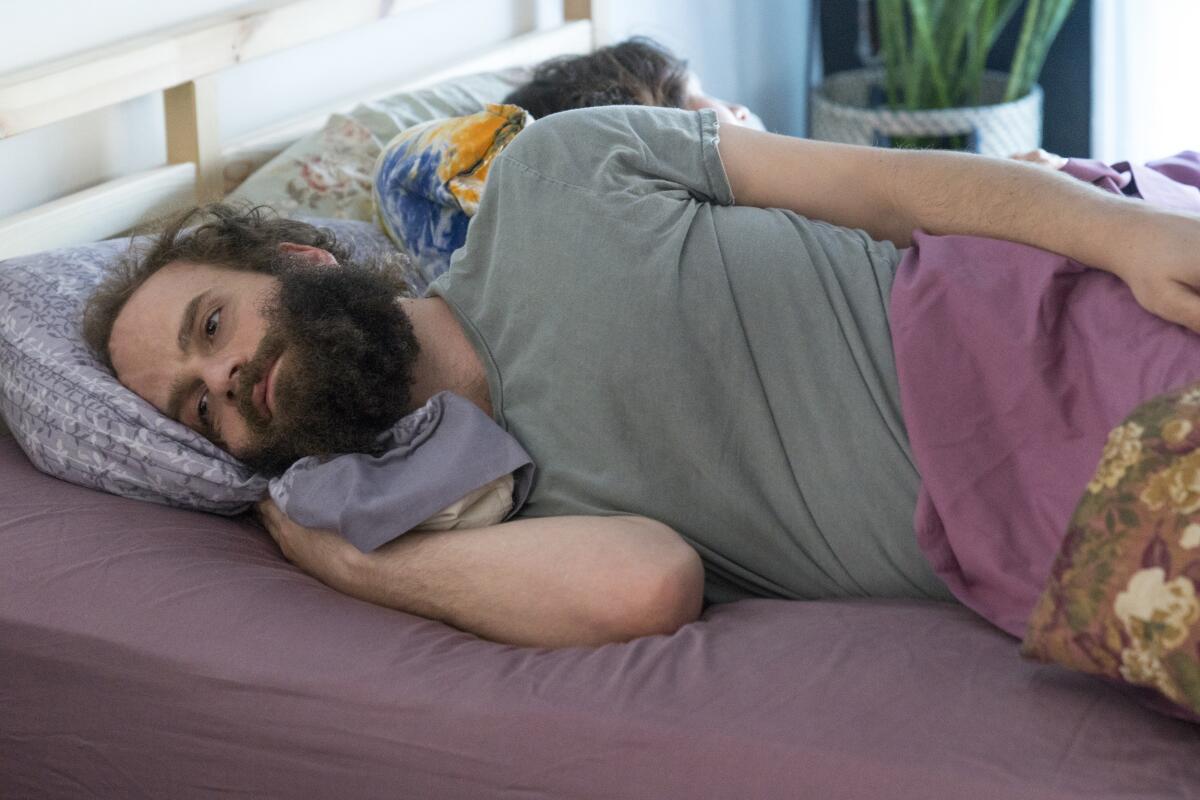
2016| TV-MA | 4 Seasons | TV Comedies
Created by Katja Blichfeld and Ben Sinclair
“High Maintenance” seems less concerned with being funny than with being real, which makes it often funny. It uses the clientele of a New York pot dealer (Ben Sinclair as “The Guy,” as in “my weed guy”) to tell a variety of freestanding short stories. Created, written and directed by Katja Blichfeld and single regular cast member (and then-husband) Sinclair, “High Maintenance” is not so much multicultural as it is authentically cosmopolitan; characters come in many colors, ages, sexual orientations, marital statuses, classes. There are family stories and dating stories and stories about loneliness. Here and there a narrative turn is visible before you arrive, but more often the directions they take are unpredictable, heading to a shaggy dog kicker or some poetic moment that is less an ending than an adjustment. In some stories — they come generally two per episode — The Guy barely appears, in others his own experience becomes very much the point. (Read more) —Robert Lloyd
55. Bored to Death

2009 | TV-MA | 3 Seasons | TV Comedies
Created by Jonathan Ames
Jonathan Ames, a Brooklyn-based writer of fiction and nonfiction, turned his long short story “Bored to Death” into a situation comedy, also titled, though less aptly, “Bored to Death.” Each version revolves around a character named Jonathan Ames (Jason Schwartzman), a Brooklyn-based writer of fiction and nonfiction who is having a hard time finishing his second novel and is drinking too much white wine — which is his idea of drinking less alcohol — and smoking too much pot. As the series opens, his girlfriend is moving out and — sad, stymied and under the influence of a Raymond Chandler novel — he advertises his services on Craigslist as a private detective: “I’m not licensed but maybe I’m someone who can help you.” (Read more) —Robert Lloyd
54. Years and Years
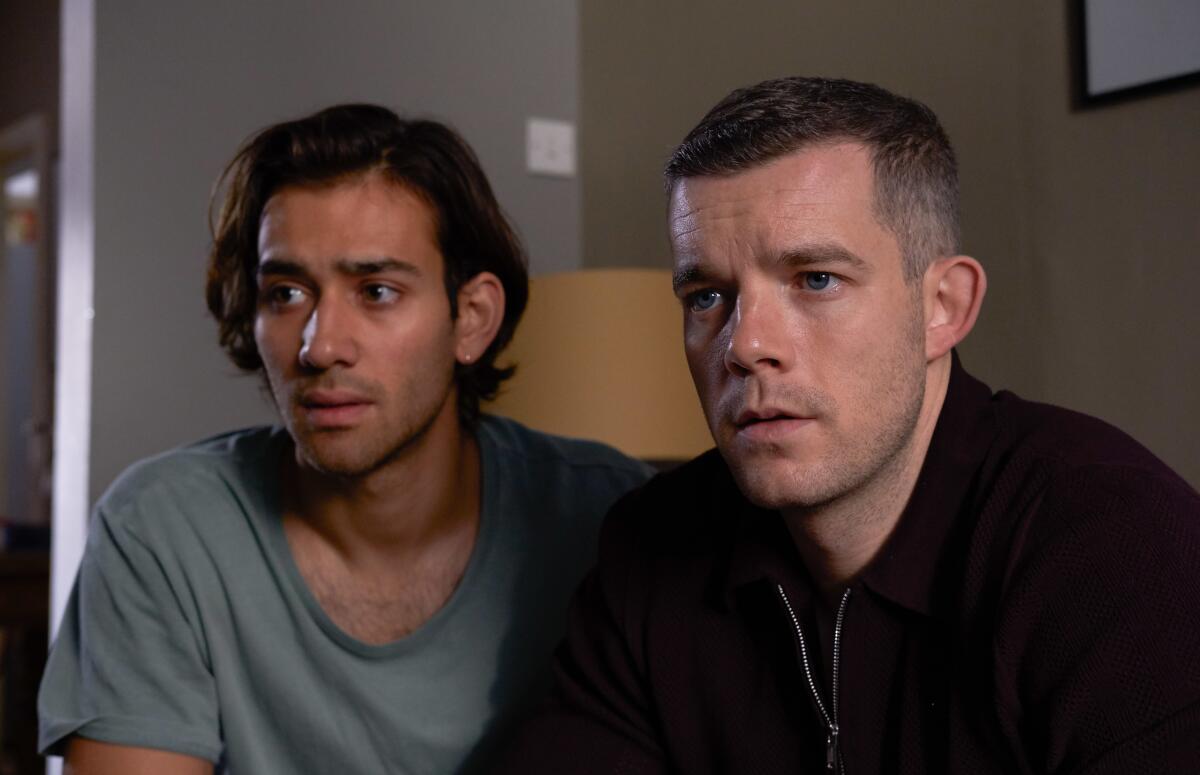
2019 | TV-MA | 1 Season | TV Dramas
Created by Russell T. Davies
“Years and Years” follows a Manchester family for 15 years, from 2019 into a plausible dystopian near-future. It is a long, raw scream in the face of current events, even as it offers smart, superior entertainment. Meet the Lyons. Stephen (Rory Kinnear), a successful financial advisor, lives in London with his accountant wife, Celeste (T’Nia Miller), and their daughters Bethany (Lydia West), who is having identity issues of a new sort, and Ruby (Jade Alleyne), who is the least distressed person in the series. Younger brother Daniel (Russell Tovey) is a housing official; he has a husband, Ralph (Dino Fetscher), a big lug with a distressing weakness for conspiracy theories. Maybe something will happen with Viktor (Maxim Baldry), the handsome Ukrainian asylum seeker Dan meets in the course of his job. Elder sister Edith (Jessica Hynes) is a sort of globe-trotting citizen-journalist guerrilla activist who has not been home in many years; cheery and impulsive younger sister Rosie (Ruth Madeley), a single mother of two, uses a wheelchair because of a birth defect. Above them all is grandmother Muriel (Ann Reid), who lives in a large tumbledown manse where the family will gather intermittently. At least once they will march around a fire to Chumbawamba’s “Tubthumping.” Meanwhile, in the public sphere, a person named Vivian Rook (Emma Thompson), whose eyes in some shots resemble the black eyes of an alien, is becoming politically prominent thanks to showmanship, outsider status and a capacity for impolitic “straight talk” (though what she stands for exactly is impossible to say). Sound familiar? (Read more) —Robert Lloyd
53. Harley Quinn
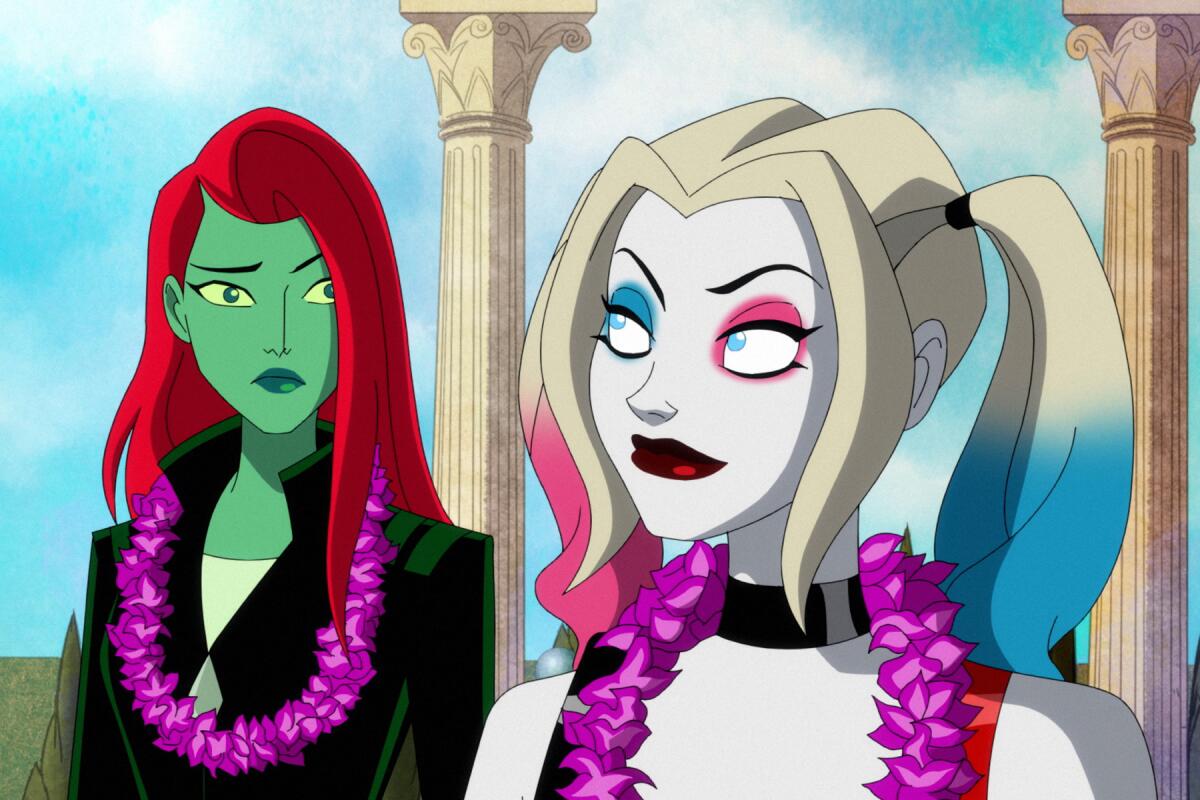
2019 | TV-MA | 3 Seasons | TV Shows Based on Comics
Justin Halpern, Patrick Schumacker and Dean Lorey
Fun has been a precious commodity during the pandemic, and “Harley Quinn” delivers it in spades. This R-rated animated series follows the titular DC villain as she breaks up with the Joker and sets off to establish herself as more than his ex-girlfriend and former sidekick. For Harley this means assembling her own crew, finding a new lair and pulling off enough big heists to get noticed. The show is as smart as it is silly, with episodes skewering aspects of superhero storytelling and fandom while packing plenty of nods to past DC comics and animated shows. But within this package of irreverent cartoon violence is a series that examines toxic relationships, the struggles women endure in male-dominated fields and what it really means to love someone. (Read more) —Tracy Brown
52. Mare of Easttown
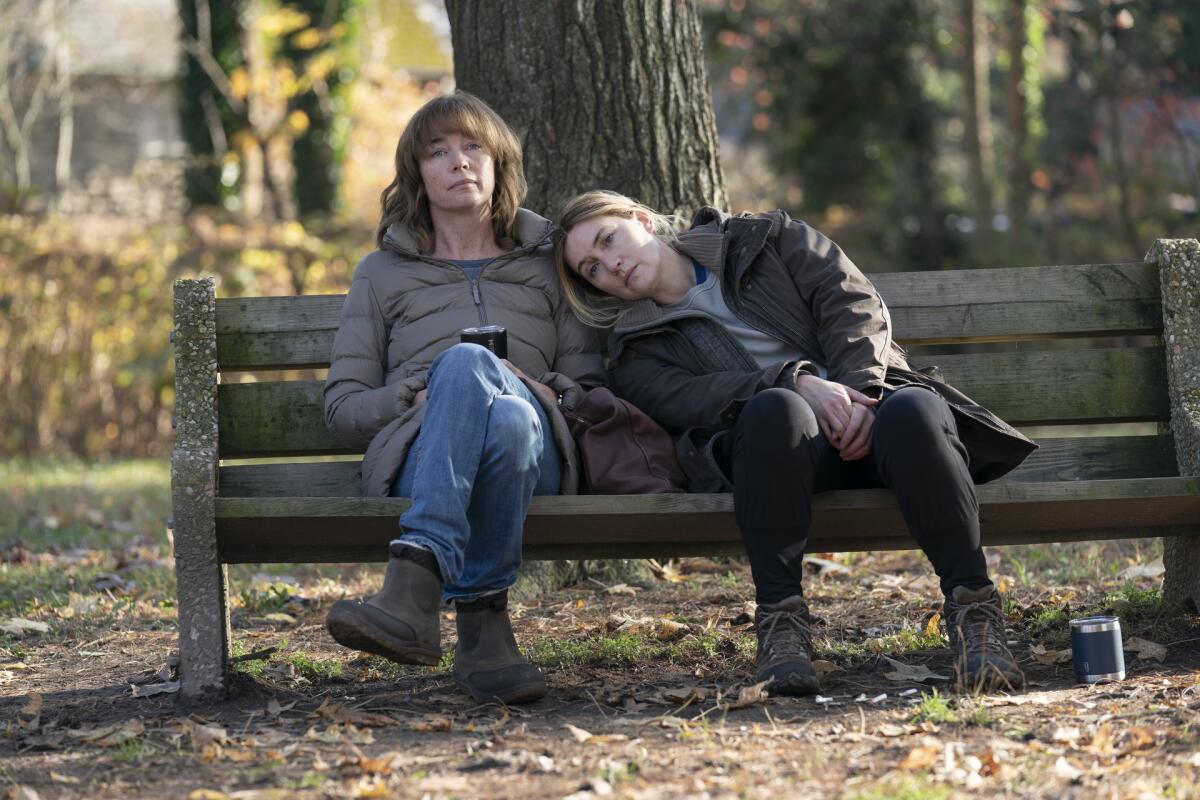
2021 | TV-MA | 1 Season | TV Dramas
Written by Brad Ingelsby, directed by Craig Zobel
In the well-wrought “Mare of Easttown,” Kate Winslet plays Mare Sheehan, a police detective in a Pennsylvania small town dealing with the death of a teenage girl and the possibly related disappearance of another a year before. Along with investigating “the burglaries and the overdoses and all the really bad crap that goes on around here,” things closer to home are adding stress to Mare’s life. Her ex-husband (David Denman) is about to remarry and has moved into a house bordering hers; her son is dead, by his own hand; and the mother of his child (Sosie Bacon), freshly out of rehab, wants to claim the little boy back from Mare, who worries that his “trouble focusing on tasks” is a sign of worse mental problems to come. Also living with Mare are her mother, Helen (Jean Smart), a verbal sparring partner, and her daughter Siobhan (Angourie Rice). Twenty-five years earlier, as a member of her high school basketball team, Mare made a shot that clinched a state championship, and as the series gets underway, there is a ceremony to celebrate it, a device that seems intended mostly to suggest that some people get out of town and some never do and that glory days, well, they’ll pass you by. (And good riddance.) Mare’s good at her job, and dedicated to it, though she tends to bend rules and ignore orders. The real question is whether Mare, an unhappy person stuck in an unhappy place, might become even a marginally happier one, a matter quite apart from her catching a killer. (Read more) —Robert Lloyd
51. Betty
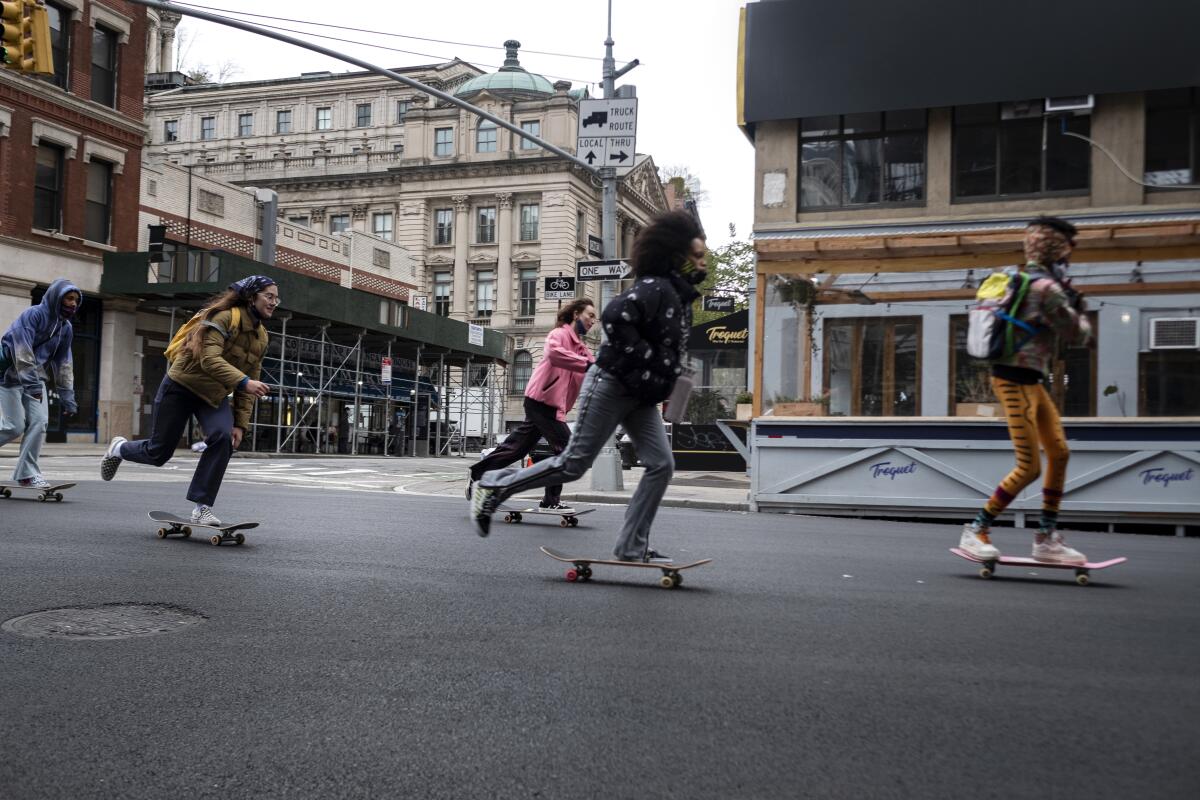
2020 | TV-MA | 2 Seasons | TV Dramas
Created by Crystal Moselle and Lesley Arfin
Not everything surprising is good, and the phrase “I can’t believe that got made” is more often attached to bad programs than good ones. But when it is good, I thank the television gods for whatever happy accidents and industrial calculations brought it to fruition. “Betty” is such a show. The series reboot of Crystal Moselle’s 2018 film “Skate Kitchen” focuses on a group of young female skateboarders in New York City. “Betty” has no stars, no sets. There are a few professional actors, and members of the main cast have already appeared in the movie, but they are playing versions of themselves in a show built on their experience, and are good enough to make you question whether they are acting at all. It has a modicum of plot and a fair amount of normal human conflict but it is not dark, darkly comic, violent or fantastic. Its main themes are friendship, self-knowledge, identity, equality and freedom — which is to say, it’s a show about being young. It feels innocent, which is not to say naive. And it is appropriately, almost casually exhilarating. (Read more) —Robert Lloyd
50. The West Wing
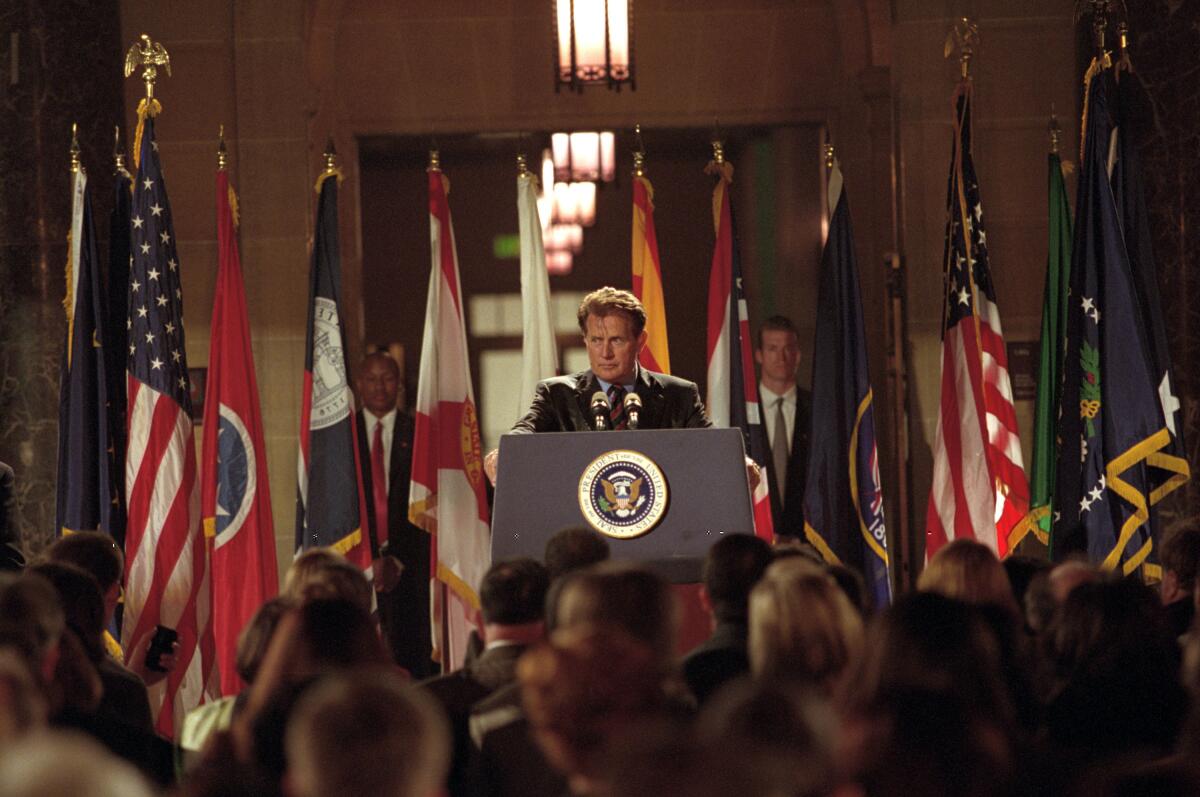
1999 | TV-Rating | 7 Seasons | TV Dramas
Created by Aaron Sorkin
This White House drama is well-acted, smartly written and a must-see for viewers smitten by topical issues that coexist with big humanity and big sentiment. A good series? Absolutely, but “The West Wing” will never be a great one. It ignores history by seductively inviting Americans to trust in the inherent virtue of the government’s executive branch and those who steer it. In this case, it’s a Democratic White House whose inhabitants, from Martin Sheen’s President Josiah Bartlet to the secretarial pool, spend each week converging on the same Holy Grail of goodness. The show’s lump-in-your-throat theme music announces creator Aaron Sorkin’s intentions, for this is a White House that even most Republicans could respect, one perpetuating the false assumption that gleaming personal values are a prerequisite for a president and his senior staff to function effectively on behalf of the people. That may not be a bad goal, given what the United States had been through. What’s more, “The West Wing” affirms that well-executed fables are hardly without charm. (Read more) —Howard Rosenberg
49. Looking

2014 | TV-MA | 2 Seasons | LGBTQ TV Shows
Created by Michael Lannan
What at first seems like your standard (if R-rated) banter-heavy, young-urbanites-seek-love/meaning tale, this time told from a gay perspective, quickly proves to have a truer heart and loftier ambitions. Yes, creator Michael Lannan is clearly determined to depict and discuss male homosexuality with the same semi-erotic-realism that has become commonplace among heterosexual sex scenes — We’re here, we’re queer, we’re copulating on screen, get used to it. Having established this (again and again and once more for good measure), the story becomes both more universal — who among us is not looking for love/meaning? — more pointed and way more interesting. Even shows like “Queer as Folk” and “The L-Word” often seemed to have “A Straight Person’s Guide to Understanding Gay People” subtext. Here, not so much. As with “Girls,” the purpose is not the view but the vantage point. The world has changed, is changing, just as fast and radically for gay men as it is for everyone else and isn’t it time a show dealt with that? Why yes, yes it is. (Read more) —Mary McNamara
48. The Staircase
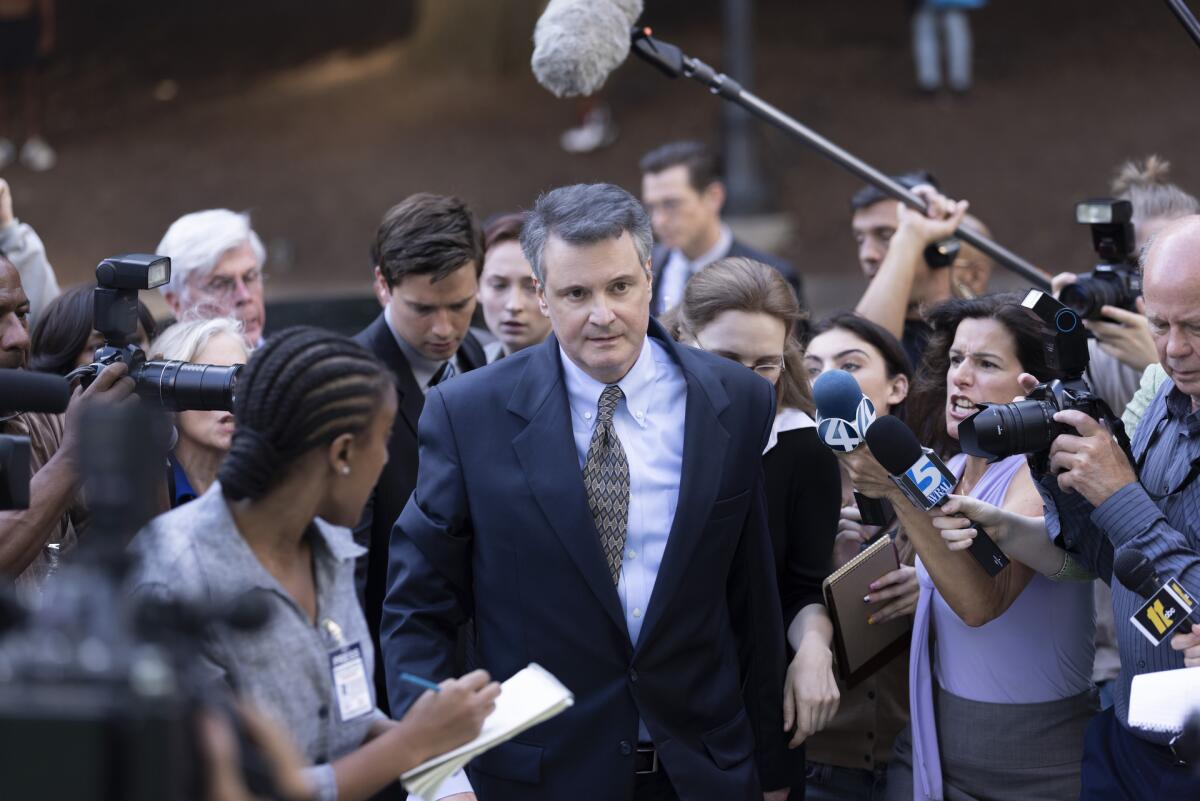
2022 | TV-MA | 1 Season | TV Dramas
Created by Antonio Campos
Some history: In 2001, in the city of Durham, N.C., Michael Peterson, a writer and sometime political candidate, either did or did not kill his wife, Kathleen, who either fell down a flight or stairs or was beaten to death at its foot. A French television crew, under the direction of Jean-Xavier de Lestrade, arrived soon after Peterson was accused of murder and produced an eight-episode docuseries detailing the trial from preparation to verdict — “The Staircase,” a Peabody Award-winning early model for the twist-and-turn true-crime documentaries and podcasts that have come to clutter the cultural landscape; subsequent episodes were added, updating the story with new developments through 2017. (The 13-episode complete set is available on Netflix.)
This history has been converted into a Max miniseries, with Colin Firth as Michael and Toni Collette as Kathleen. (Read more) —Robert Lloyd
47. Samurai Jack
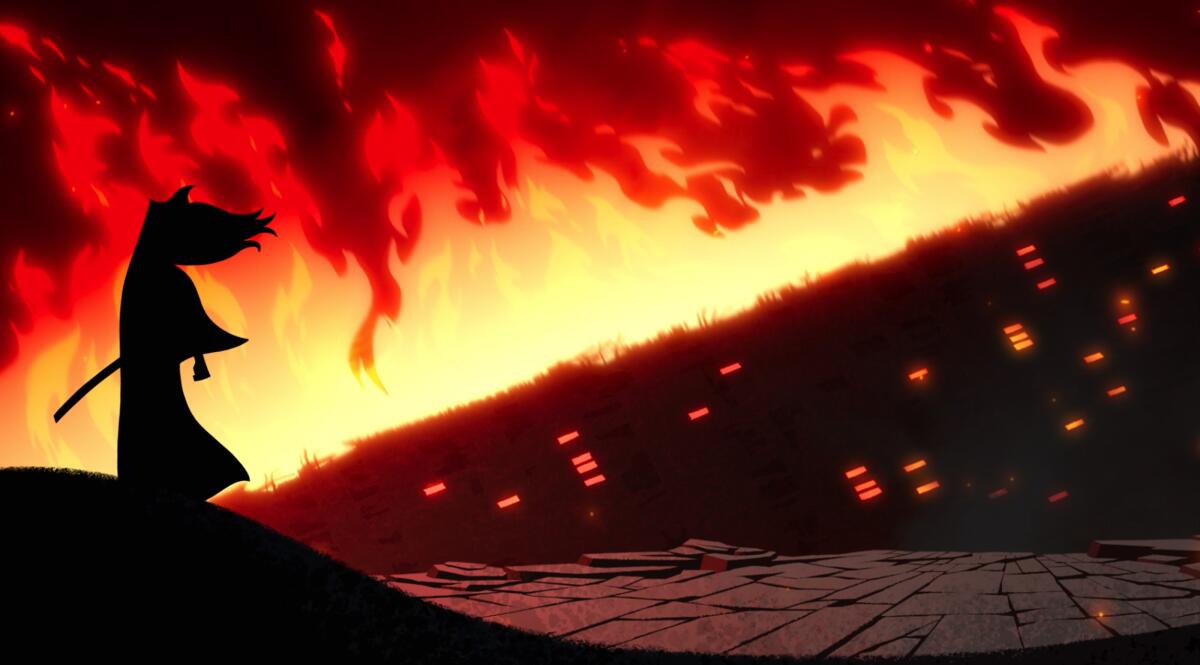
2001 | TV-Y7 | 5 Seasons | Kids’ TV
Created by Genndy Tartakovsky
There has been nothing quite like “Samurai Jack” in its dedication to making every frame a thing of beauty: Form here is content. One might say that the series, which is set on a future Earth populated by aliens, mutants and machines more significantly takes place where the work of illustrator Charlie Harper and artist Katsushika Hokusai meets that of Disney artists Eyvind Earle and Mary Blair and filmmakers Akira Kurosawa, Sergio Leone and David Lean. It’s an aesthetic space, patterned and painterly, in which the third dimension is drawn, not mathematically plotted and computer-rendered. Creator Genndy Tartakovsky plays with framing, using split-screen effects and letterboxing the image for “cinematic” effects that also suggest the way a graphic novelist carves up a page. Story has not been exactly beside the point, if only in that it determines what pictures we see. “Samurai Jack” tells tales of an ongoing battle between an evil, shape-shifting wizard, Aku (Greg Baldwin, replacing the late Mako), and the samurai Jack (Phil LaMarr) — he has been cast into a far future where the wizard rules all. While roaming this world, defending himself and a variety of fantastic creatures from Aku’s often mechanical enforcers, Jack seeks to return to his own time in order to defeat his nemesis and rewrite history.One hopes for a happy ending, of course, but what matters most is shape and color. It makes “Samurai Jack” endlessly rewatchable: Every picture tells a story. (Read more) —Robert Lloyd
46. And Just Like That...
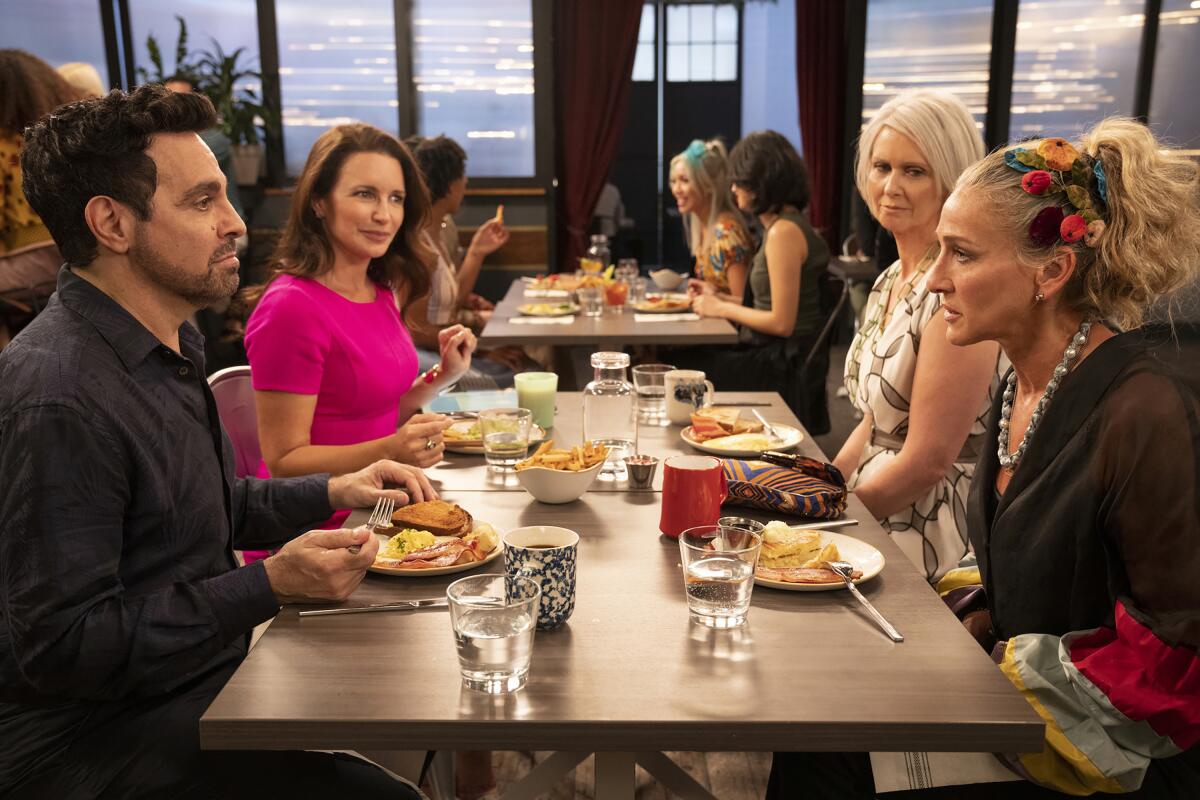
2021 | TV-MA | TV Comedies
The “Sex and the City” reboot “And Just Like That ...” hit Earth like the asteroid in “Don’t Look Up” and with potentially similar results; a quick glance through early reviews raises the specter of a franchise-extinction event. Still, critics are not the audience; “SATC” fans are the audience. And no doubt there are millions of viewers who long to know what Carrie Bradshaw (Sarah Jessica Parker), Miranda Hobbs (Cynthia Nixon), Charlotte York (Kristin Davis) and Samantha Jones (Kim Cattrall) are up to as they sashay through their sixth (and seventh) decade.
Well, not Samantha. As every true fan knows, Cattrall declined to be part of the resurrection process, and reading the subtext of the on-screen explanation for what has become a very famous off-screen estrangement between Cattrall and Parker is indeed a highlight of the pilot. Samantha, we are told, has gone to London after, we later discover, Carrie fired her as Carrie’s publicist. Not surprisingly, Samantha is not responding to Carrie’s texts. (A second season is premieres June 22) (Read more) — Meredith Blake and Mary McNamara
45. The Other Two

2019 | TV-MA | 3 Seasons | TV Comedies
Created by Sarah Schneider and Chris Kelly
“The Other Two” is a fast-paced, biting satire of social-media celebrity, which offers both an unexpectedly poignant look at a family in mourning and a radically straightforward depiction of gay life. The series revolves around Cary (Drew Tarver), a New York waiter and frustrated actor, and his sister, Brooke (Helène Yorke), a dancer turned leasing agent who’s squatting in a vacant luxury apartment. Cary, who is gay, is caught in a self-destructive hook-up cycle with his (supposedly) straight roommate, while Brooke has just ended a relationship with her sweet but dumb boyfriend. Adrift and closing in on 30, the siblings are forced to reckon with their insecurities when their adolescent brother Chase (Case Walker) becomes an overnight sensation thanks to a homemade music video, “I Wanna Marry U at Recess,” which goes viral. Much to their chagrin, their recently widowed mother, Pat (Molly Shannon), goes through an identity crisis of her own, transforming into an overly eager Momager. (Read more) —Meredith Blake
44. House of the Dragon
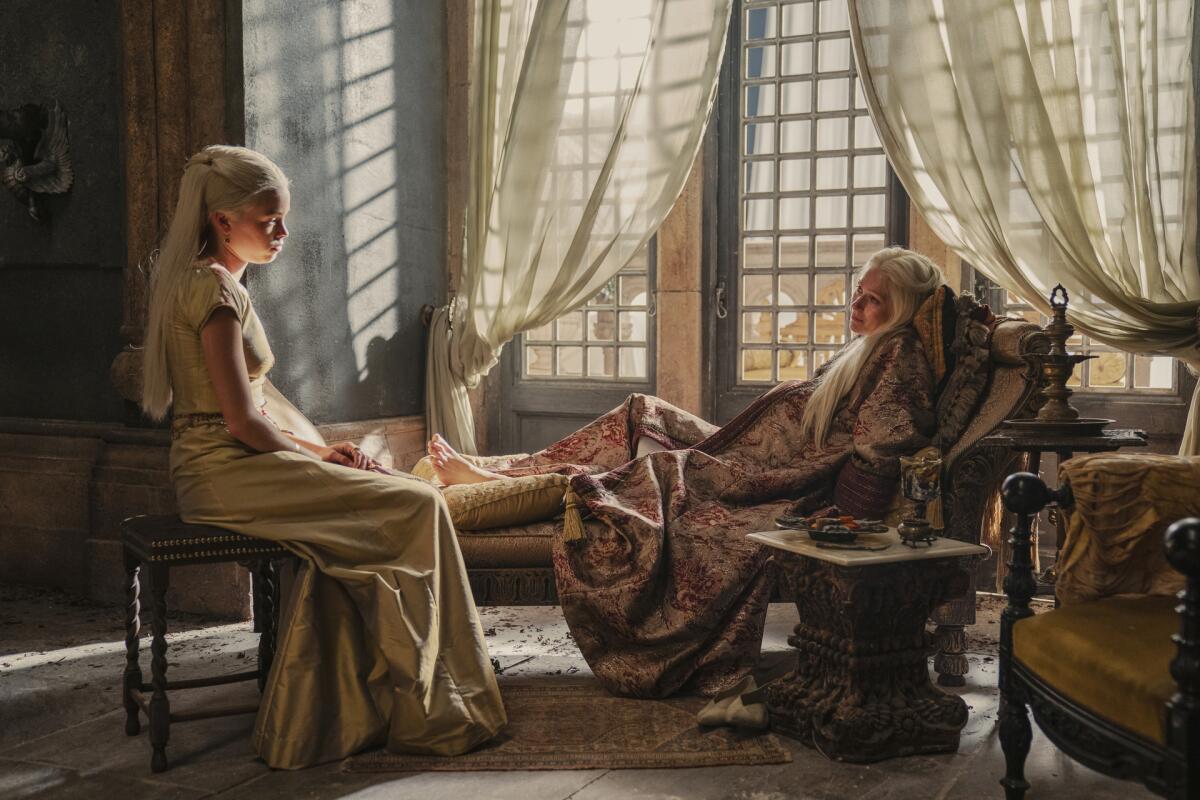
2022 | TV-MA | 1 Season | Fantasy drama
Showrunners Miguel Sapochnik and Ryan J. Condal
Let’s start at the end. “Game of Thrones” was the television drama of the decade right up until its eighth and final season, when the HBO series’ conclusion disappointed fans on a global scale. Despite all the dexterous villains, fierce emancipators, persevering women and supernatural surprises, it handed the crown to a boy who’d literally slept through much of the show’s 73-episode run.
Thanks to that fizzling 2019 climax, prequel “House of the Dragon” premiered amid slightly lower expectations than it would have if “GoT” had nailed the landing. But with the arrival of the first episode, “The Heirs of the Dragon,” the hope that a new series might recapture some of the power and grandeur of its predecessor no longer seems so fanciful.
Set 172 years before the death of the Mad King and the birth of Daenerys Targaryen, “House of the Dragon” immediately thrusts viewers into the familiar sights and sounds of the “Game of Thrones” universe: Flea Bottom and its brothels, dragons and their flames, the Red Keep and its Iron Throne. While honoring the legacy and look of the original series, the spinoff wisely adopts subtle changes in tone and approach while introducing a fresh world of characters and storylines. (Read more) — Lorraine Ali
43. A Different World
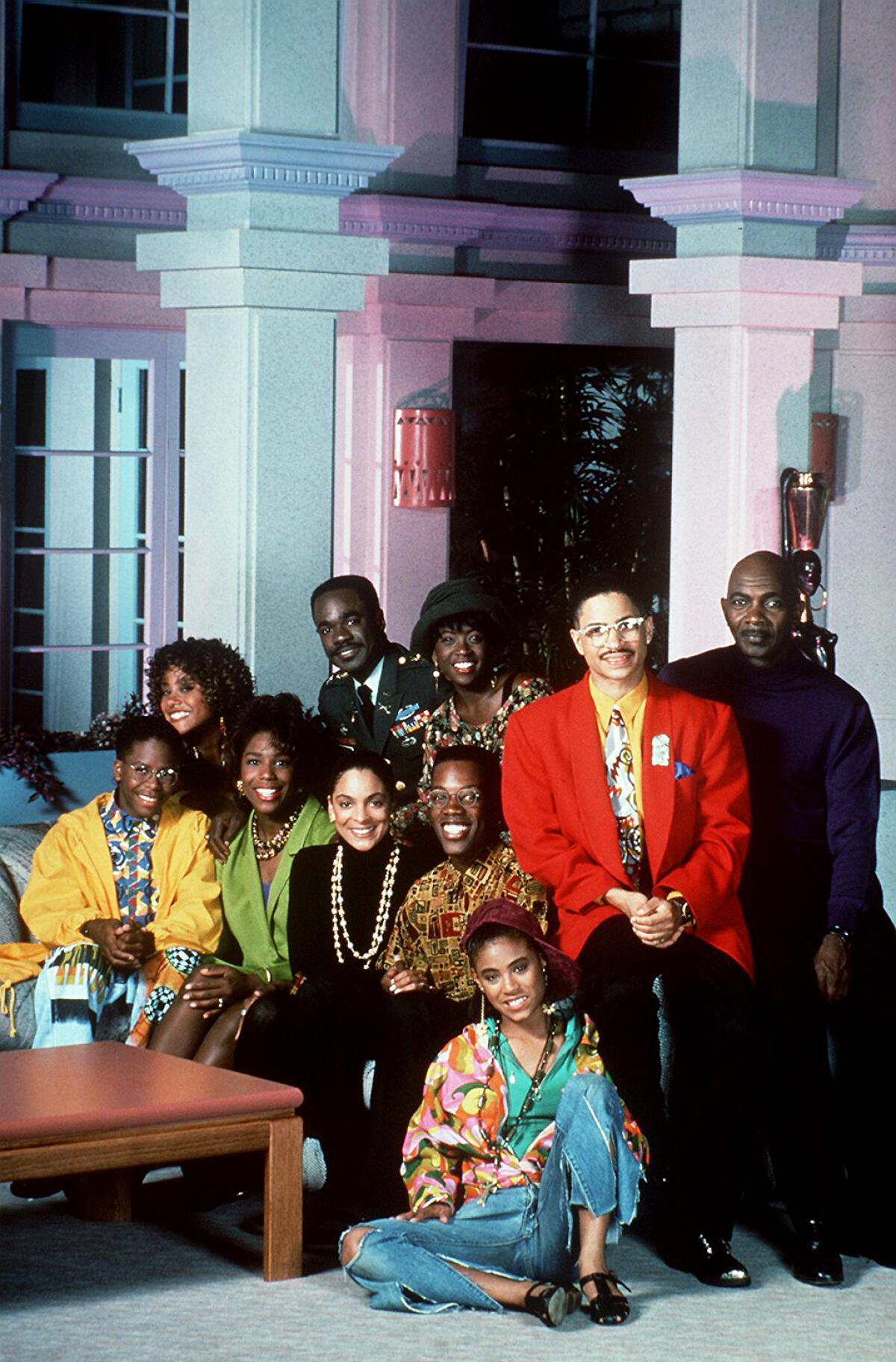
1987 | TV-PG | 6 Seasons | TV Dramas
Created by Bill Cosby
“A Different World” began as a spinoff of “The Cosby Show” following Denise Huxtable (Lisa Bonet) as she went off to college, but over a six-season run from 1987 to 1993, the sitcom more than earned its own place in the TV canon. A vivid depiction of life on a historically Black college campus, “A Different World” introduced viewers to a sprawling ensemble of great comedic characters, including spoiled Southern belle Whitley Gilbert (Jasmine Guy), her on-off love interest with the flip-up glasses, Dwayne Wayne (Kadeem Hardison), and the free-spirited Freddie Brooks (Cree Summer). Under the guidance of director-producer Debbie Allen, who helped retool the show after a wobbly first season and the departure of star Bonet, “A Different World” tackled political and social issues of the day, like AIDS and the Iraq war, and was an exciting showcase for emerging Black stars, like Jada Pinkett Smith and Keenen Ivory Wayans. (Read more) —Meredith Blake
42. Treme
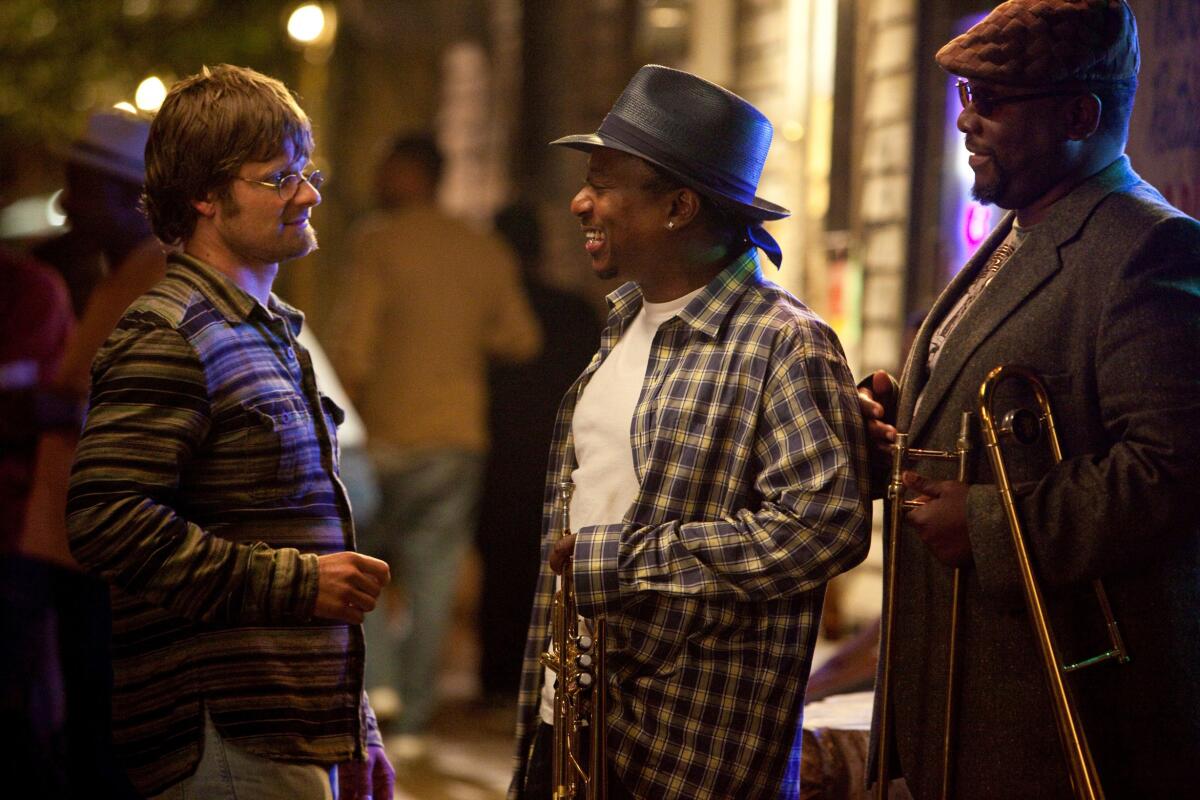
2010 | TV-MA | 4 Seasons | TV Dramas
Created by David Simon and Eric Overmyer
“Treme” (which refers to a New Orleans neighborhood and is pronounced treh-MAY) proved that television as an art form can not only rival Dickens, but it also can hold its own against Wagner. Full of the same complicated characters, crisscrossing storylines and well-informed immediacy that made “The Wire” one of the most astonishing shows on television, “Treme” flips the theme of urban decay and infuses it with music. The pilot, directed by Agnieszka Holland, opens with Treme’s first second-line parade since Hurricane Katrina and ends with a traditional funeral. In the hour and a half in between, music is woven into the narrative like gold thread through a medieval tapestry. That includes sets played in clubs by real local stars including Kermit Ruffins (who apparently makes some mean barbecue); snatches aired in protest by the slacker-gadfly DJ Davis McAlary (Steve Zahn); gigs picked up by profligate trombonist Antoine Batiste (“The Wire’s” Wendell Pierce); and drum rituals of Albert Lambreaux (Clarke Peters, also of “The Wire”), a Mardi Gras Indian chief determined to raise his tribe and his community once again. The music of “Treme” enters seamlessly at regular intervals, as essential to the story as the players or the plot. (Read more) —Mary McNamara
41. Oz
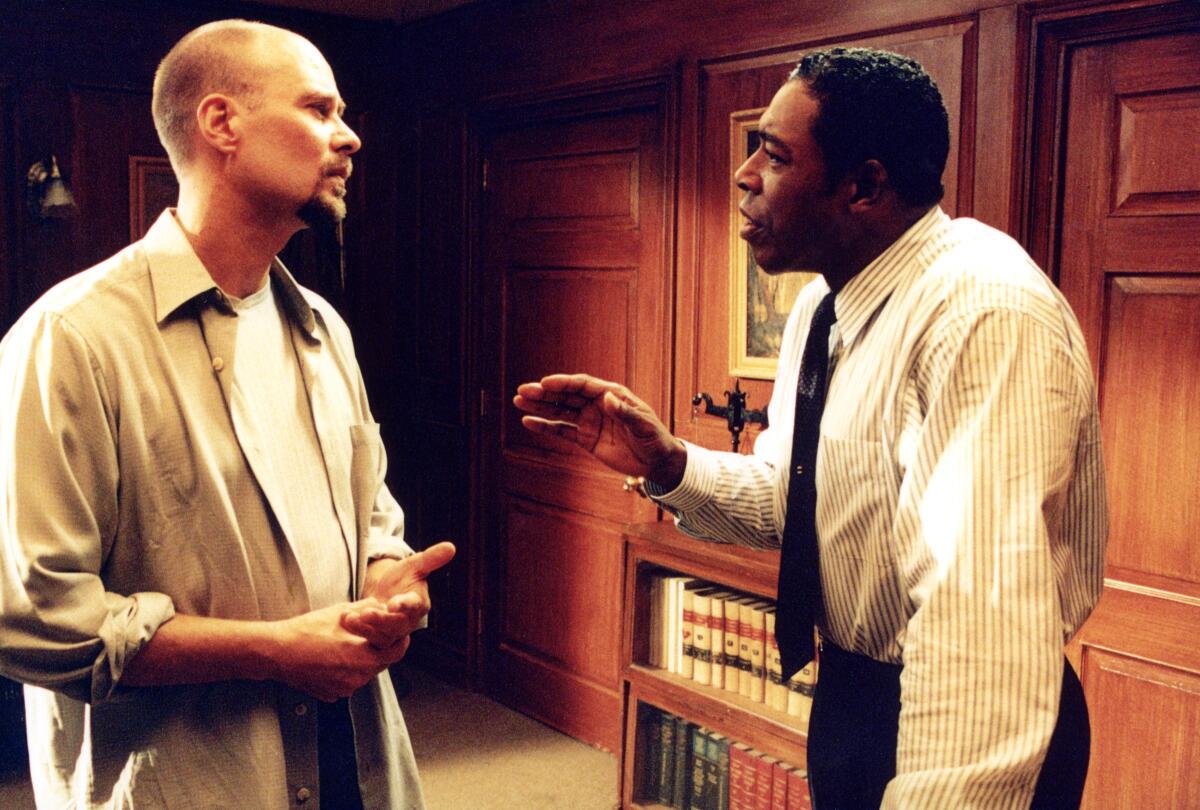
1997 | TV-MA | 6 Seasons | TV Dramas
Created by Tom Fontana and Barry Levinson
“Oz” is a prison series that shackles viewers to a universe of such unrelieved violence, grimness and hopelessness that watching it is painful. It’s interesting, at times compelling work from producers Tom Fontana and Barry Levinson, whose charismatic “Homicide: Life on the Street” on NBC is reason enough to attract you to this distinctive collaboration. And typical of risk-taking HBO, you know almost immediately upon watching “Oz” that you’re nowhere near Kansas anymore. There’s nothing like it elsewhere on TV — nor, probably, will there ever be. Be forewarned, too, that “Oz” is flat-out the most violent and graphically sexual series on TV. By contrast, it makes ABC’s “NYPD Blue” look and sound like dancing Barney. (Read more) —Howard Rosenberg
40. Our Flag Means Death

2022 | TV-MA | 1 Season | Period comedy
Created by David Jenkins and produced by Taika Waititi
In the fine, funny, oddly sweet and surprisingly fact-based period comedy “Our Flag Means Death,” Rhys Darby plays Stede Bonnet, a wealthy landowner who, in 1717, bored with his life, leaves his wife and children to become a pirate captain. It’s a job for which he has no qualifications, and his image of which has been formed entirely from books. In his first raid, he manages to steal an apparently dead plant from some fishermen, wishing them good luck with their fishing as they depart. He has no taste for bloodshed, or other traditional requirements of piracy; it’s as if this is the only way he can imagine going to sea. (Read more) —Robert Lloyd
39. The White Lotus

2021 | TV-MA | 2 Seasons | TV Dramas
Written and directed by Mike White
From the Lannisters to the Roys, rich people behaving badly is a sweet spot for HBO. In the satirical limited series “The White Lotus,” that tradition is extended to an exclusive Hawaiian resort where a group of wealthy guests with ample baggage has turned paradise into a living hell, both for themselves and for the staff. The self-centered tourists include the dysfunctional Mossbacher family, led by tech mogul mom Nicole (Connie Britton). She’s flanked by her powerless husband, Mark (Steve Zahn), aimless teen son Quinn (Fred Hechinger), sneering college student daughter Olivia (Sydney Sweeney) and Olivia’s conflicted bestie, Paula (Brittany O’Grady). Arriving on the same boat are honeymooners Rachel (Alexandra Daddario) and Shane Patton (Jake Lacy), whose marriage is already showing signs of strain. Emotionally needy guest Tanya McQuoid (Jennifer Coolidge) is there to spread the ashes of her late mother, but so far she’s spent her trip in the bar or the spa. Meanwhile, hotel manager Armond (Murray Bartlett), spa manager Belinda (Natasha Rothwell) and bellhop/luau performer Kai (Kekoa Kekumano) are losing their minds, dignity and freedom catering to the needs of their guests. But fun as it may be watching the wealthy eat themselves alive,these visitors are the invaders. The staff members are their unfortunate subjects. And colonization is a theme flicked at, including Native Hawaiians’ economic and social inequality and the tourism industry’s appropriation and destruction of native culture. (Read more) —Lorraine Ali
38. Silicon Valley
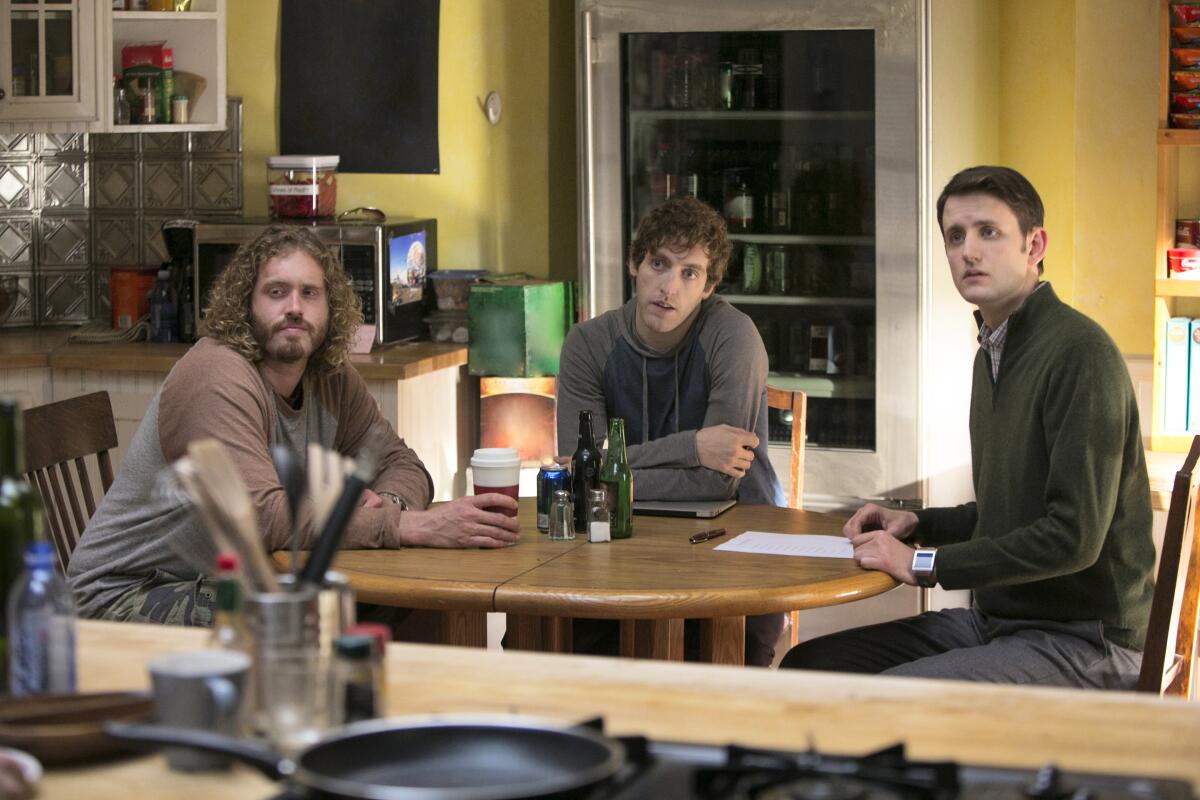
2014 | TV-MA | 6 Seasons | TV Comedies
Mike Judge, John Altschuler and Dave Krinsky
“Silicon Valley” is a great one, focused on a pack of young software writers suddenly making a noise in the new tech gold fields in and around Palo Alto. It is in some respects a sequel to “Office Space,” which set the style — naturalism shading into the surreal — for a generation of cubicle comedies. Thomas Middleditch plays Richard, who lives with fellow coders Gilfoyle (Martin Starr), Dinesh (Kumail Nanjiani) and Big Head (Josh Brener) in a house overseen by Erlich (T.J. Miller), a former hacker exchanging room and board for a piece of whatever apps his tenants create. It is in its way a New West western, a story of men not quite without women, but not really with them. Their approach to sex, and to the opposite sex, commingles fear and respect in a way that’s almost refreshing. (Read more) —Robert Lloyd
37. Flight of the Conchords
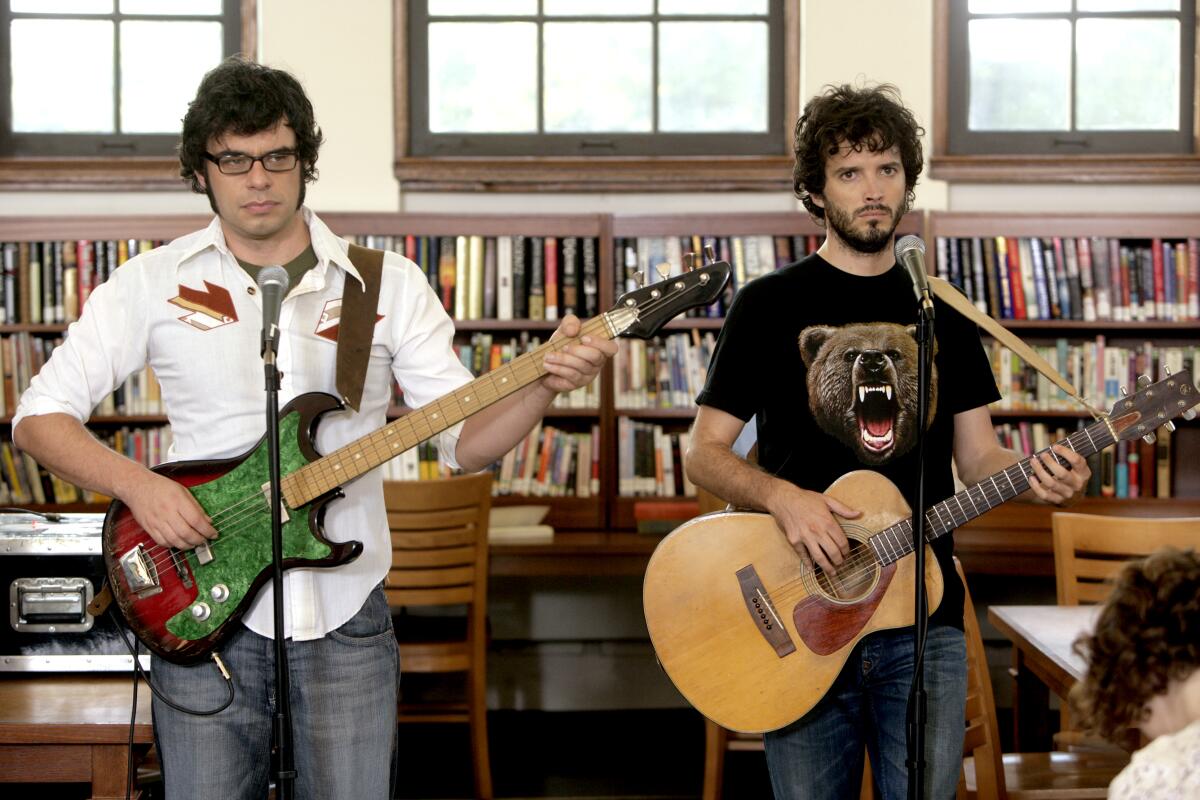
2007 | TV-14 | 2 Seasons | TV Comedies
James Bobin, Jemaine Clement and Bret McKenzie
A bigger hit than I am sure anyone connected with the show expected it to be, “Flight of the Conchords” tells the story of Bret (Bret McKenzie) and Jemaine (Jemaine Clement), a New Zealand folk-rock-pop-rap-soul duo seeking fame, or at least a paying gig, in New York, New York. If you can make it there, you can make it anywhere; but they can’t make it there, or anywhere. Mixing the ironic whimsicality of “Curb Your Enthusiasm” with the premise and structure of “The Monkees,” “Conchords” was twice as delightful when it landed for being so unexpected and unpredictable. That the two men are in their 30s makes their perseverance more poignant and that they have no money places them in a long and honorable line of comedians who cannot put two cents together to buy a glass of seltzer. Fundamentally good-natured, if never what you’d call cheerful — except during musical fantasy interludes — they continually betray each other, because they are easily misled and distracted and because they are so ill-informed about the workings of the world. Although it makes excellent use of real locations, this is a show with a most tenuous connection to reality. (Read more) —Robert Lloyd
36. Perry Mason

2020 | TV-MA | 2 seasons | Legal dramas
And so another old crime show is brought down from the attic, dusted off and given a fresh coat of paint. “Perry Mason,” which most famously ran from 1957-66 on CBS, with Raymond Burr as the infallible defender of the defenseless, is back as a long-arc series.
New Perry, in the lean and hungry-looking person of Matthew Rhys, is a former farm boy, living with a skinny cow on what remains of his parents’ spread. Perry has an ex-wife and a 9-year-old son living in Salinas and a single suit in need of a good cleaning. (Lacking a tie without a mustard stain, he hits up a friend in the coroner’s office to see what effects the dead might have left behind.) He had some bad times in World War I, which haunt him in flashbacks. He is drunk between hangovers and perennially unshaven, like a Halloween hobo.
Into this literal mess steps attorney and old family friend Elias Birchard “E.B.” Jonathan (John Lithgow), who enlists Perry, a private investigator, to look into the death of a kidnapped infant on behalf of one Herman Baggerly (Robert Patrick), one of those wealthy types who have a habit of turning up in stories like this.
Yes, yes, you say, but what of Della Street? What of Paul Drake? Della (Juliet Rylance) is here, introduced as Jonathan’s legal assistant, and she is given an identity, and a sexual identity — a woman before her time not content to wait for time to catch up with her and seemingly the inventor of jury analysis. The third major canonical character, investigator Paul Drake (Chris Chalk), will arrive as a Black L.A. police officer whose rising level of disgust with his superiors, along with certain things he has uncovered regarding the case at hand, will usher him eventually onto Team Mason. (Read more) — Robert Lloyd
35. Angels in America

2003 | TV-MA | 1 Season | LGBTQ TV Shows
Adapted by Mike Nichols from a play by Tony Kushner
“Angels in America” is not just about a time; it’s about all of time. The lives of the five New Yorkers on which the plot hinges (plus the respective friends, family members and caretakers who alternately haunt, visit and minister to them) are just pinpoints on a timeline that aims to span the whole shebang from creation to apocalypse. Appropriately, the angels of the title come in all sorts of celestial, terrestrial, hallucinatory and ghostly forms. (Emma Thompson, Meryl Streep and Jeffrey Wright take on roughly seven of these among the three of them.) All hands are needed on deck here: It takes at least this many guides and guardians to help the main characters through their crises of faith and transformations. (Read more) —Carina Chocano
34. Steven Universe
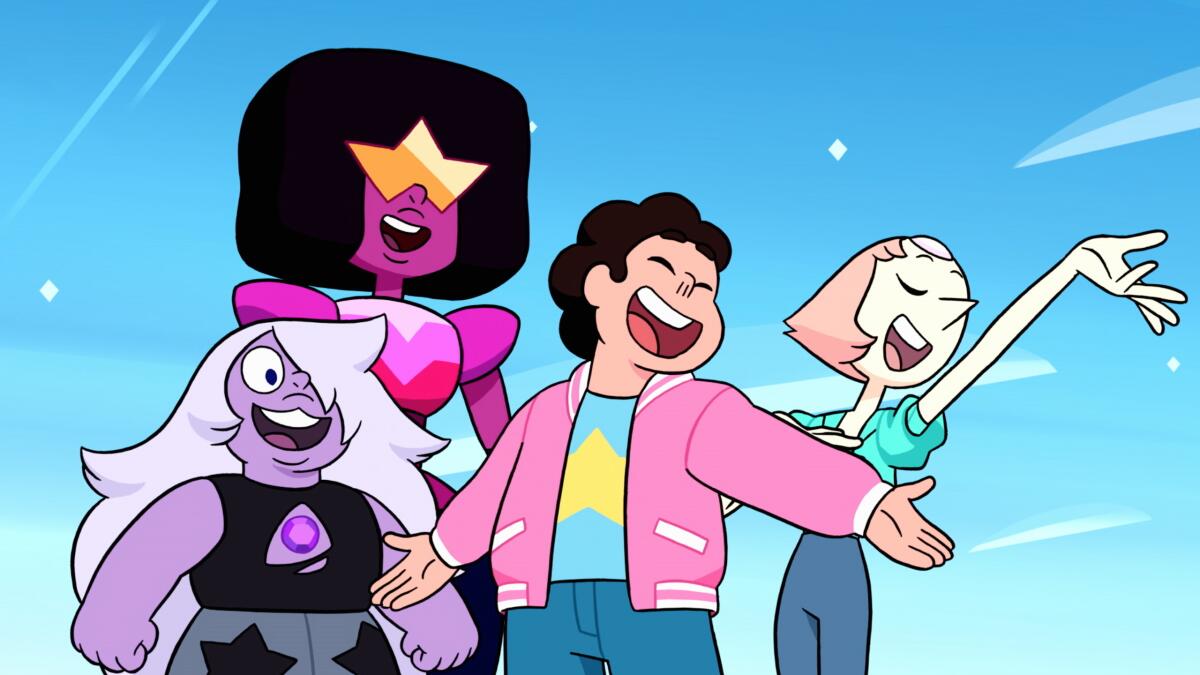
2013 | TV-PG | 5 Seasons | LGBTQ TV Shows
Created by Rebecca Sugar
When “Steven Universe” debuted in 2013, it introduced the world to a half-human, half-magical teen who loves his friends and family, is enthusiastic about food and is eager to prove that he’s ready to save the world. Guiding Steven (voiced by Zach Callison) along his journey are Garnet (Estelle), Amethyst (Michaela Dietz) and Pearl (Deedee Magno Hall) — a team of extraterrestrial beings known as the Crystal Gems who have sworn to protect Earth. Over the course of five seasons, Steven and the Crystal Gems face powerful threats and learn uncomfortable truths about the past. But it’s the characters and their relationships that are central to the show. “Steven Universe’s” greatest legacy is repeatedly breaking new ground for LGBTQ representation in kids’ cartoons. Not only does the fantasy/sci-fi series include a range of recognizably queer and nonbinary characters, but it has also featured a same-sex proposal and wedding. This inclusive storytelling has resonated with fans and is among the reasons “Steven Universe” has been hailed by critics. (Read more) —Tracy Brown
33. Barry
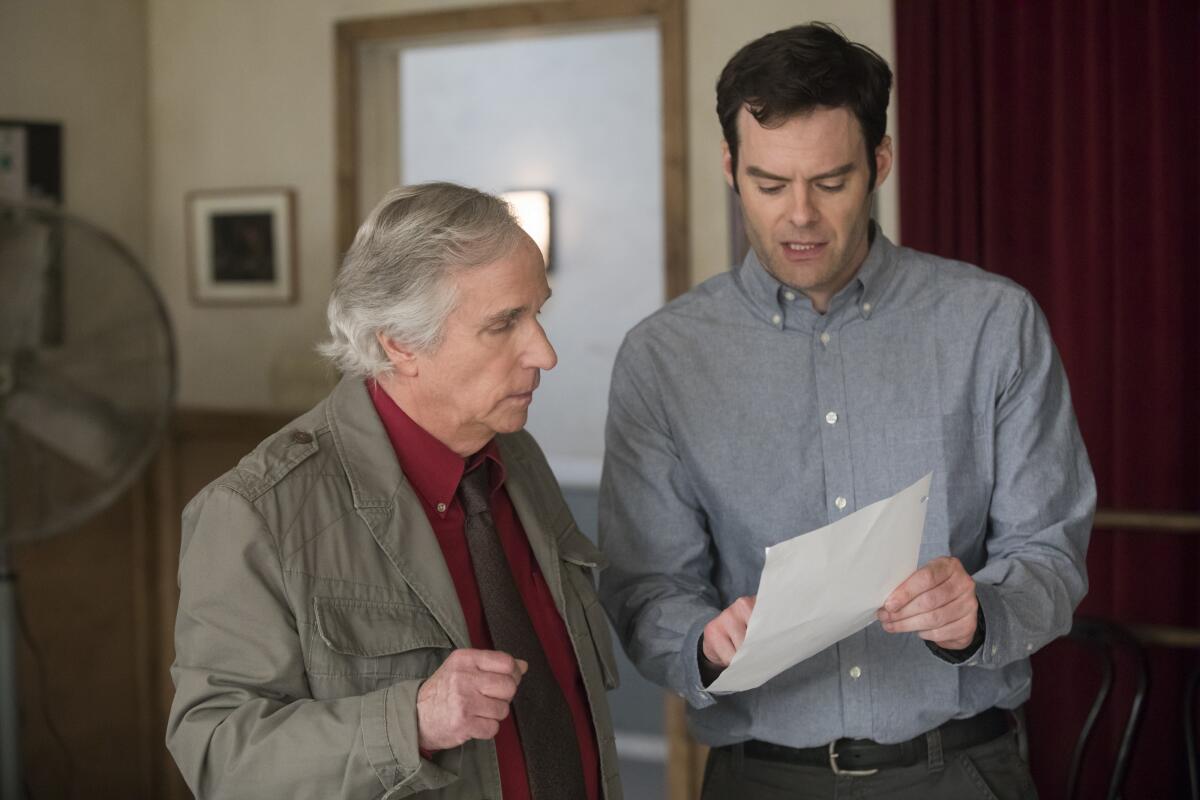
2018 | TV-MA | 4 Seasons | TV Comedies
Created by Bill Hader and Alec Berg
Acting or killing? Barry Berkman (Bill Hader) is at a crossroads in his career when we meet the U.S. Marine turned hitman in HBO’s dark comedy drama “Barry,” created by Hader and Alec Berg. After traveling from Cleveland to L.A. for a “job,” he misses his intended target but finds inspiration in the city’s local theater scene. Thanks to his new, aspiring actress girlfriend Sally Reed (Sarah Goldberg) and self-aggrandizing drama coach Gene Cousineau (played by the fabulous Henry Winkler), Barry is all of a sudden more interested in method acting techniques than whacking Chechen mobsters or dusting drug dealers. But the more he tries to leave his deadly profession behind, the more complicated his double life becomes, especially when his partner-in-crime Monroe Fuches (Stephen Root) becomes involved. As the lies snowball and the bodies pile up between contact hits and mandatory rehearsals, the mayhem pushes “Barry’s” pacing from a saunter to a mad dash. (Read more) —Lorraine Ali
32. Doctor Who
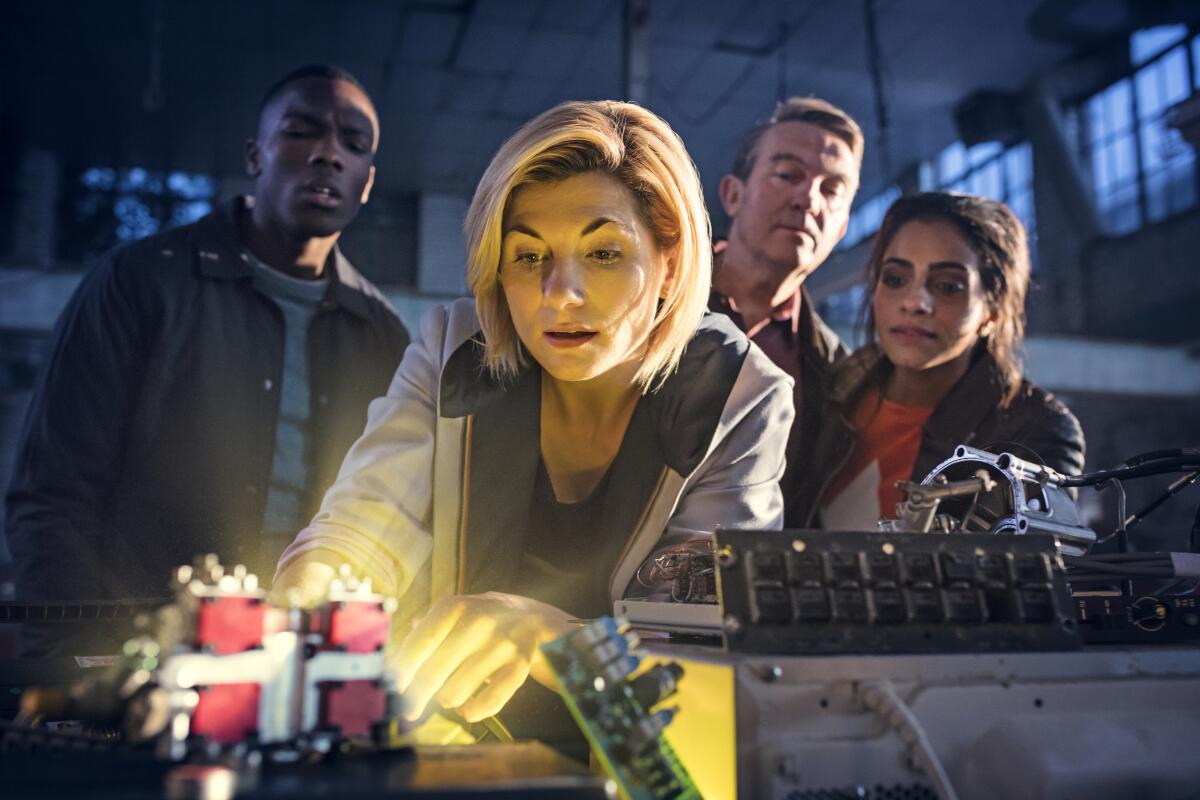
2005 | TV-PG | 13 Seasons | Science fiction
Finally, the Doctor is a woman. Jodie Whittaker became the Thirteenth Doctor in 2018 when she replaced Peter Capaldi as the star of the long-running British science-fiction adventure series “Doctor Who.” And yet it is very much like all such steps before it: One actor passes the role to another; the Doctor — a Time Lord from the planet Gallifrey — takes on a new form and personality, which is not entirely distinct from his, now her, preceding selves. Thus has it been since an ailing William Hartnell, who played the First Doctor, transformed into Patrick Troughton, Doctor Two, in 1966 — an invention mothered by necessity. After 55 years, 36 seasons, one TV movie and 12 officially numbered Doctors, to have gone with yet another white male — in a series where everything is possible — would have seemed almost pointless. The human characters, some of whom will continue in the Doctor’s company — the Doctor likes company — are seemingly regular folks whose most extraordinary shared ability is to accept the apparently impossible without losing their minds. (Read more) —Robert Lloyd
31. Hacks
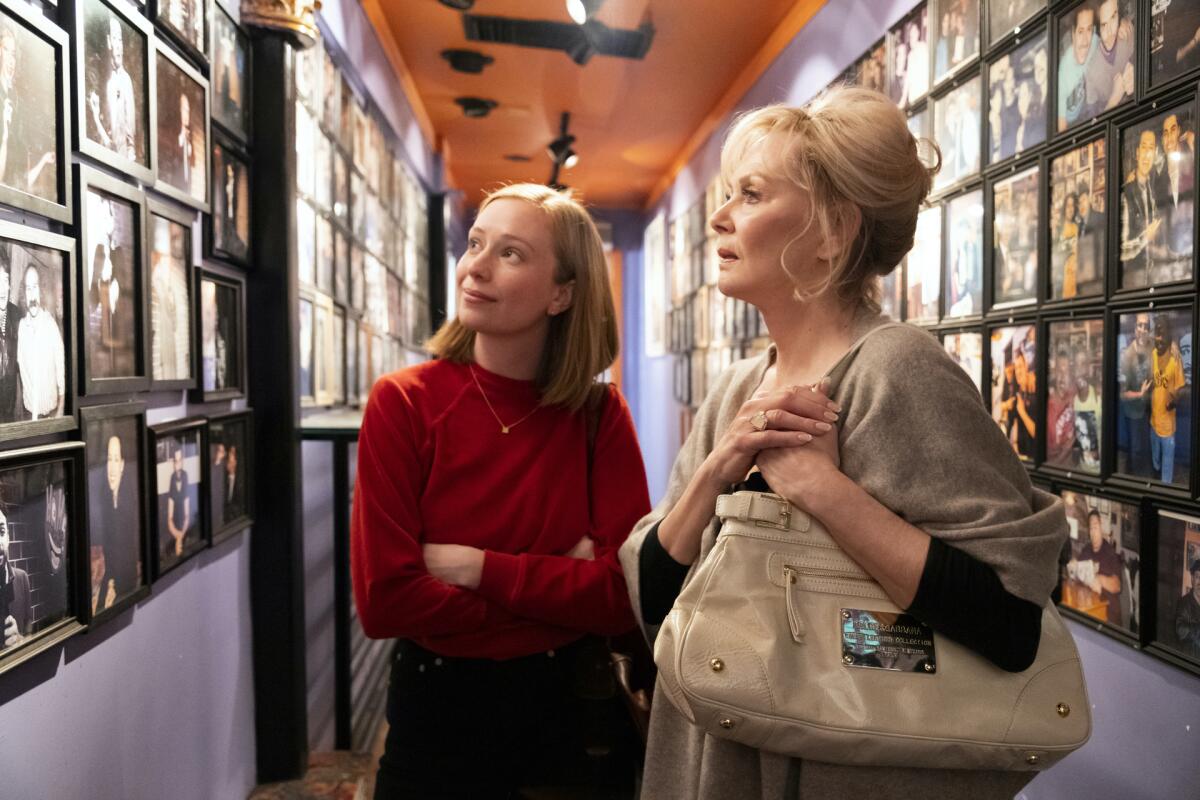
2021 | TV-MA | 2 Seasons | TV Comedies
Created by Paul W. Downs, Lucia Aniello and Jen Statsky
In “Hacks” Jean Smart plays comedy legend Deborah Vance, a Las Vegas-based comedian at the dawn of the twilight of her career, who reluctantly hires a young comedy writer (Hannah Einbinder) who is facing what might be the end of hers. Once upon a time Deborah was on the cover of Time and starred in a sitcom with her husband, who left her for her sister. That Deborah is supposed to have burned down his house has not exactly ruined her. She lives in a home that is big enough to contain half a dozen others, owns a private plane, is prepared to spend $10,000 for a pepper shaker, has set a Vegas performance record and is about to have a street named after her (“It’ll probably be a dead end with an abortion clinic on it”). Ava (Einbinder) has become professionally toxic on account of a tweet about a “closeted senator.” Twenty-five years old, she has been cast out of the writers room on a hit show, and no one seems interested in gathering her in, given an attitude of entitlement and a greater capacity to be offended than to take direction; her alienated old friends regard her as “a career-obsessed opportunist.” (Read more) —Robert Lloyd
30. The Larry Sanders Show

1992 | TV-MA | 6 Seasons | TV Comedies
Created by Dennis Klein and Garry Shandling
Garry Shandling’s real legacy begins with “The Larry Sanders Show,” in which he played a neurotic talk-show host whose life might have in some respects resembled his own. To my mind, this is where the new age of television — call it Golden or whatever you like — really begins. This is where the curtain comes up, where the walls fall. It’s a show that didn’t settle for light or dark, for funny or not funny, for good people or bad; it was farcical and naturalistic at once, emotionally naturalistic, visually new — it had a documentary swing based on the exigencies of a low budget — critical and compassionate, hilarious and deep. It is a box to hold everything. And everything it was proceeded from the creator-star’s demands not just for a new kind of series but a new way of making one, with consciousness and (a word he used repeatedly) “courage.” (Read more) —Robert Lloyd
29. Anthony Bourdain: Parts Unknown

2013 | TV-14 | 12 Seasons | Reality TV
Created by Anthony Bourdain
“Anthony Bourdain: Parts Unknown” acknowledges the ill with the good but lives in hope — sometimes unspoken, often stated — that better things are ahead and that they will be delicious. It is an anti-nationalist project steeped in local pride: All localities, it suggests, are worth knowing, and every culture, worth respect. Where most travel-based shows have a touristic bent, Bourdain’s, which ranged from Korea to Koreatown, Iran to Antarctica, Chicago to Shanghai to Borneo to Senegal, were never about where you, as a viewer, as a consumer, could go — he often went places you couldn’t — and what to do when you got there. The message is that true luxury is in the learning and the company, in being human among humans and earthy upon the Earth. And while ”Parts” looked with passing interest on the fancy works of mankind, it repeatedly came back to the land — including the sea — and how it shapes those who live on it, and off of it. (Read more) —Robert Lloyd
28. Batman: The Animated Series
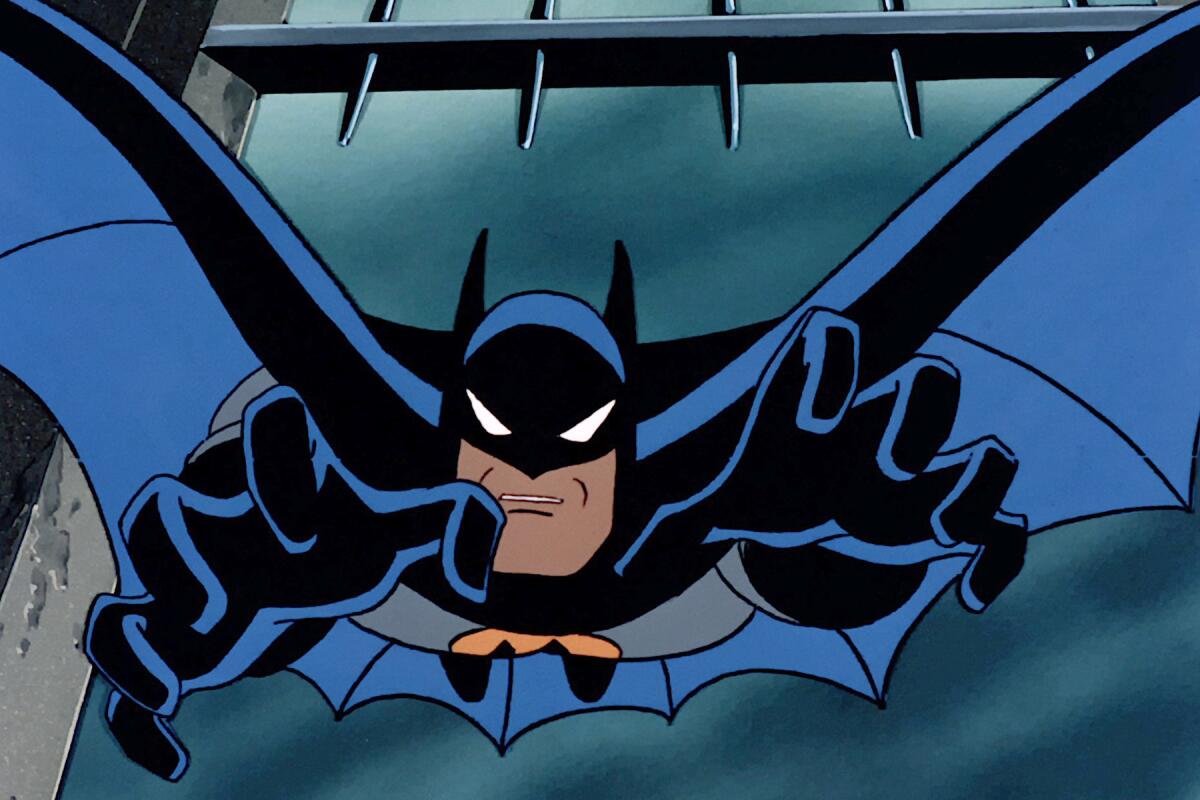
Batman (voiced by Kevin Conroy) jumps to Gotham’s defense.
1992 | TV-PG | 3 Seasons | TV Shows Based on Comics
Created by Eric Radomski and Bruce Timm, based on characters created by Bob Kane and Bill Finger
Forget all the listicles that rank and re-rank the many “Batman” movies whenever a new incarnation of the Caped Crusader hits the big screen: The best “Batman” is on television. “Batman: The Animated Series,” which originally aired from 1992 to 1995, remains a standout for its stylish aesthetics, noir tone and complex storylines. Despite being an afternoon kids’ show, this “Batman” is dark and moody and does not shy away from violence — though the Dark Knight himself has a strict moral code when it comes to how he takes down criminals. The series can also boast introducing lasting characters into DC’s canon, including the now-iconic Harley Quinn and Gotham PD’s Renee Montoya. —Tracy Brown
27. Deadwood
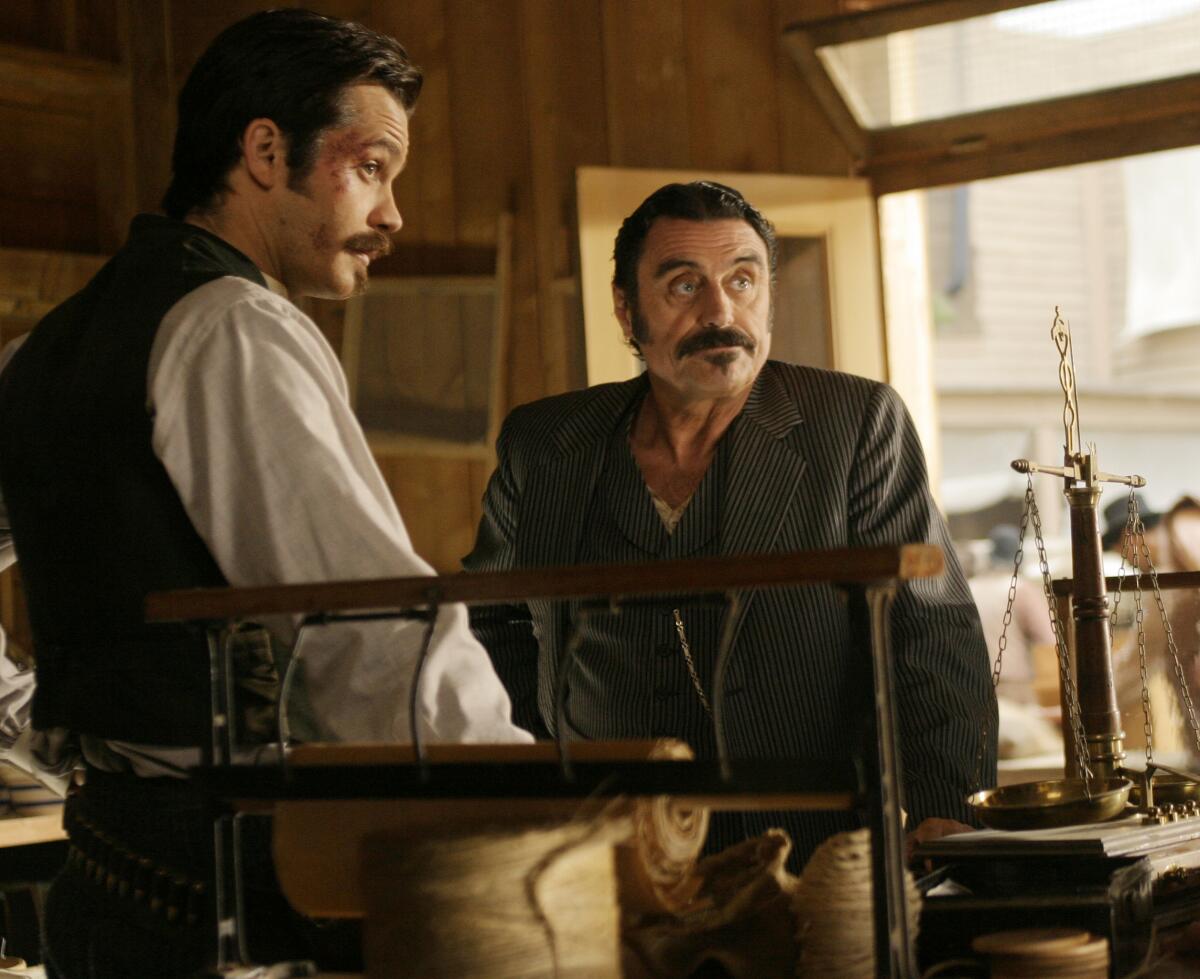
2004 | TV-MA | 3 Seasons and a movie | Western Dramas
Created by David Milch
What many viewers will notice first in the western series “Deadwood” is its language, which is filthy. And series creator David Milch — a published poet who taught English at Yale for several years — is too particular about words to use them gratuitously. “Deadwood,” which you are free to regard as simply an involving multithread tale of bad guys and better guys set during the last great gold strike in the continental United States, is set on a deeper foundation. “Deadwood” came with a ready-made cast of characters: Vice merchant Al Swearengen (Ian McShane), sheriff turned businessman Seth Bullock (Timothy Olyphant) and his partner-in-hardware Sol Star (John Hawkes); Wild Bill Hickok (Keith Carradine) and Calamity Jane (Robin Weigert). And Merrick, the newspaper publisher (played by Jeffrey Jones); E.B. Farnum (William Sanderson), the sleazeball who ran the Grand Central Hotel — those are real people. It is jarring at first, hearing those types of words coming from the mouths of cowboys, given all those years of “Bonanza” and “Gunsmoke” and the almost Puritan rectitude of John Wayne and Gary Cooper. But language in “Deadwood” is used to reveal character. Who curses to whom about what and when establishes their relationship to one another and to the world. (Read more) —Robert Lloyd
26. The Fresh Prince of Bel-Air
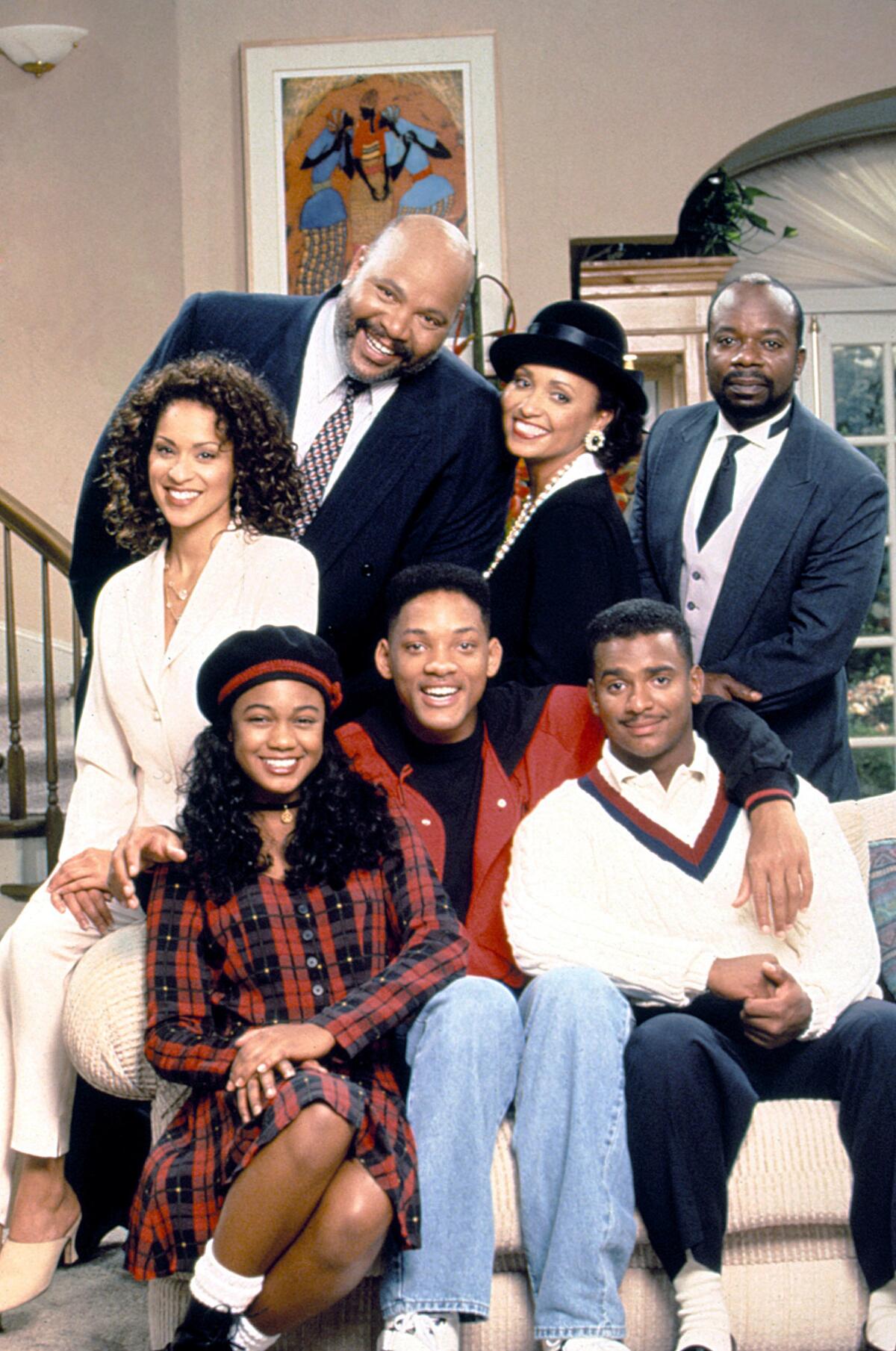
1990 | TV-G | 6 Seasons | TV Comedies
Executive producer Quincy Jones; creators Andy and Susan Borowitz
“The Fresh Prince of Bel Air” revolves around Will, an inner-city teen from Philadelphia (played by real-life rap star Will Smith) who moves in with his stuffy, wealthy relatives in Bel-Air to escape from getting into trouble back home. Will’s street smarts frequently clash with the country-club values of his family, who, for the most part, seem to have lost touch with their cultural roots. One of the main targets of Will’s barbed wit is his pompous, Ivy League college-bound cousin Carlton (Alfonso Ribeiro), whose main enjoyment in life appears to be a good game of golf. Will’s new environment and his enrollment at the fictional Bel Air Academy also put him into conflict with his old street-wise friends. The family and butler are mystified, bewildered and, at times, horrified by Will’s antics and lingo. (Read more) —Greg Braxton
25. The Big Bang Theory

2007 | TV-14 | 12 Seasons | Comedy
Created by Chuck Lorre and Bill Prady
There’s the Big Bang Theory in science that explains how the universe began from a staggeringly hot, dense point roughly 13.7 billion years ago. But millions are more familiar with the other “Big Bang Theory”—the one that’s been on CBS for 11 years. And in the cosmos of modern-day television, it stands out like a shining star.
True, this multi-camera series was not the most buzzed-about comedy on the small screen and its broad, safe humor doesn’t exactly make it a sparkplug in the critical think-piece culture. And, yes, its awards success may lag far behind other comedies such as “Modern Family” or “Veep.”
But against all odds, “The Big Bang Theory” established itself as one of the pillars of the prime-time scene. It was one of CBS’ most reliable hits on one of television’s most popular nights. It launched a successful spinoff, made millionaires out of its previously little-known cast, employed hundreds of actors and crew members and served as a potent springboard for other new CBS comedies.
Conceived by Bill Prady and Chuck Lorre — who was riding high on the success of “Two and a Half Men” — “The Big Bang Theory” was inspired by the personalities Prady encountered during his pre-Hollywood career as a computer programmer.
Leonard and Sheldon — played by Johnny Galecki and Jim Parsons, respectively — are socially challenged physicists working at Caltech with an across-the-hall neighbor who is a waitress with Hollywood ambitions, played by Kaley Cuoco. Their friends are aerospace engineer Howard Wolowitz (Simon Helberg), and astrophysicist Raj Koothrappali (Kunal Nayyar). (Read more) — Yvonne Villarreal
24. The Leftovers

2014 | TV-MA | 3 Seasons | TV Dramas
Executive producer/director Mimi Leder; creators Damon Lindelof, Tom Perrotta
“The Leftovers” is based on Tom Perotta’s novel of the same name about the sudden vanishing of 2% of the world’s population, and its lingering effect on a handful of churning souls: the questioning, the bereft, the deadened and the raging. Families struggled, cults formed, life went on and sometimes that seemed impossible to accept. There would be no explanation for the Departure, just an empathetic microscope on the survivors. The series became a haunted, liberating, sometimes frustrating, always analyzed, and in-the-end burnished gem. It was difficult viewing that you had to watch because inside it was unexpected humor (eventually), surreality (the beloved “International Assassin” episode), and some amazing grace. (Read more) —Robert Abele
23. Station Eleven

2021 | TV-MA | 1 Season | TV Drama
“Station Eleven” is a post-post-apocalypse tale, set largely two decades into the future — 2040 by the series’ timeline — and also just as and some time before a flu pandemic wipes out nearly everybody on Earth. The years of chaos have largely passed, and the survivors we meet, in the environs of the Great Lakes, live a largely communitarian, pastoral life, free from the usual neo-feudal warlords and Mad Max types; it is more Renaissance Faire than New Dark Ages.
Like Emily St. John Mandel’s 2014 novel, on which it’s based but from which it departs significantly in details, events, characters and characterizations, it jumps between periods to build out character relations and motivations, and to plant the seeds of coincidence that will flower into closure.
The first images in the series are of a Chicago theater overtaken by wildlife, which quickly flash back to “the present” — Christmas 2020 — where Arthur Leander (Gael García Bernal), a stage actor turned movie star returning to the stage, has a heart attack while playing King Lear; and Jeevan Chaudhary (Himesh Patel), an EMT in training, goes onstage to try to help and later takes charge of Kirsten (Matilda Lawler), a child actor whose caretakers have vanished. In the course of attempting to deliver her to her parents, Jeevan gets a call from his sister, an emergency room doctor, who tells him to take cover.
Twenty years later in a brave new world with significantly fewer people in it, Kirsten, now played by Mackenzie Davis, is a member of the Traveling Symphony, a collective of itinerant actors and musicians who perform Shakespeare to small communities in a circuit around Lake Michigan they call “the Wheel” and to which they adhere with almost superstitious rigor. “We try to make the world make sense for a minute,” says the Conductor (Lori Petty), who composes for and leads the orchestra.
Modern technology is a thing of the past — cars and trucks are drawn by horses now — but art has survived. What ought to be preserved and what should be left behind is a central theme that determines the course of more than one relationship. (Read more) — Robert Lloyd
22. Friends

1994 | TV-PG | 10 Seasons | TV Comedies
Created by Marta Kauffman, David Crane and Kevin Bright
The sexy, urbane “Friends” starts fairly strongly with its premiere, improves with its second episode and in week three gets on a grand, hilarious, rip-roaring roll. Its first episode has the burden of sorting out the major characters in this communal comedy, six singles in their 20s who spend much of their time slouching around — in their spacious pad and in the casual cafe/coffee house where some of them work — talking about being single. It sounds vacuous, and it is, sort of, but wittily vacuous, with crisply written dialogue adroitly executed by the show’s strong ensemble cast: Courteney Cox, David Schwimmer, Jennifer Aniston, Matthew Perry, Lisa Kudrow and Matt LeBlanc. If there is a hub character here, it is Cox’s Monica, an assistant chef whose passive brother (Schwimmer) moves in with the group after his wife leaves him for a woman. All of the characters are likable and funny, though. “Friends” has so many good moves that there’s really nothing to dislike. It’s all so light and frothy that after each episode you may be hard-pressed to recall precisely what went on, except that you laughed a lot. (Read more) —Howard Rosenberg
21. Chernobyl
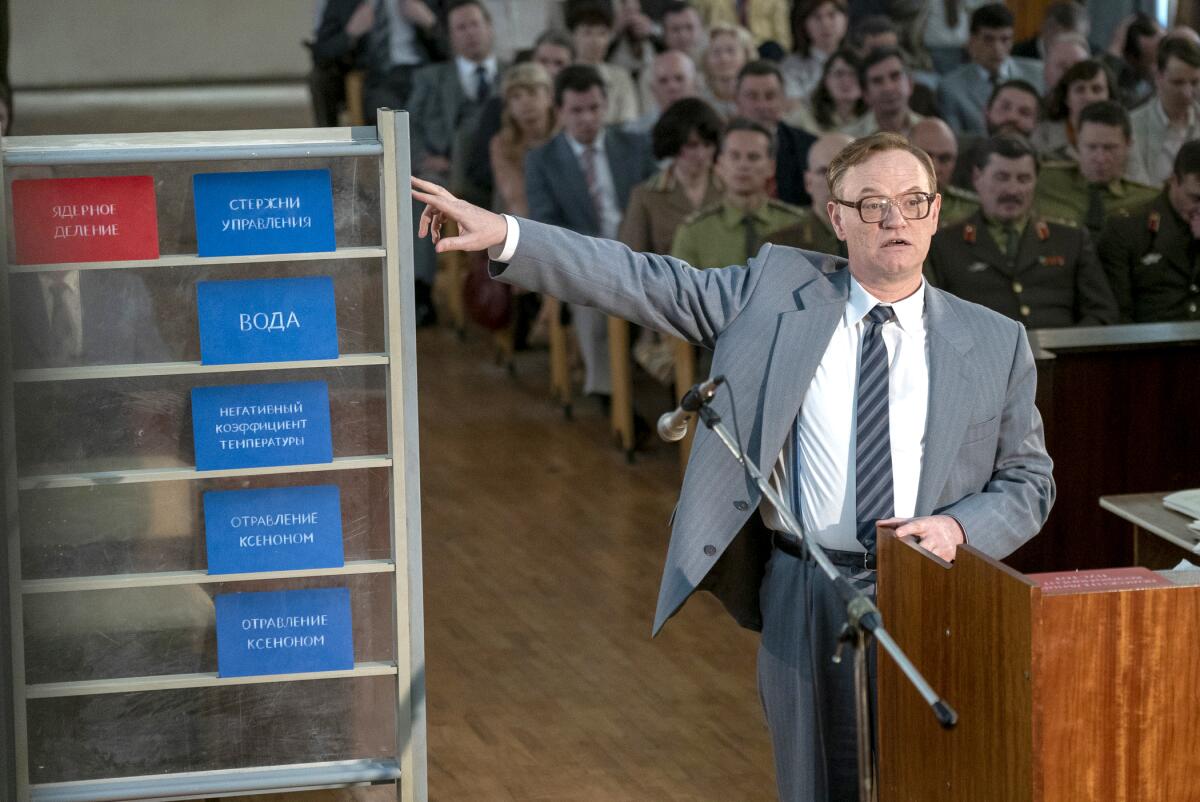
2019 | TV-MA | 1 Season | TV Dramas
Written by Craig Mazin and directed by Johan Renck
The worst nuclear disaster in history is the setting for HBO’s powerful and haunting five-part drama, “Chernobyl,” where state secrets are pitted against the welfare of the people after a reactor ruptures early one spring morning in 1986. As if the Soviet Union wasn’t grim enough without a blanket of radioactive haze blocking out the industrial pollution that blocks out the clouds that block out the sun. The miniseries chronicles the events surrounding the April 26 explosion of the Chernobyl nuclear power plant in the northern Ukraine region of Pripyat and does so in terrifying detail. “Chernobyl,” however, is not a horror show. It’s a suspenseful, tragic and illuminating drama about government corruption, systemic incompetence and the unyielding will of the people to drag their country back from the brink of ruin as they have done time and time again after coups, wars, fallen regimes, invasions, famine and more. (Read more) —Lorraine Ali
20. The Night Of
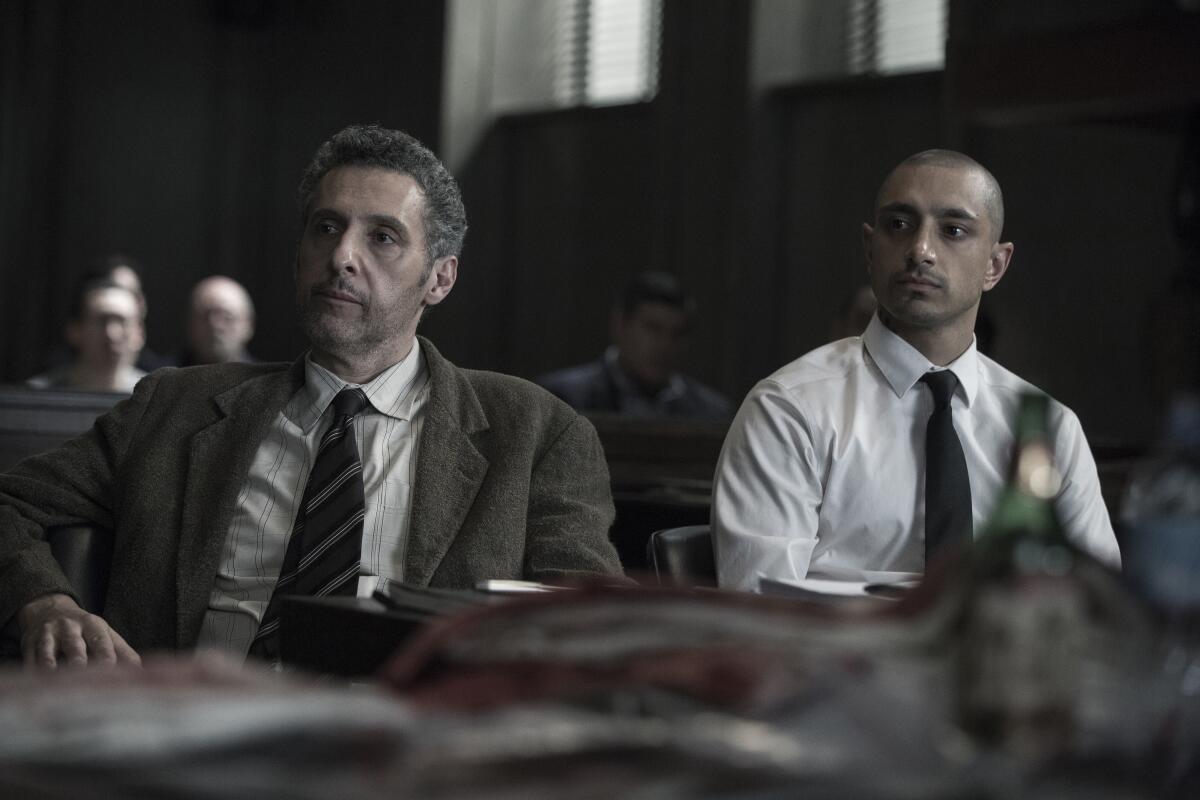
2016 | TV-MA | 1 Season | TV Dramas
Created by Steven Zaillian and Richard Price
Questions of intent, guilt and bias permeate HBO’s powerful “The Night Of,” an eight-part crime and justice miniseries set in the immigrant enclaves of Queens, the courtrooms of Manhattan and the jail cells of Rikers. American Muslim college student Nasir Khan (Riz Ahmed) lives a quiet life in the outer boroughs with his Pakistani parents until taking his father’s cab for a joy ride into the city. There he meets a girl and does drugs with her, only to awaken later next to her bloodied, lifeless body. Did he stab her to death? Enter dogged detective Dennis Box (Bill Camp), disheveled defense attorney John Stone (John Turturro) and, eventually, fellow inmate Freddy Knight (Michael K Williams).
An artful whodunit that exposes uncomfortable truths about race, the justice system and the role of the media in deciding a defendant’s fate before they ever enter the courtroom, “The Night Of,” based on the 2008 British miniseries “Criminal Justice,” also does what other series featuring American Muslim characters (“Homeland,” “Sleeper Cell”) do not. Through subtle and nuanced storytelling, its Muslims become central to a story that’s not about terrorism, war or Trump. And while Islamophobia plays a role here, it’s rich characters like Nasir and the Khans, and the reactions of peers in their Jackson Heights neighborhood, that make “The Night Of” an authentic portrait of what it feels like be Muslim in America since 9/11. Fear permeates. (Read more) —Lorraine Ali
19. Sesame Street
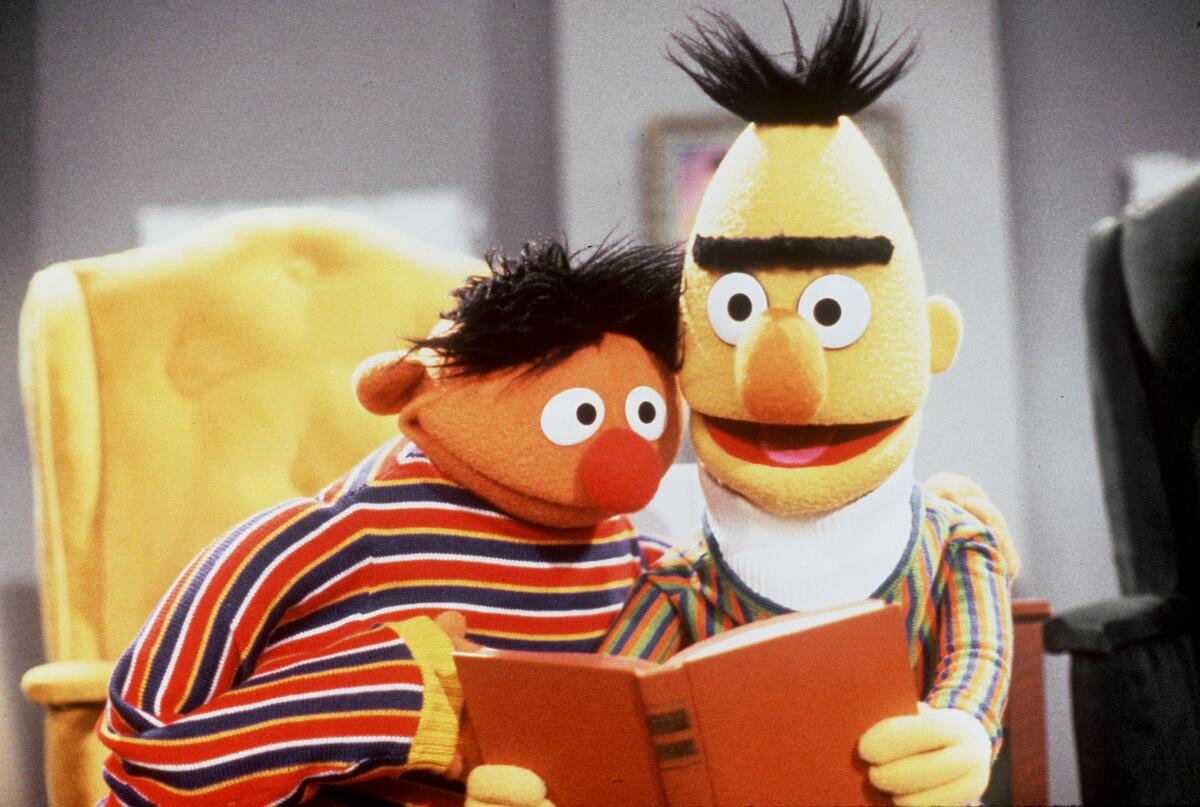
1969 | TV-Y | 18 of 53 seasons | Kids’ TV
Created by David D. Connell
“Sesame Street” was conceived as an instrument of learning and uplift. It was largely meant to give a leg up to disadvantaged kids and to get parents involved by putting on a show that was also attractive to them. It looked like nothing else on television, showcasing independent animation at a time when that art was elsewhere reaching new lows. And it had Muppets, who came from the world of grown-up show business and added — although it’s odd to say — sophistication to the mix. And then there was the setting: Where most kids’ shows took place within some snug refuge, a Treasure House or a Nice Man’s Living Room, “Sesame Street” is set on the sidewalk, and therefore in a community, in what was clearly the city of New York — a funky working-class neighborhood where laundry dries on clotheslines and trash cans sit by the stoop. (They cast the brownstone steps in concrete so they would sound right when anyone pounded up or down them.) Radically — really, radically, in 1969 — it prominently featured Black actors (and Latino and Asian soon afterward). The series remains peerlessly multicultural and multicolored — blue, orange, red, green, yellow, purple, all the primary and secondary hues, plus the usual variations on black, white and brown. It is here for your children, and for all the right reasons. (Read more) —Robert Lloyd
18. Getting On
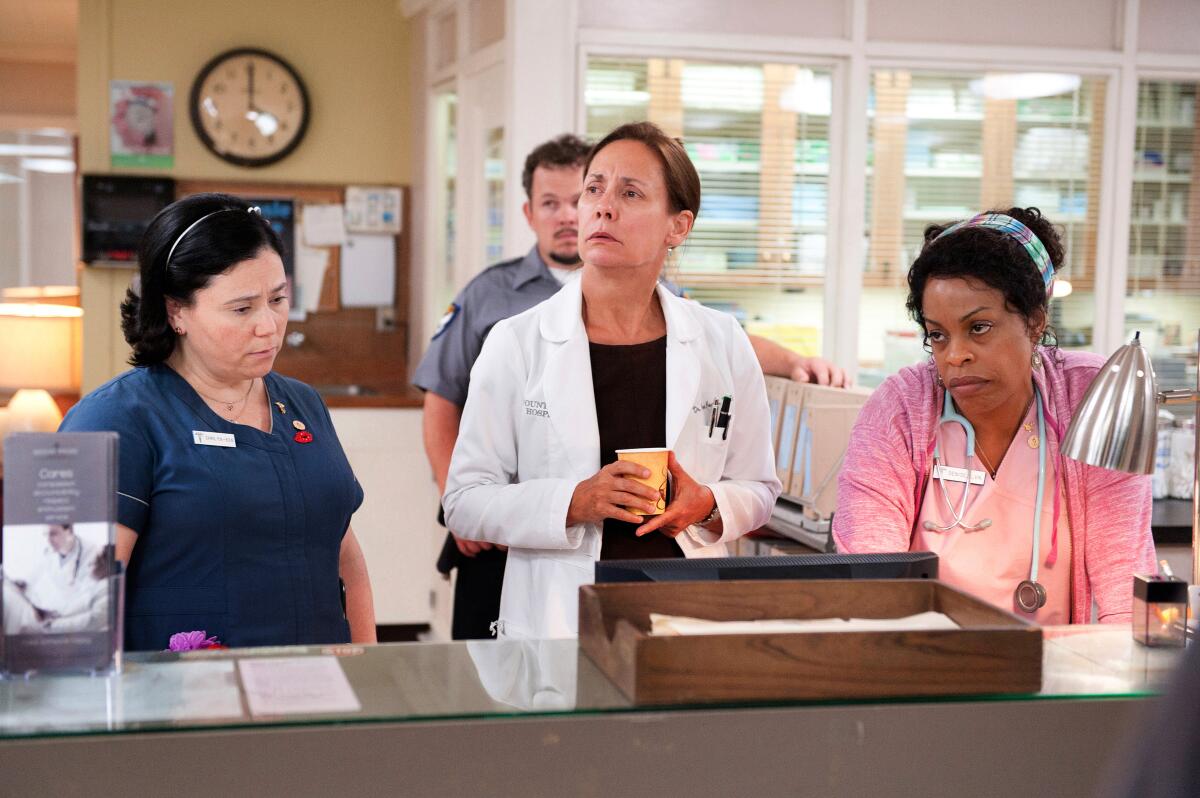
2013 | TV-MA | 3 Seasons | TV Comedies
Created by Will Scheffer and Mark V. Olsen
HBO’s comedy “Getting On” is a dark and astonishing gem of a show, with a bravely skillful cast juggling the petty obsessions of the workplace with Much Bigger Issues. Not just life and death, age and loneliness, but also stickier questions about compassion and care, about what we owe one another and what we are owed ourselves. It sets the standard for the emerging “hospice humor.” You will laugh and you will wince, and you will see yourself and those you love. Nurse Dawn (Alex Borstein) is the self-involved and self-defeating center of the series. We meet Dawn as she is “training” new nurse Denise/DiDi (Niecy Nash), a process that includes explaining to her the byzantine procedure that must be followed after a patient has an accident on a chair. This event requires an exchange about the use of the word “feces” that plays like a 21st century “Who’s on First,” and quickly sets the tone for the show. “Getting On” acknowledges the realities of bodies that are aging and ill, and the creators and cast are not afraid to take a joke one beat too far, pushing it to the often uncomfortable realm of protest-absurdity. But there they do not wallow. Sometimes feces is just feces, and sometimes it’s a metaphor. (Read more) —Mary McNamara
17. The Knick
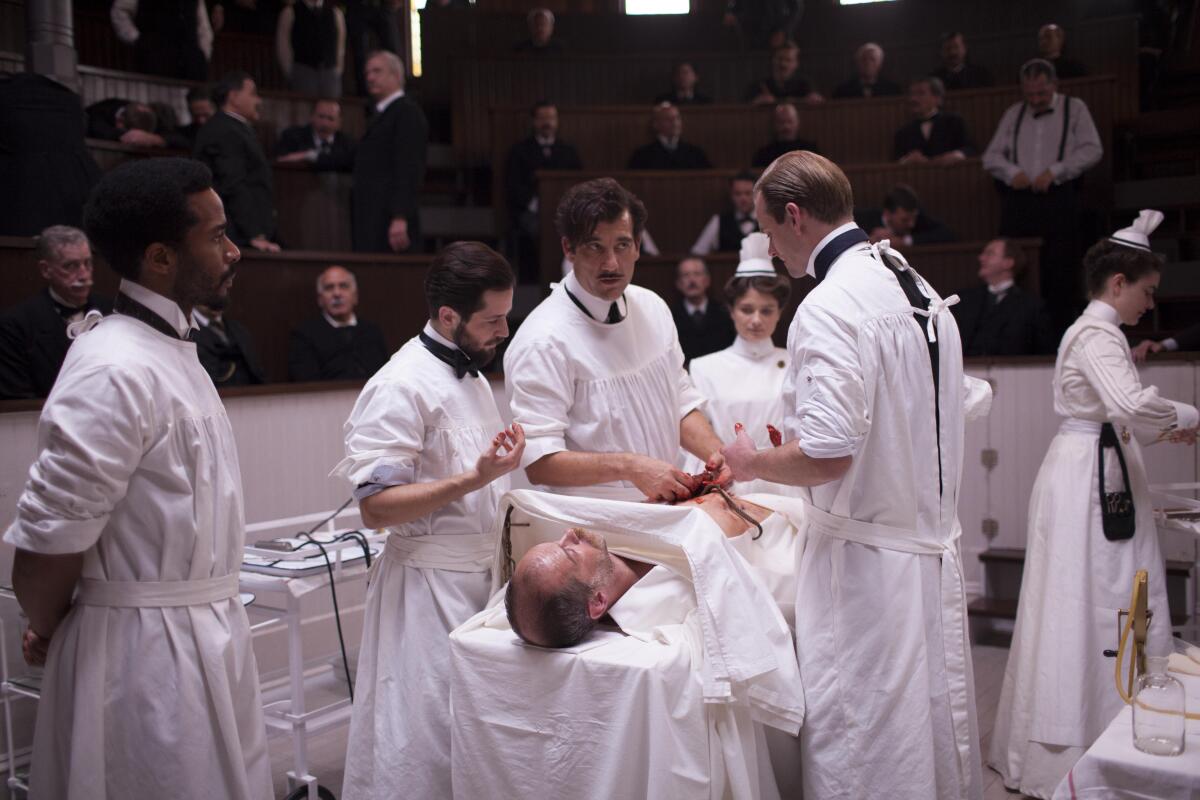
2014 | TV-MA | 2 Seasons | TV Dramas
Created by Jack Amiel and Michael Begler; directed by Steven Soderbergh
In “The Knick,” a period medical drama, an excellent Clive Owen, looking not a little like Edgar Allan Poe, plays Dr. John Thackery, a brilliant, visionary, often arrogant surgeon seeking to complete the work left undone by his late mentor, Dr. J.M. Christiansen (Matt Frewer). Christiansen’s mentoring included the use of cocaine as a work aid, and within the first few minutes of the series, we see Thackery, in the back of a horse-drawn cab, give himself a shot between his toes. The drug, which is also in use through the series as an anesthetic, is to “The Knick” what cigarettes are to “Mad Men” — a thing whose badness was understood but not yet accepted, and an occasion now for rueful retrospective humor. The hospital is cash-strapped and dependent on the support of progressive philanthropist Cornelia Robertson (Juliet Rylance), which allows certain things to occur, most notably the unlikely hiring of an also-brilliant, also-visionary Black surgeon (André Holland as Dr. Algernon Edwards). Thackery will remind you of Dr. Gregory House. The series is often bloody and full of body parts, I suppose I should say, though nothing that viewers of forensic procedurals haven’t seen a thousand times. (Read more) — Robert Lloyd
16. Curb Your Enthusiasm

2000 | TV-MA | 11 Seasons | TV Comedies
Created by Larry David
Larry David is an acquired taste. For some of us, it takes about 10 seconds. David, who co-created “Seinfeld,” stars in “Curb Your Enthusiasm,” a series that’s meant to track the daily minutiae of his professional and dysfunctional personal lives in Los Angeles. Funny and wickedly weird, David plays himself improvisationally in front of fluid hand-held cameras, as he did in the 1999 comedy special from which the series was spun. This cinema-verite style and chatty tone are perfectly suited for the material, for you have no sense here of anyone acting. Surely exaggeration is a factor. If this is anything approaching the real David, though, draw your own conclusions. The one on the screen lopes instead of walks, finds everyday life challenging, if not frightening, and always looks like he’s trespassing, even in his own home. (Read more) —Howard Rosenberg
15. Adventure Time
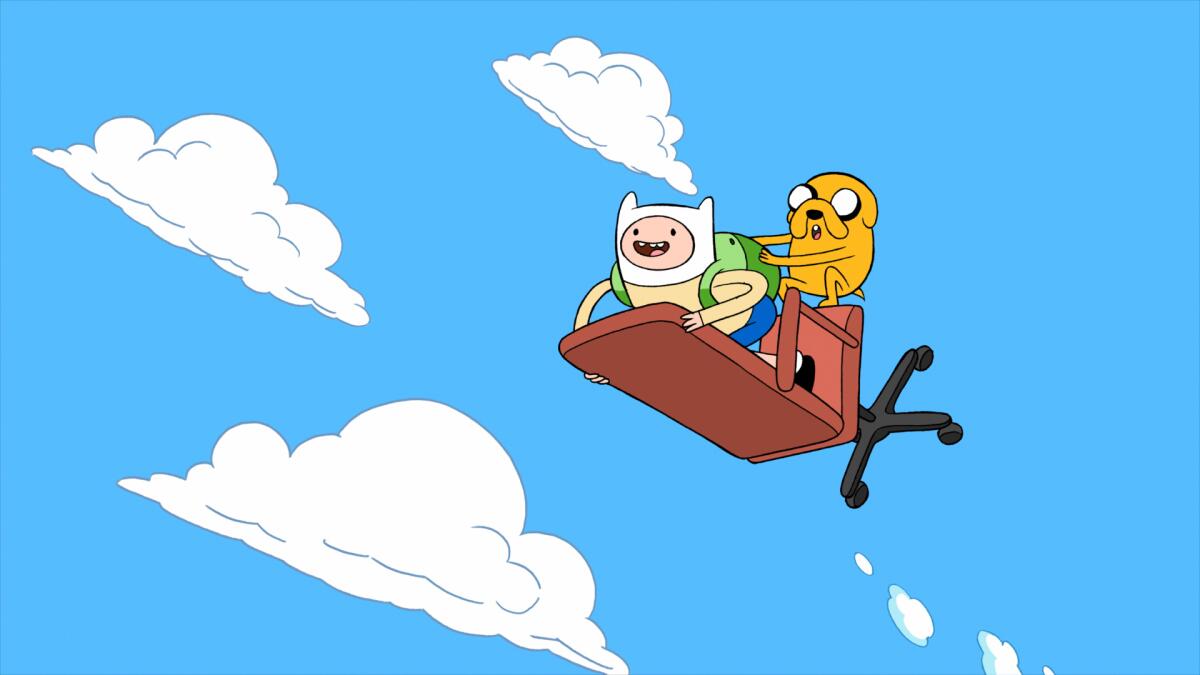
2010 | TV-PG | 10 Seasons | Kids’ TV
Created by Pen Ward
In 2010, a new cartoon premiered with these bold lines. “Princess Bubblegum,” asks Finn, a human boy, “when we bring the dead back to life, will they be filled with worms?” “No,” Princess Bubblegum replies. “If my Decorpsinator serum works, then all the dead candy people will look as young and healthy as you do.” It doesn’t quite work out for the dead — candy zombies wreck a slumber party in the first episode of “Adventure Time” — but for the living, Pendleton Ward’s animated epic becomes a cultural phenomenon with a 10-season run on Cartoon Network. Finn (Jeremy Shada) and his shape-shifting dog (John DiMaggio) began the series as romping adventurers, fighting monsters on a generally charming if often dangerous mutant Earth, about a thousand years after the apocalyptic Mushroom War. The Land of Ooo is where they live, with its Candy Kingdom, Ice Kingdom, Flame Kingdom, Nightosphere and Lumpy Space, each with its issues, its creatures, its customs, its king or princess. The series developed over time, from a story of sword-swinging amateur heroics into one more concerned with family and friends and affections; it is spiritual in a way that doesn’t deny the power of broken wind. The comical bumps up against the chaotic, the domestic beats back the dreadful. “Adventure Time” will make you laugh and break your heart. (Read more) —Robert Lloyd
14. The Last of Us

2023 | TV-MA | 1 Season | Post-apocalypse drama
Created by Neil Druckmann and Craig Mazin
Survival is the name of the game in HBO’s “The Last of Us,” a nine-part drama based on a beloved video game about the end of the world. A parasitic fungus has turned much of the human population into blood-sucking zombies, leaving the rest of humanity to fight off the infected — and to battle each other for whatever precious resources are left.
If this post-everything premise sounds familiar, that’s because it is: “The Walking Dead” and its spinoffs, “Station Eleven,” “Sweet Tooth” and dozens of other notable series have imagined a world ravaged by plague, mutations genetic and otherwise, and more doomsday horrors that remind us how lucky we are to have made it this far into a pandemic without eating one another.
But “The Last of Us,” which premieres Sunday with a 90-minute episode, is a prestige drama based on a prestige video game, with quality distinctions that place this story in a league of its own. That’s not to say that ghoulish fight scenes are a bad thing, or that this version of “The Last of Us” is a gentle story. The living undergo a gruesome transformation when bitten by the infected and pulverizing the undead(ish) is a gory pastime. (And damn is it satisfying.) (Read more) — Lorraine Ali
13. Game of Thrones
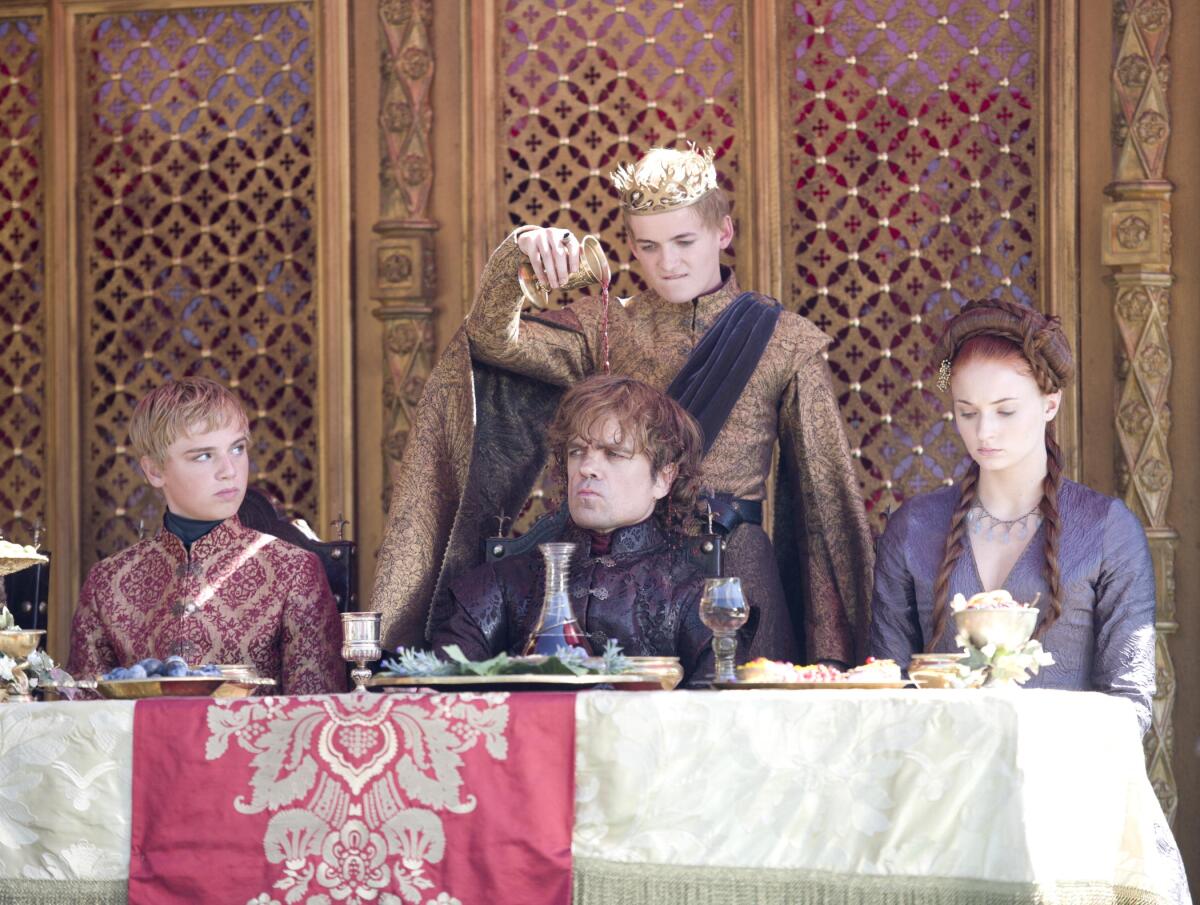
2011 | TV-MA | 8 Seasons | TV Dramas
Created by David Benioff and D.B Weiss, based on the book series ‘A Song of Ice and Fire’ by George R.R. Martin
Despite our penchant for lists, television is now so wildly diverse in form and function that any sort of ranking or award is all but meaningless. But I’m going to say it anyway. “Game of Thrones” is the Best Television Show Ever. The acting is sublime, the writing wicked sharp, the sets and camera work astonishing, and in terms of ambition, no other series comes close. With seven-plus kingdoms to manage and a literal cast of thousands this is a show so chock-full of riches that it can afford to kill two of its most beloved characters and still move forward with ruthless beauty, rigorous control and a cast unparalleled in television. Yes, there are men, mighty and fallen, though mostly an ever-shifting compilation of both. But unlike most quasi-historical fantasy epics, there are also women equally strong in their ability to stir admiration, hatred and concern. Fantasy is by far the toughest genre: to make, to sell and to sustain. If you create, as novelist George R.R. Martin has, a world in which there be not only dragons and White Walkers but pathological boy kings and murderous red witches, half-paralyzed children who communicate with three-eyed crows and dwarf princes both wily and noble, you cannot afford too many missteps. Superlatives may indeed be meaningless, but no matter how you choose to describe it, television just doesn’t get any better than this. (Read more) —Mary McNamara
12. Veep

2012 | TV-MA | 7 Seasons | TV Comedies
Created by Armando Iannucci
Armando Iannucci’s droll, fleet “Veep” stars Julia Louis-Dreyfus as Selina Meyer, vice president of the United States, and has the feel of a fly-on-the-wall documentary without being presented as one. None of the politicians is labeled with party affiliations or even a clear-cut ideology. If this is less than true to the current state of our polarized politics, this is, after all, less a show about politics than about politicking, and with a nip here and a tuck there, “Veep” might be easily refashioned into a piece about a movie producer or a restaurateur. Selina is surrounded, often literally, by an internally competitive, score-keeping staff that, in the sitcom way, doesn’t quite seem up to the job. Her helpers include Tony Hale as her hovering “body man,” feeding her situationally relevant trivia and supplying her with hand sanitizer, and Matt Walsh as a press officer who wants to know as little as possible in order to preserve plausible deniability. But she needs them too: “I think I did the right thing,” she tells them at one point, “but I just need you to confirm that I did the right thing,” and at another, she upbraids her chief of staff (Anna Chlumsky, who also appeared in “In the Loop” and is, one might say, the least tainted character here), “I didn’t have it covered, and it’s your job to know that if I say I have it covered I don’t have it covered, and you cover me.” Even if you don’t particularly feel for Selina, there is continual pleasure in watching the actress make her go. (Read more) —Robert Lloyd
11. Eyes on the Prize

1987 | TV-MA | Parts 1 through 6 of 14 | Docuseries
Created by Henry Hampton
“Eyes on the Prize”, which chronicled three decades of the civil rights movement, first aired on PBS in 1987. Created by pioneering filmmaker Henry Hampton and narrated by the late Julian Bond, “Eyes on the Prize” dramatized the civil rights movement using news footage, photographs and interviews with key participants. The first six episodes covered the decade that began with the murder of Emmett Till and culminated with the triumphant passage of the Civil Rights Act in 1965. Instead of relying on journalists, historians and other analysts to interpret the movement, “Eyes on the Prize” featured only people who’d taken part in the events being recounted — the men and women who’d marched, sat in at lunch counters and registered voters across the South, as well as those who’d stridently opposed them. Filmed at a time when many key figures of the era were still alive, the series includes appearances by activists such as Coretta Scott King and Kwame Ture (né Stokely Carmichael), as well as segregationists like George Wallace, lending it an immediacy that remains. (Read more) —Meredith Blake
10. Succession
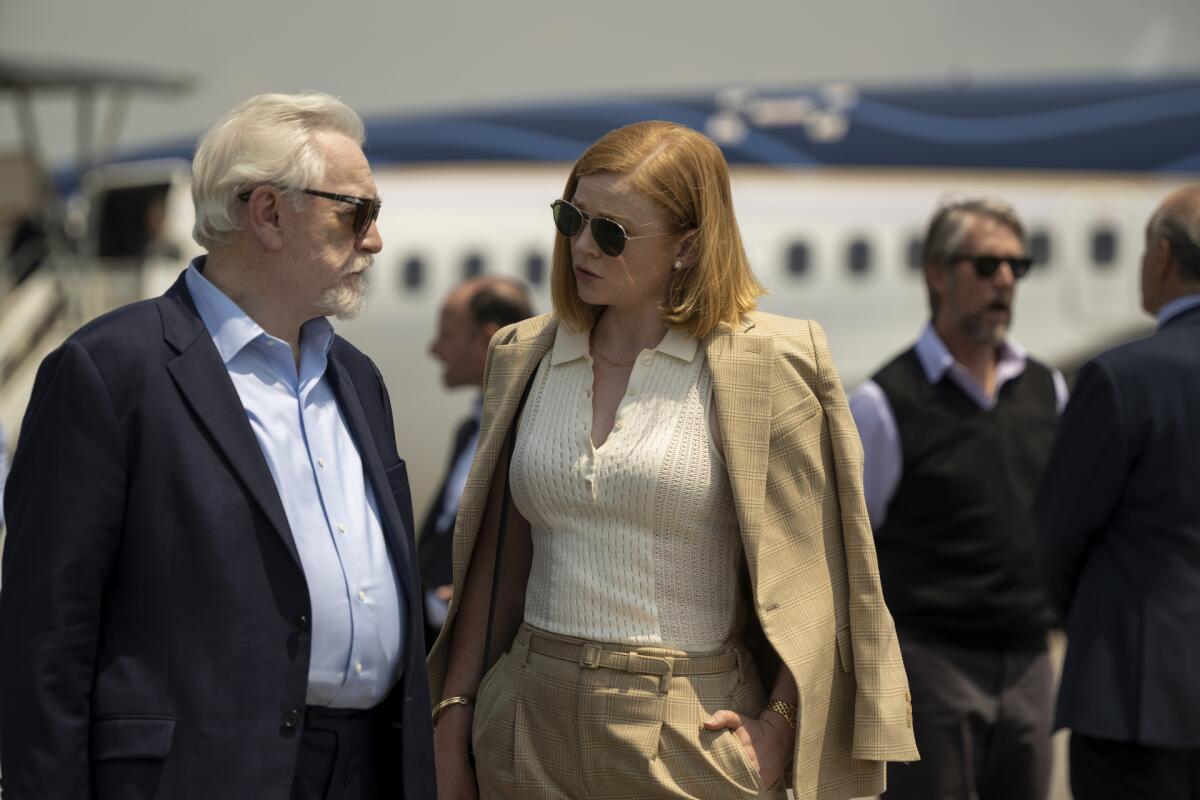
2018 | TV-MA | 4 Seasons | TV Dramas
Created by Jesse Armstrong
In “Succession,” the formidable Brian Cox (“Churchill”) plays Logan Roy, the aging head of the “fifth-largest media conglomerate in the world.” As Logan turns 80, son Kendall (Jeremy Strong) believes or has been led to believe that control of the company will imminently come to him. (He has come back from some rehab-colored time in the wilderness.) Kendall’s brother Roman (Kieran Culkin) would like to run the conglomerate’s Hollywood division. Sister Siobhan, called Shiv (Sarah Snook), works outside the company, as a political strategist of no discernible personal convictions, while oldest son Connor (Alan Ruck), from an earlier marriage, is mostly concerned with avoiding conflict and responsibility. It’s as if King Lear, on the verge of dividing his kingdom, changed his mind and decided to stick around a while longer, while his kids jockey for position or plot coups or pick flowers. But there’s no Cordelia here, no child whose love for her father, in the waning and waxing of his faculties, is simple and true and untainted by concerns of personal gain. Power is what matters. (Read more) —Robert Lloyd
9. The Comeback
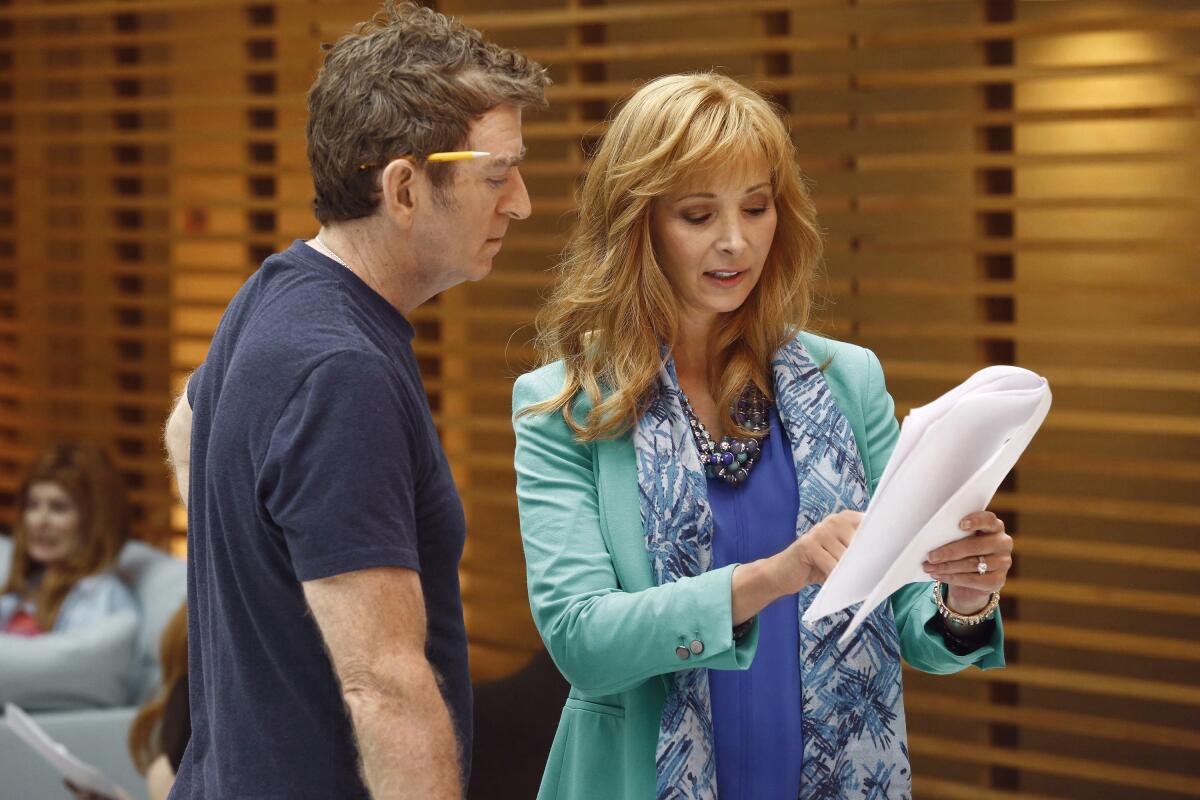
2005 | TV-MA | 2 Seasons | TV Comedies
Created by Michael Patrick King and Lisa Kudrow
In 2005, Lisa Kudrow co-created and starred in an HBO series called “The Comeback.” In it, she played Valerie Cherish, a formerly successful sitcom actress returning to television both in a new situation comedy and a linked reality show about her returning to television in a new situation comedy. In 2014, “The Comeback,” which lasted only one 13-episode season, made a comeback of its own. To pile meta- upon meta-fiction, Valerie, out of the limelight again, is creating her own pilot for a reality-show comeback when she is cast to play a character based on herself in an HBO series written by the writer of “Room and Bored,” the fictional sitcom in the first season of “The Comeback.” In some ways, it feels like the first season was made just to set up the second. But the later episodes have more weight and intensity; they come off a shade darker and yet more sympathetic to its cast of co-dependent lost souls. The fact that the returning cast — which also includes Robert Michael Morris as Valerie’s hairdresser and one-man entourage Mickey; Damian Young as her husband Mark; Lance Barber as Paulie G., the writer of the sitcom in the first “Comeback” and the HBO show in the second; Dan Bucatinsky as her publicist; and Laura Silverman as the producer she drags back to reality television — is nearly a decade older has no little bit to do with it. Time is the enemy of celebrity, and it marches on. (Read more) —Robert Lloyd
8. Watchmen
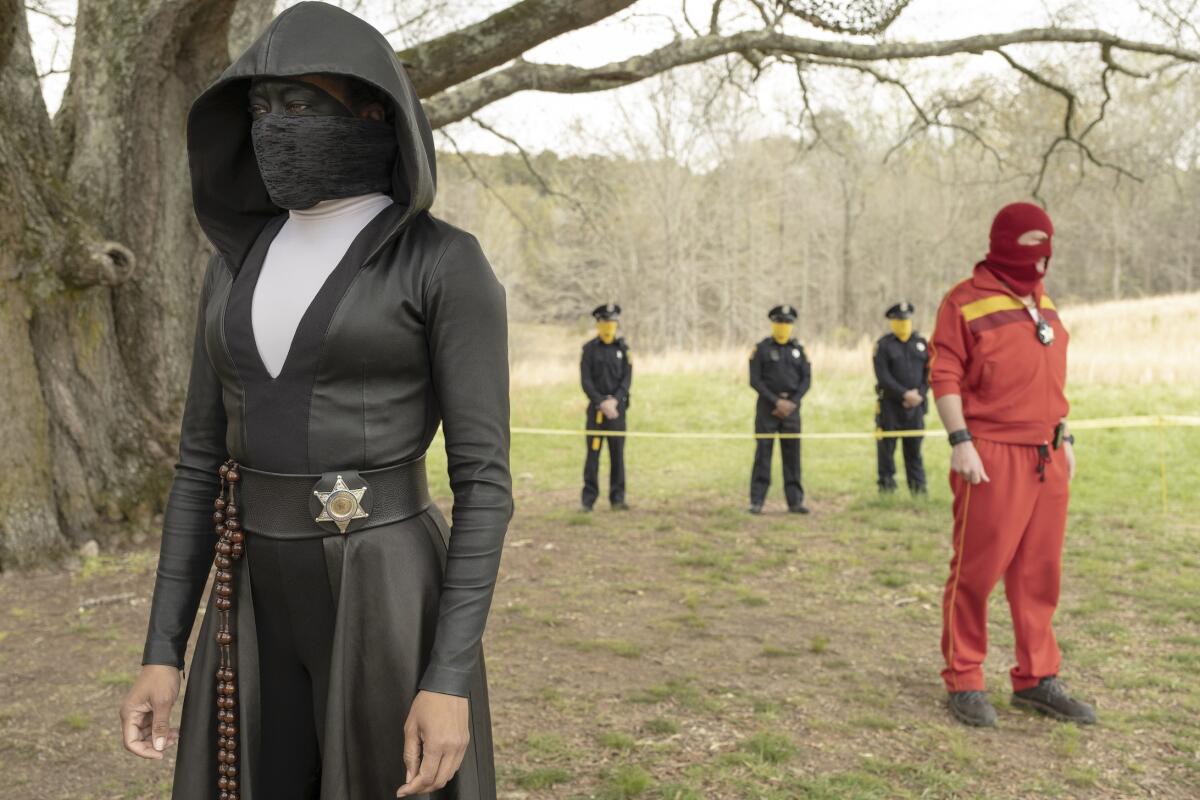
2019 | TV-MA | 1 Season | TV Shows Based on Comics
Created by Damon Lindelof
More than three decades since it first exploded onto the comic-book scene, the mere mention of “Watchmen” still sparks excitement from those enthralled by its revolutionary approach to conventional superhero storytelling. But within the sprawling alternate America of “Watchmen,” one element was noticeably absent: diversity. In the original comics and the 2009 movie, all the heroes are white, and the only person of color — Doctor Manhattan, a genetically transformed nuclear physicist — is blue. The new “Watchmen” reverses that dynamic in startling fashion, centering an African American woman, known as Sister Night, as its caped crusader protagonist, while injecting hot-button political issues — race and racism, white supremacy and police brutality against Black people — into its main plot lines. Even more striking, the fantastic world of “Watchmen,” with science-fiction-flavored elements like flying ships and raining squid, has been merged with a story arc based on historical events, one that includes horrific images of Black men and women being tortured and killed. This version of “Watchmen” takes place 30 years after the conclusion of the original. Although there are references to figures from the comics (and the movie, which follows it relatively faithfully), most of the characters and the Tulsa setting are new. (Read more) —Greg Braxton
7. Sex and the City
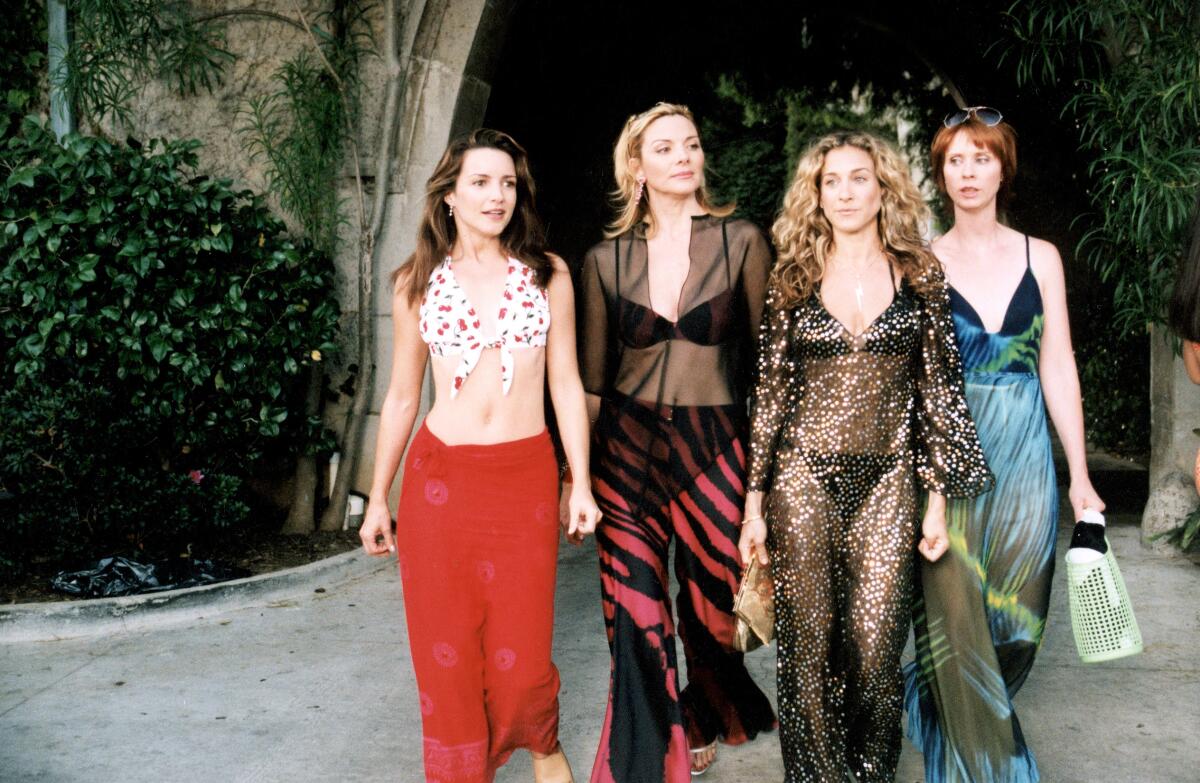
1998 | TV-Rating | 6 Seasons | TV Comedies
Created by Darren Star, based on a book by Candace Bushnell
“Sex and the City” is a via Veneto of late-’90s Manhattan singles culture, sweet jazz blowing in the background as a perfectly cast Sarah Jessica Parker plays Carrie Bradshaw, a self-titled “sexual anthropologist” who writes a New York newspaper column about her mid-30ish crowd of bed-hopping, hedonistic female night crawlers who are up to here with the attitudes of men passing through their lives. Hence, their laser intent Saturday night on “having sex like men,” which to them means sleeping with someone and feeling nothing afterward. The double-length hour premiere opens somewhat laboriously, as Carrie and the rest of her great-looking circle — Kim Cattrall as the experienced Samantha, Kristin Davis as the more romantic Charlotte and Cynthia Nixon as the hard-edged corporate lawyer, Miranda — initially coalesce into a whiny, male-bashing monolith. Unlike sex, a little bit of the first half-hour goes a long way. “Sex and the City” is as shamelessly superficial as the crowd it memorializes, but so sophisticated in its approach to shallowness that it’s also great fun. (Read more) —Howard Rosenberg
6. Enlightened

2011 | TV-MA | 2 Seasons | TV Comedies
Created by Laura Dern and Mike White
“Enlightened,” is an interesting and emotionally ambitious series. It is a satire shot through with poetry. Laura Dern plays Amy, a corporate executive who as we meet her is in the middle of a noisy breakdown, having learned that she is being transferred out of her department into a lesser one — possibly, as she loudly declares, because she has slept with her boss, though she is not the most reliable guide. Having burned her bridges, she retreats to an oceanside spiritual spa, where she meditates and communes and finally, snorkeling in clear blue waters, meets a sea turtle and sees God. She returns home with mermaid hair, loose clothing, a vocabulary newly charged with “awesome” and “amazing” and an attitude that might be described as aggressively mellow. Though she has been filled with the spirit of the turtle, she has not lost the instincts of a shark and blackmails her way back into work. But instead of the job she has imagined for herself — a community liaison to make her irresponsible employers newly responsive to the Earth — she is sent to a sort of corporate detention, where the staff (including the wonderful Timm Sharp and series creator and writer Mike White) do not so much do a job as inhabit a metaphor: A Basement of Misfit Tools. (Read more) —Robert Lloyd
5. The Sopranos
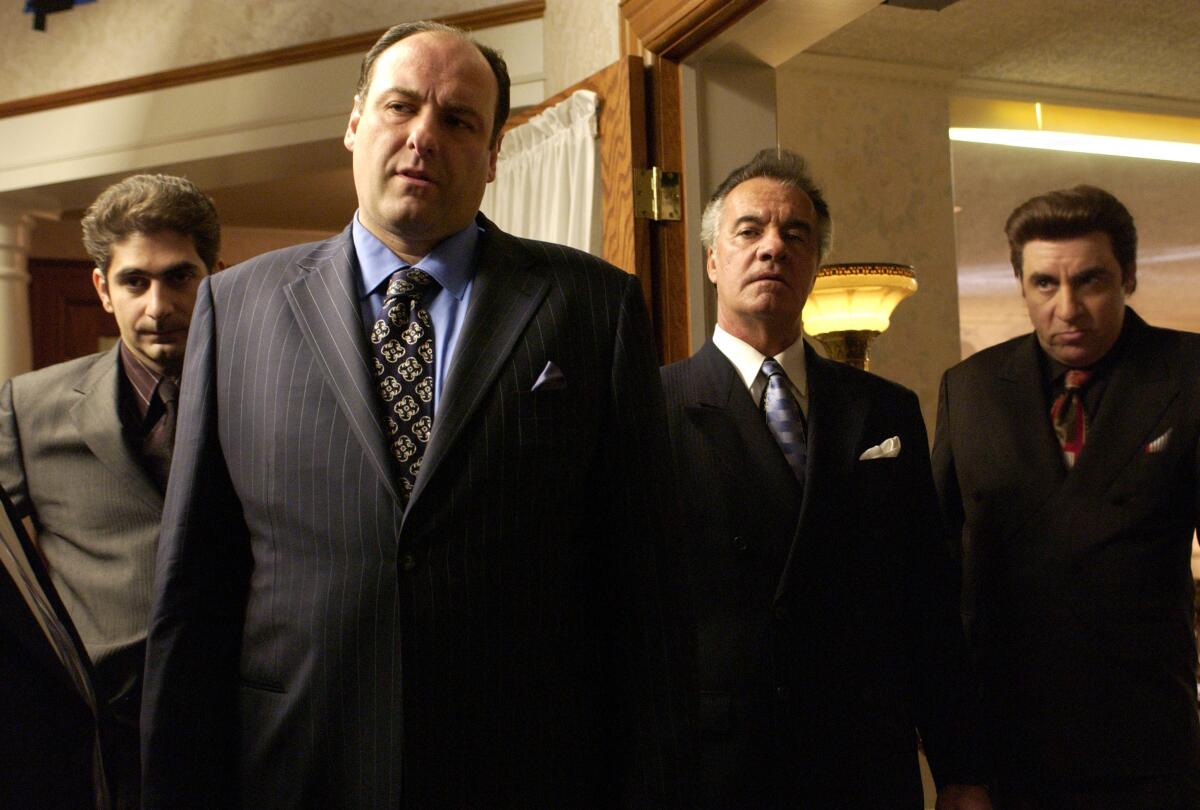
1999 | TV-MA | 6 Seasons | TV Dramas
Created by David Chase
“The Sopranos” is HBO’s raw, violent, witty, captivatingly dark hour about a complex, shrink-treated New Jersey Mafia boss beset by inner turmoil, panic attacks and as many crises at home as at the “office.” His work no longer brings him satisfaction, Tony Soprano (James Gandolfini) laments when starting therapy. Asked what he does for a living, he replies: “Waste management consultant.” Soon, though, the euphemisms fall away, heads are bashed and Tony himself is taking a battering on the home front. There are two overlapping families that drive Tony’s neuroses. One is the criminal bunch, which includes his chillingly murderous uncle and rival, Junior (Dominic Chianese), and his wildly careening hothead of a nephew, Christopher (Michael Imperioli). In the other family are Carmela (Edie Falco), the two Soprano kids and Tony’s nasty, dour, belligerent mother, Livia (Nancy Marchand), an aging widow whom he is trying to persuade to enter a retirement facility. And whom he treats royally, but is unable to please. Gandolfini and Falco are excellent, as is the supporting work of Imperioli and others. And Marchand is so coldbloodedly plausible as Livia that her eyes are ice and you can almost hear her heart freezing over. (Read more) —Howard Rosenberg
4. Insecure
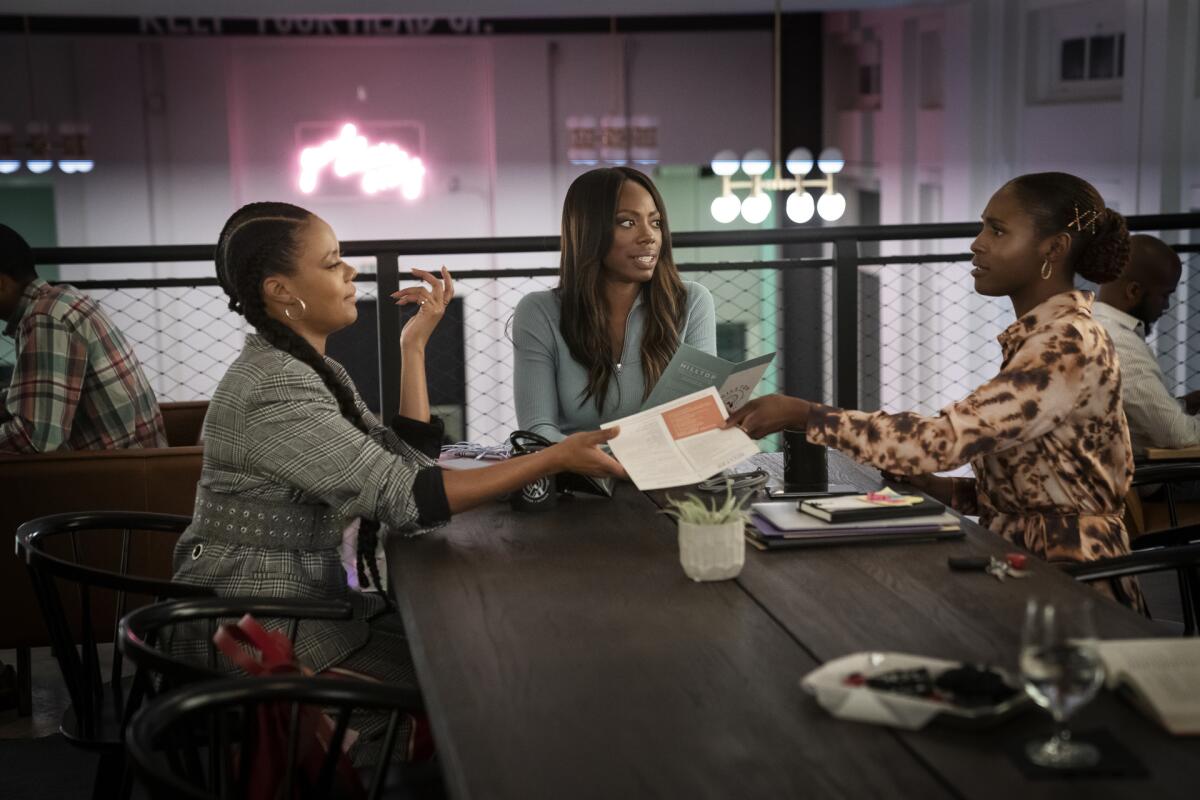
2016 | TV-MA | 5 Seasons | TV Comedies
Created by Issa Rae and Larry Wilmore
Issa Rae, the creator and star of the well-loved, much-praised YouTube series “The Mis-Adventures of Awkward Black Girl,” stars in the more succinctly titled “Insecure,” a professionalized version of Rae’s homely original that maintains her voice while sharpening everything that surrounds and supports it. Rae plays Issa Dee, whom we meet on her 29th birthday. After five years with the same boyfriend and in the same job, she is feeling stuck and wondering “how different would my life be if I actually went after what I wanted.” Her boyfriend, Lawrence (Jay Ellis), at first seems the familiar figure of the hopeless slacker, glued to the couch and forever “working on my business plan” — we don’t see him on his feet, with shoes on and out of the house until halfway through the second episode. Work-wise, Issa is the only Black person at a nonprofit, We Got Y’all, engaged in outreach to at-risk kids. The outreach is less important here than the office dynamics, which leaves Issa feeling like the odd person out even in a situation where, in one respect, she is the only person in. Though she’s regarded as “the token with all the answers,” they are disinclined to pay attention to what she says, with the exception of her work partner, Frieda (Lisa Joyce), who is eager to bond. Whenever the series seems to want to put idea before character, the characters — which is also to say, the actors, who inhabit their parts to the brim — reassert their primacy. It is easy to care about them; “Insecure” is at its grandest when it’s most intimate: Small gestures read large, domestic negotiations feel as heart-stopping and suspenseful as any encounter out of Hitchcock. There were times I had to stop the show for a minute in order to collect myself. But I always came back. (Read more) —Robert Lloyd
3. Six Feet Under
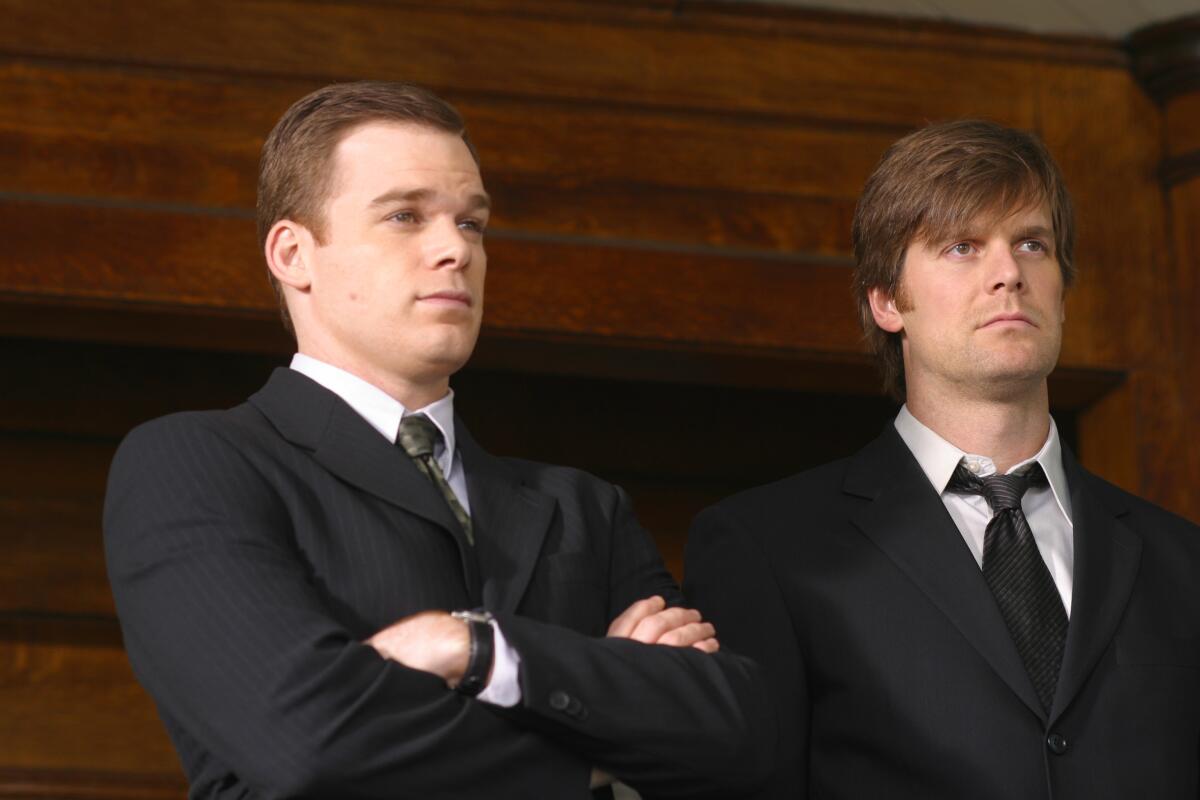
2001 | TV-MA | 5 Seasons | TV Dramas
Created by Alan Ball
At first, it seemed “Six Feet Under” was hellbent on earning its iconoclast’s badge. After all, there’d never been a TV show about a family that runs a funeral home, much less one that mixed drama with dark humor and threw in some full-frontal male nudity as a bonus. To the show’s credit, it confronts mortality as energetically as the Fisher family buries their feelings. Each episode begins with a death. Only one of the first 13 bodies destined for a slab in their basement has been an elderly person who dies in her sleep. If the corpse of the week illustrates anything, it’s that no one knows when their time on Earth will end. Naturally, death — grisly, capricious and cruel — is a constant presence at Fisher & Sons. The truth is, it is in everyone else’s life as well. Brothers Nate (Peter Krause) and David Fisher (Michael C. Hall) worry about cash flow and cope with employee problems but unlike other businessmen, their workday also includes contemplating death in all its metaphysical grandeur. David’s a repressed, closeted homosexual beginning to experiment with drugs and anonymous sex dressed in his teenage sister’s snug T-shirts. Nate, a sweet-natured lady-killer, has finally fallen in love at 35, with a sometimes tender, often maddening, and possibly insane woman (Rachel Griffiths) whose family could give Machiavelli pointers. The contrast between these odd young funeral directors grappling with their lives while dealing with people looking for answers to the great questions of existence is bizarre and touching. It is also strangely entertaining. (Read more) —Mimi Avins
2. The Wire

2002 | TV-MA | 5 Seasons | TV Dramas
Created by David Simon
“The Wire” is a scorching look at the drug trade in a Baltimore housing project through the eyes of midlevel dealers and police. Locating flickers of goodness even in street criminals and flaws in heroes with badges, this dual perspective strips back layers of complex human behavior to affirm that few of us are entirely wicked or entirely virtuous. “The Wire” has virtues galore. Its first five episodes rank with TV’s elite crime-busting hours at their best, from NBC’s late, great “Homicide: Life on the Street” and durable “Law & Order” to ABC’s “NYPD Blue.” It’s a tossup, at times, which side of the law is less admirable or more self-serving, as lines between good and evil blur in this turbulent drug arena. David Simon creates almost parallel universes in which Baltimore police and drug dealers bloody themselves in bitter turf wars and operate by chains of command, including a police bureaucracy headed by a deputy commissioner less sensitive to public need than to public relations. All in all “The Wire” is more evidence that TV’s best crime shows are in their own golden age. (Read more) —Howard Rosenberg
1. I May Destroy You

2020 | TV-MA | 1 Season | TV Dramas
Created by Michaela Coel
“I May Destroy You” is a flippant, fun, young British comedy set in the millennial flats, clubs and bars of London … or so it seems. Angelenos may see “Insecure” parallels in this group of Black friends trying to find their way in impossibly confusing times. They too have a fiercely independent sense of style, speak in social media-isms and are accompanied by a killer soundtrack. But by Episode 2 the 12-part series evolves into a full-blown mystery that revolves around solving what happened during a blackout night of drinking. And it’s anything but frivolous. Sexual assault, questions about consent, and double standards of justice around race and gender are just a few of the fraught areas where “I May Destroy You” dares to tread. The half-hour series written and produced by “Chewing Gum’s” Michaela Coel follows gregarious, eccentric writer Arabella (played by Coel) and her inner circle as they navigate careers, relationships, casual hookups and their own identity in an overpriced city that sees itself as more progressive than it really is. But their friendships take a sharp turn when Arabella decides to take a break from her writing (which she’ll do anything to avoid) and meet up with mates for a drink. The night is a blur, and she wakes up the next morning bruised, disoriented, wondering what the hell happened. Plagued by flashbacks that Arabella initially believes to be nightmares, she begins to realize she was drugged and raped, possibly by a “friend” or his acquaintances. To help put the pieces together, she relies on her close confidants Terry (Weruche Opia) and Kwame (Paapa Essiedu). Uber tracking, cellphone data and gumshoe investigation also play a part in reconstructing the chain of life-changing events. (Read more) —Lorraine Ali
More to Read
Updates
12:59 p.m. June 3, 2023: Added “And Just Like That”... and “Perry Mason.”
7:01 p.m. March 2, 2023: Added “The Big Bang Theory” and “The Last of Us”
The complete guide to home viewing
Get Screen Gab for everything about the TV shows and streaming movies everyone’s talking about.
You may occasionally receive promotional content from the Los Angeles Times.







